NEW! YOUR LOCAL RUNNING DROP
Get after it with nearby recommendations just for you.
BEST WEEK EVER
Try out unlimited access with 7 days of Outside+ for free.
Start Your Free Trial
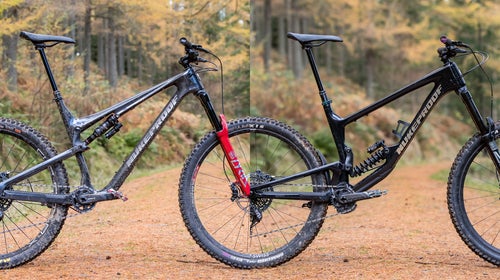

Short or Long Travel: Which Is the Best All-Around Mountain Bike?
How much slower does a modern long-travel bike climb? And what are the differences downhill?

- Share on Facebook
- Share on Reddit
Don't miss a moment of the 2024 Tour de France! Get recaps, insights, and exclusive takes with Velo's daily newsletter. >","name":"in-content-cta","type":"link"}}'>Sign up today! .
If you want one bike to do everything, how much travel should it have? All bikes have to find a compromise between climbing and descending performance, and suspension travel is usually seen as a good indicator of where a bike sits on that spectrum.
But recently, short-travel trail bikes are a lot more capable, while long-travel bikes are much better at climbing. So how much slower is a modern long-travel bike uphill? And what are the differences downhill?
Caught up in all this is the question of tire choice. How much of the difference in climbing speed between an enduro bike and a trail bike comes down to the tires? Can fast-rolling tires close the gap? And can sticky tires make a short-travel bike descend as well as a long-travel one? Let’s find out.
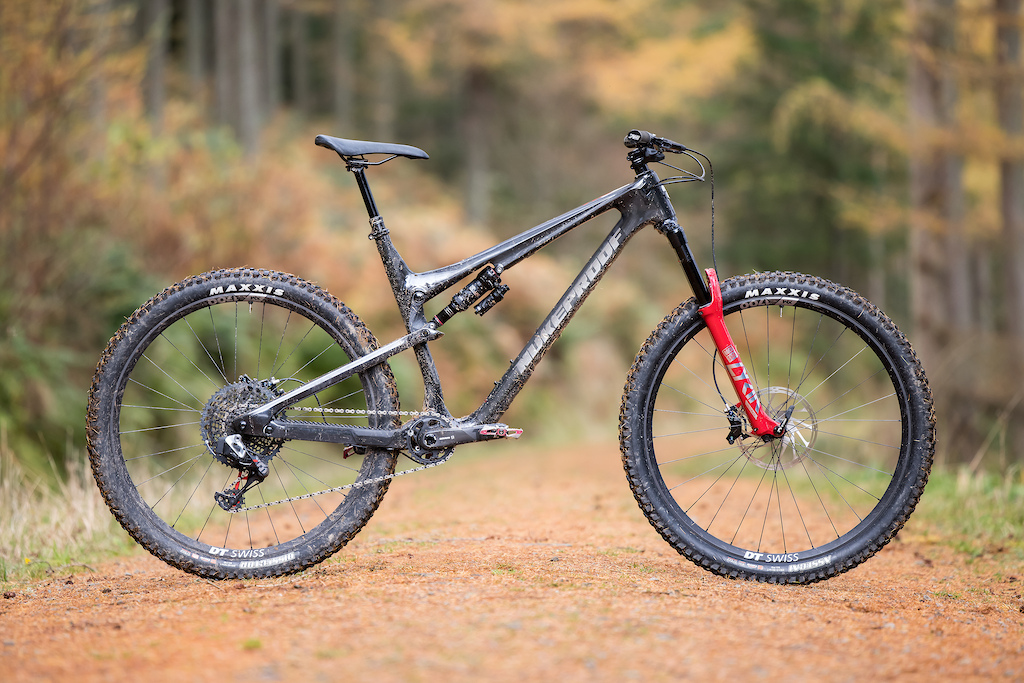
Nukeproof Reactor
• 130 / 150 mm travel • Weight as tested: 14.4 Kg / 31.7 lbs (“trail” tires, 200 mm rotors) • Size tested: XL • Price: $7,062
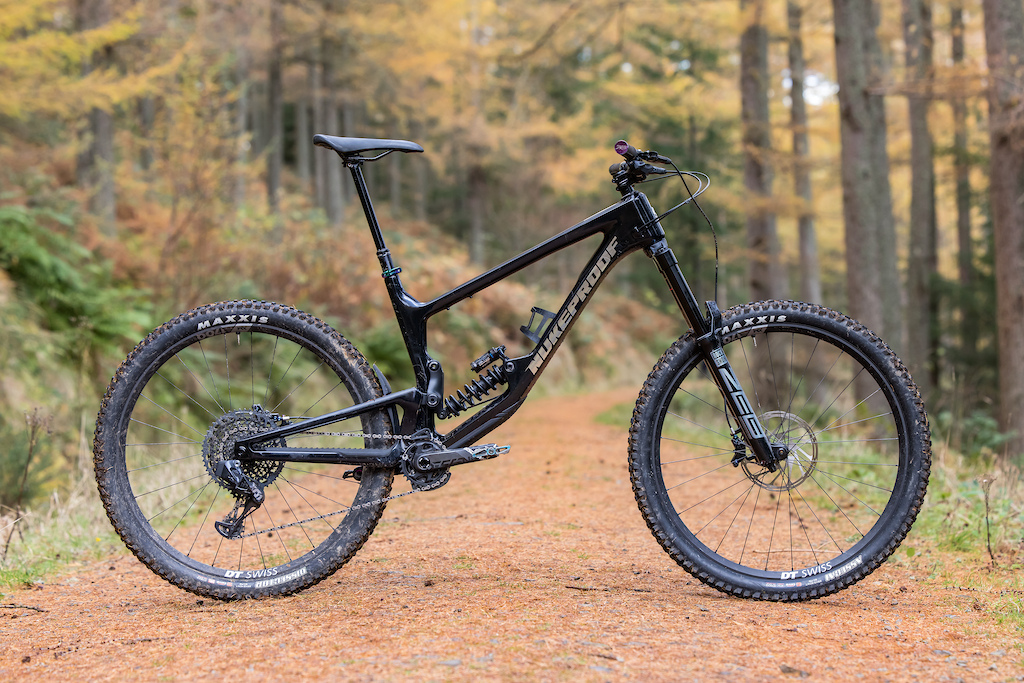
Nukeproof Giga
• 170 / 180 mm travel • Weight as tested: 15.2 Kg / 33.5 lbs (“trail” tires, air shock) • Size tested: XXL • Price: $7,415
To make things as comparable as possible, I got hold of a Nukeprof Reactor RS and a Nukeproof Giga RS. The Reactor has 130 millimeters of rear travel and 150 millimeters up front, while Giga serves up 170 millimeters (rear) and 180 millimeters (front). These models have identical brakes, drivetrains, and cockpits. With the same wheels and tires fitted, only the frame and fork are different. Both use full-carbon frames and RockShox Ultimate-level suspension. The Reactor has a Lyrik fork to the Giga’s Zeb, but the difference in chassis diameter is appropriate to the travel offered in each case.
Although the photos used here were taken with a coil shock fitted to the Giga, the testing was carried out with a RockShox Super Deluxe air shock to match the shock on the Reactor. I upgraded the rear rotor size on the Reactor to 200 millimeters so both bikes could accept the same wheels for comparative testing.
I set both bikes up with 30 percent shock sag and suspension settings as I would normally have them.
For the most part, I used the wheels that came stock on the Reactor for both bikes to remove the variable of tire choice. These tires were a Maxxis Dissector, EXO+ casing, MaxTerrra compound (rear) with a Maxxis Assegai, EXO casing, MaxxTerra compound (front). For brevity, I’ll call these the “trail” tires from now on. Fitting these tires and the air shock to the Giga dropped its weight to a respectable 15.2 kilograms – only 800 grams (1.8 pounds) more than the Reactor with the same wheels.
I also tested with a stickier pair of tires (fitted to another alloy wheelset for easier wheel swaps). These were a Maxxis Assegai in DoubleDown casing, MaxxGrip compound on the rear, with a Schwalbe Magic Mary, SuperGravity casing, Soft compound, on the front. We’ll call these the “enduro” tires. These wheels/tires weighed 600 grams more than the trail wheels/tires.
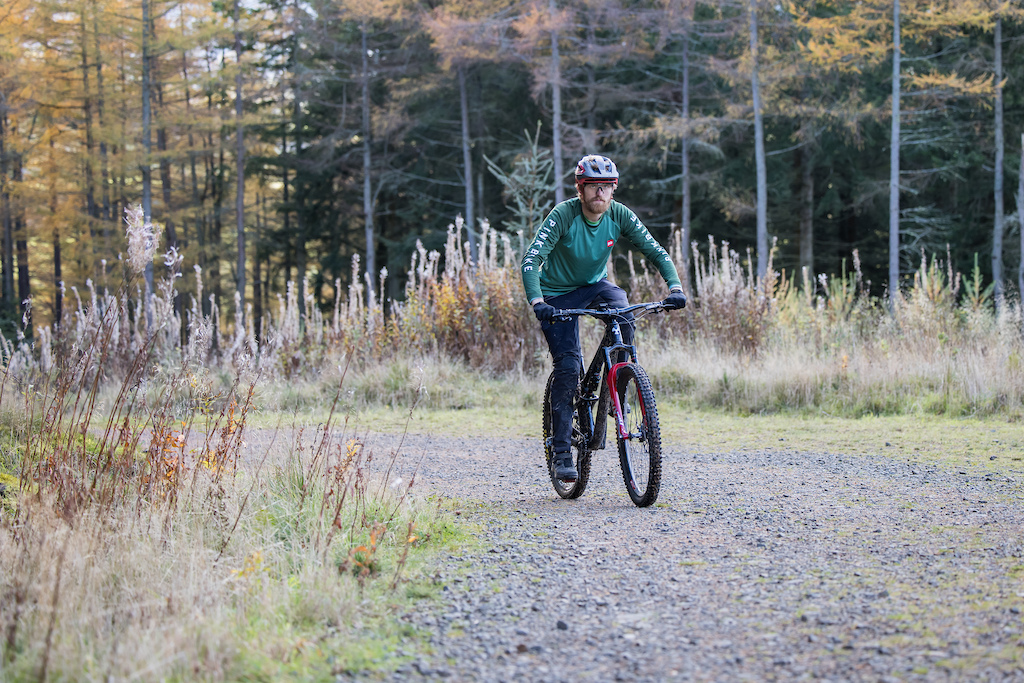
For the climbing test, I used a pair of SRM power meter pedals to control my effort, which I kept at a steady 250 watts. I rode both bikes up the same gentle and smooth fire road climb. I used a short climb so I could do five laps on each bike in quick succession and take an average. If I only did one or two longer climbs on each bike, there would be no way of knowing if any difference in times was down to the bike or just a fluke.
I did this first with the trail tires at my usual riding pressures (23 and 26 psi) then I re-tested the Reactor with the enduro tires. Here are the times:

As you might expect, the Giga was slower on average than the Reactor, but the average time was only 0.8 percent slower. Because the Reactor wasn’t consistently quicker, and the average difference between the bikes was so small, we can’t be sure from these numbers if the difference between the bikes is real or just a fluke. In science terms, the difference wasn’t statistically significant.
But even if we take the 0.8 percent difference at face value, that’s about what we’d expect from the weight difference between the two bikes alone, suggesting the travel per se (i.e. the pedaling efficiency) wasn’t having any effect.
In contrast, with the enduro tires fitted, the Reactor went 4.1 percent slower, or 3.4 percent slower than the Giga with the trail tires. In both cases, these are statistically significant differences, because the Reactor with Enduro tires was consistently slowest. To give that some context, over a half-hour climb, the enduro tires would add about one minute and fourteen seconds to the Reactor’s time. Or to go at the same pace, you’d need to produce about 260 watts instead of 250 watts; if you’re already working hard, that could be very noticeable.
The added weight of the heavier tires would only be expected to slow things down by at most 0.6 percent, so most of that difference is down to rolling resistance. This added drag will make covering ground slower on the flat and even downhills too (so long as traction and braking aren’t what’s limiting speed).
Subjectively, you can feel a little pedal bob from either bike, but there isn’t dramatically more with the Giga. The position is quite different due to the Reactor’s lower stack height and slacker seat tube angle (74.5 degrees vs. 78 degrees); this stretches out the spine which feels much less comfortable to me, especially on long climbs. Doing timed testing over technical climbs is virtually impossible because the time can vary so much from one run to the next depending on line choice, technique and luck, but when riding over bumpy terrain the Giga is noticeably smoother. The softer suspension obviously helps here but having your weight further in front of the rear axle also reduces how much your weight lifts when the rear wheel moves over a bump. Though I can’t put a number on it, I much preferred the Giga for technical climbs.

To see how they compare for descending, I chose a short local trail I know well with a good mix of roots, rocks, steep twisty sections and flat fast sections. It’s not the most technical trail in the world and it’s definitely not the roughest, but on the day of testing (which was a couple of days before taking these photographs), it was wet and slippery, making it a good challenge. To level the playing field and keep things simple, I stuck with the trail tires on the Giga and the enduro tires on the Reactor.

The Giga went first, and despite doing two laps to get up to speed on the course before getting the timer out, I shaved 2-3 seconds off my time from one run to the next. This is always a problem with timed testing. My first time on the Reactor (my fourth timed run of the day) matched the first run on the Giga. It improved from there but levelled out at one minute and sixteen seconds.
I did one more run on the Reactor with the trail tires and matched my fastest times, suggesting the stickier tires weren’t much of an advantage on this course anyway. I’m sure that on a more treacherous course—or in the hands of a rider who is better at finding the limit of grip—the enduro tires would become a significant advantage.
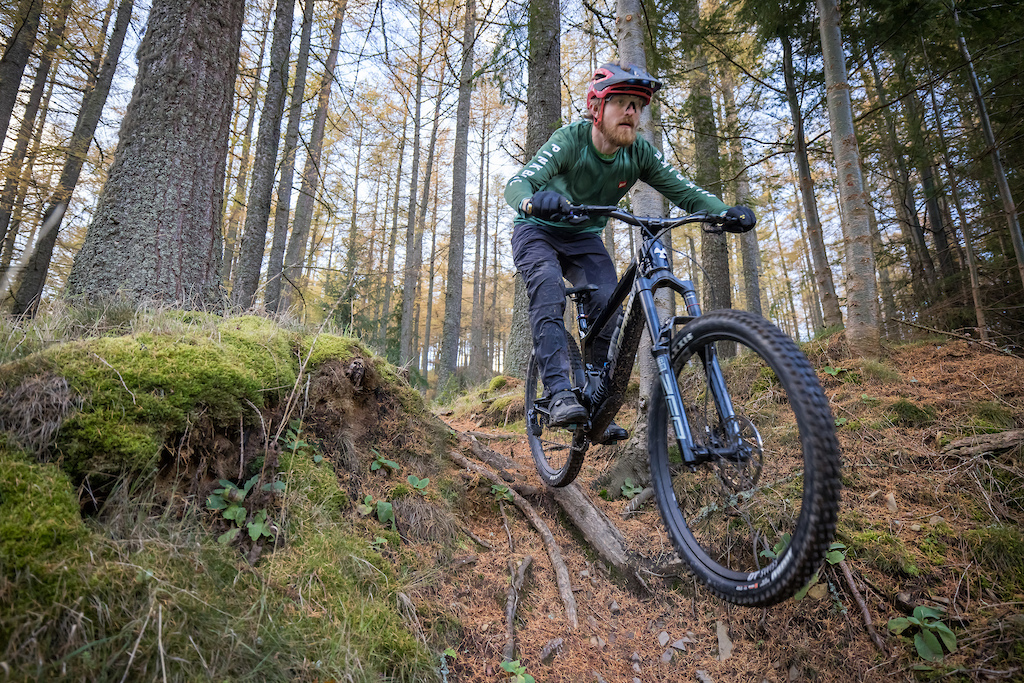
Subjectively, the enduro tires felt much more damped and surefooted and I was locking up less on the steep sections, but this didn’t seem to translate into more speed for me. Even with the sticky tires on the Reactor, the Giga felt much smoother, calmer, and more stable. The higher bar and slacker head angle combined with suspension that feels more settled “in the travel” makes going faster feel more within my comfort zone. I also felt like there was more time left on the table with the Giga, whereas the last two runs on the Reactor would be hard for me to improve on.
Because there are so many variables at play when descending, I wouldn’t read much into the times themselves. But they reveal that, although I felt closer to the edge on the Reactor, I was in fact going slower.

Closing Thoughts
The biggest takeaway for me is just how much difference tire choice makes for climbing speed. Sure, the enduro tires I tested are pretty draggy, but they’re not DH tires or mud spikes, and the trail tires (with an Assegai up front) are far from the fastest you can get. In fact, they held their own even on slippery descents.
I’m sure plenty of people don’t care about going slightly faster or feeling more comfortable on steep descents; in fact, I often hear people say they find it more fun to have a sketchier ride at slower speeds. But if that’s the case, why not fit slicker tires which will offer a real boost in climbing speed as a bonus? You could always use the lockout or run 10 percent sag if you want your enduro bike to feel sketchier! Personally, I have more fun on a long travel bike as it gives me the confidence to try new lines or ride them with more commitment.
The other surprise was that the Giga was barely slower uphill than the Reactor with the same tires, and if you want to close the efficiency gap even more you could always use the lockout.
One caveat here is that a power meter may not be the best way to measure and control effort in an efficiency test when comparing suspension efficiency. I discuss this with Mike Levy in this episode of the Pinkbike Podcast , but the bottom line is that I think the power meter method is valid for measuring efficiency when pedalling sitting down (as in this test), but it doesn’t work for out-of-the-saddle sprinting, and that’s where the extra travel is more likely to be a disadvantage.
It’s also fair to say the Reactor isn’t the fastest-climbing short-travel bike out there. But the Giga probably isn’t the most efficient among 170 millimeter+ bikes either. It’s based on a downhill bike and it’s designed to be even more gravity-focussed than Nukeproof’s Mega enduro bike. More to the point, it doesn’t have a huge amount of anti-squat , and higher anti-squat levels would probably make it climb even better. In one of Levy’s efficiency tests , the 170 millimeter-travel Santa Cruz Nomad (which has quite a lot of anti-squat) was faster than the 130 millimeter Ibis Mojo (despite having slower tires), suggesting a long-travel bike with generous anti-squat can be as just as efficient as a shorter travel one.
The bottom line is that ample suspension travel needn’t be a hindrance uphill, but grippy tires will slow you down a lot. So if you want one bike to do everything, it might make sense to pick a long-travel bike with a spare set of fast-rolling tires for mellower rides.
This article first appeared on our sister site, Pinkbike .
- Mountain Biking
Popular on Outside Online

Enjoy coverage of racing, history, food, culture, travel, and tech with access to unlimited digital content from Outside Network's iconic brands.
© 2024 Outside Interactive, Inc
- Help Center
- Chat with a Ride Guide
- 1-866-401-9636
- Retail Store
- Bike Services
Reset Password
We will send you an email to reset your password.
Don't have an account? Create an account
Create Account
Already have an account? Sign In
- Favorite your products & save them to your account
- Save a search & get notified when new products drop
- Be first to know about the latest events & promotions
Bike Finder
Results have arrived, mtb travel - how much mtb suspension travel do you need what does it mean.
Do you want more suspension travel or less? How do you know how much you need? Here's how to decide whether a long-travel or short-travel MTB is better for you and your trails.
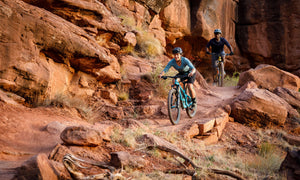
Written by: Bruce Lin
Published on: Mar 9, 2022
Posted in: MTB
You’re going to a big, important party, but you’re iffy about the dress code. Would you rather show up overdressed or underdressed?
A lot of mountain bikers face a similar dilemma, but instead of choosing the right clothes, it’s about choosing the right bike. You've probably heard certain bikes described as “too much bike” or “not enough bike.” But what does that mean?
In mountain biking, suspension travel often receives the most attention when riders are looking at bike specs. Depending on your skill, riding style, and terrain, there is likely an ideal amount of suspension travel. Other specs such as geometry , wheels , and tires matter too, but they are usually tailored to match a bike's suspension.
Most modern mountain bikes will have somewhere between 100mm and 170mm of suspension travel. This covers everything from cross-country race machines to versatile mid-travel trail bikes to hard-hitting enduro bikes . (If you want to learn more about how mountain bikes are categorized check out our Mountain Bike Buyer’s Guide .)
So what's the right amount of travel for you?
[button] SHOP MOUNTAIN BIKES [/button]
MTB travel basics: what is travel on a mountain bike?
In case you're new to riding, mountain bike suspension travel is a measurement of how much a wheel can move to absorb bumps. On the front, mountain bike travel comes from your suspension fork. At the rear, MTB travel is provided by some configuration of frame pivots that compress a rear shock.
When to choose a long-travel MTB

Long-travel bikes usually have 150-170mm of rear travel to handle tough downhill trails. Front travel often matches rear travel but sometimes can be more.
Trail and enduro bikes fall into this category. They absorb big hits and smooth out rough terrain. If you regularly ride steep or gnarly trails, a bike like this makes a lot of sense.
If you're mostly riding mellow flow trails though, a big and burly long-travel bike might be overkill. You won't be able to use all the suspension travel you paid for. The bike may feel cumbersome, maybe a bit boring, and you’ll have to expend more energy to push it around and climb uphill.
But let’s say you lack confidence on descents. A more capable enduro bike with ample suspension travel could help you enjoy riding more by increasing your confidence, comfort, and giving you more margin for error.
Some ride big and burly bikes everywhere because they're fit enough to pedal a long-travel bike up big climbs and on long rides without much trouble. For them, being overbiked isn't a handicap, and it's worth it for when the trail gets gnarly. If you care more about descending as fast as possible more than having a bike that's efficient for pedaling or climbing, long-travel bikes will cater more to your style.
[button] SHOP LONG-TRAVEL MOUNTAIN BIKES [/button]
When to choose a short-travel MTB

Short-travel bikes usually have 100-120mm of travel to maximize efficiency. In some cases, these bikes could have forks with 10-20mm more travel to make them more versatile on descents.
XC and short-travel trail bikes fall into this category. They are efficient and usually feel more agile than longer-travel bikes. If you race cross-country, do long adventure rides, or stick to mellow trails, these are the best option.
If you venture onto steep and gnarly downhill tracks with big rocks and jumps, a short-travel bike will start to feel sketchy. There’s a good chance you’ll have to ride slower and more cautiously than you would on a long-travel bike, taking easier lines and occasionally skipping tough sections.
But let’s say you dread going uphill and are constantly getting dropped by fitter riders. A bike with less travel that’s lighter and more efficient could help you go faster and expend less energy.
If you’re a skilled rider that just wants to make riding more exciting, short-travel bikes provide a lot more trail feedback and give you less room for error. You have to stay focused, be more selective about lines, and be more active with your body. For some, this can be a more enjoyable ride experience than just sitting back and letting a long-travel bike do the hard work for you.
[button] SHOP SHORT-TRAVEL MOUNTAIN BIKES [/button]
So how much suspension travel do I need?

Seth H., Merchandising Manager "I started on an XC hardtail and rode everything, even gnarly downhills on it. It had a dropper and I did just fine. I really thought it was all I would ever need. Then I went to Moab. I rode a borrowed enduro bike on The Whole Enchilada and it kind of opened my eyes. I bought a bigger bike not long after and started riding all my regular trails again. It changed how I rode.
"Personally, I really don’t mind being overbiked for most of my riding now. I ride alone a lot so I go my own pace. But I'm also decently fit and I can keep up with everyone I ride with on my bigger bike (an Ibis Ripmo). If you’re fit, I say go as big as you want."
Chad H., Warehouse Manager "I would prefer to be underbiked on the majority of trails. Being underbiked keeps the skills sharp and makes the trail an exciting challenge. I feel that being overbiked takes the challenge and excitement out of trails. It leads to laziness and dulls your skill as a rider.
"Right now for me, I believe the best bike for 85 percent of the riding I do will be a full suspension cross country bike, like the Santa Cruz Blur. I would add a dropper seatpost and Fox Step-Cast 34 120mm fork just to give it a tiny bit more capability. Or the new Trek Top Fuel, or possibly a Yeti SB100 are good options. It's what people are calling 'downcountry' now, even though I hate the term. It will be a little bit more capable than a full cross country bike, but it’ll have the same quick handling and speed. That'll be perfect for me."
What about mid-travel "quiver-killer" mountain bikes?
I always keep at least two mountain bikes in my quiver: a long-travel enduro bike and a short-travel XC bike. This lets me tackle everything from downhill bike parks to short-track XC races. But for many riders, a mid-travel trail bike is all you need.
Mid-travel bikes are a good compromise between downhill performance and pedaling/climbing efficiency. They usually have 120-140mm of travel. Many call these bikes "quiver-killers," because they can do it all (well, almost). I even spent a full season on a quiver-killer , just to see how well it worked for a wide range of riding and was pleasantly surprised by how versatile it actually was.
However, these bikes don't completely excel at anything. A longer-travel bike will be better downhill and a shorter travel bike will be more efficient for racing. Ultimately, if you can only have one bike for casual riding, or you're unsure what type of mountain bike you need for your local trails, this category is the best option.
[button] SHOP MID-TRAVEL MOUNTAIN BIKES [/button]
How to choose a mountain bike

Are your trails rough and rocky or smooth and flowy? Are they fast and steep or tight and technical? Your terrain has a big impact on bike selection. Generally, the rougher, steeper, and faster a trail is, the more travel you'll want and vice versa.
The second step is to know yourself. Your riding ambition is nearly as important as terrain. If you are a ripper who lives for downhills, you'll probably want to support yourself with more travel. But if your ride fantasy involves conquering high mountains, and exploring miles of backcountry trails, you might want to stay light and efficient with less travel.
No matter what, it's possible to have fun riding any bike, and having the ideal amount of suspension travel isn't everything. Keep in mind too that the rider is always going to make a far bigger difference than the bike. Fast descenders drop me on gnarly downhills riding XC hardtails, and fit climbers drop me on uphills riding heavy enduro machines. Good riders take what they have, and make it work.
That being said, you can always play to your strengths or weaknesses. Having a bike that enhances the parts of riding that you care about the most will make mountain biking more fun.
Are you overbiked or underbiked for your trails? Do you prefer long travel or short travel? Or do you have a bike that sits somewhere in the middle? Let us know in the comments!

Features, Latest, MTB, Tech Aug 20, 2024
FOX Transfer Neo: The Wireless Dropper Post Wars Begin

Features, Latest, MTB Aug 13, 2024
Realistic Goals Are Best: My 2024 Leadville Trail 100 MTB Recap

Features, Fun, Latest, MTB Aug 7, 2024
I'm Headed to Leadville: My Goals, Pacing Plan, and State of Mind
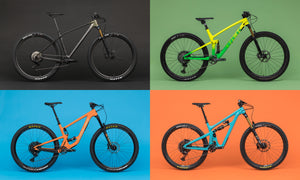
Features, Guides, Latest, MTB Aug 2, 2024
How To Choose a Mountain Bike: 6 MTB Types Explained

Features, Gravel, Latest, MTB Aug 1, 2024
Can You Race Gravel on a Mountain Bike? I Tried and It Was… Okay

Features, Latest, MTB, Opinion, Tech Jul 30, 2024
Fox Transfer Factory vs. RockShox Reverb AXS Dropper Seatposts

Guides, MTB Jul 25, 2024
Fox Vs RockShox Mountain Bike Forks & Shocks

Features, Latest, MTB Jul 25, 2024
Getting Humbled at 10,000 ft: My 2024 Silver Rush 50 Recap

Bikes, Features, Latest, MTB Jul 19, 2024
Our Specialized Epic EVO Race Bikes for the Leadville Trail 100 MTB

Features, Guides, MTB Jul 3, 2024
Race Tips from Leadville Trail 100 MTB Finishers
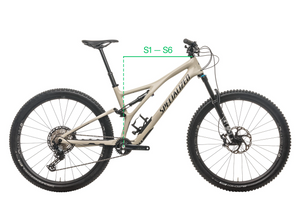
Guides, MTB Jun 18, 2024
How Specialized S-Sizing Works, and Why It's Kinda Genius
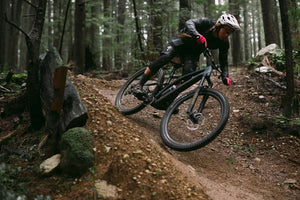
Features, Guides, MTB Jun 17, 2024
Specialized Stumpjumper by Year: How to Buy A Used Stumpjumper
New arrivals.
Labor Day Deal

Certified Pre-Owned
Canyon Grail CF SL 7 Gravel Bike - 2024, Medium

Cervélo Áspero-5 Red XPLR eTap AXS 1 Gravel Bike - 2022, 48cm

Cervélo Caledonia-5 Ultegra Di2 Road Bike - 2022, 61cm

Trek Checkpoint SL 5 Gravel Bike - 2022, 52cm

Revel Bikes Rail GX Eagle Mountain Bike - 2021, Large

Cervélo Áspero Apex 1 Gravel Bike - 2023, 54cm

Specialized Diverge Carbon Gravel Bike - 2021, 56cm

Revel Bikes Rail29 X01 Eagle Mountain Bike - 2023, X-Large

Lynskey R500 Road Bike - 2021, X-Large

Quintana Roo V-PR Dura-Ace Di2 Triathlon Bike - 2022, 50cm

Cervélo S5 Red AXS Road Bike - 2024, 48cm
$7,941.99 $8,799.99

Specialized S-Works Diverge Gravel Bike - 2021, 54cm
$6,226.99 $6,899.99
- Register New User
- First Looks
- Friday Fails
- Community Blogs
- Fantasy League DH
- Places Directory
Ask Pinkbike: Long-Travel vs Short-Travel Trail Bike, Measuring Fork Stiffness, Heavy Tires or Inserts?


Cool Features

The Best Short-Travel Trail Bike – 6 Mountain Bikes in Test

Bikes are growing increasingly versatile, lines are blurring and long-travel bikes are climbing more easily and faster than ever before. But does that mean that short-travel trail bikes are growing more potent on the downhills too?
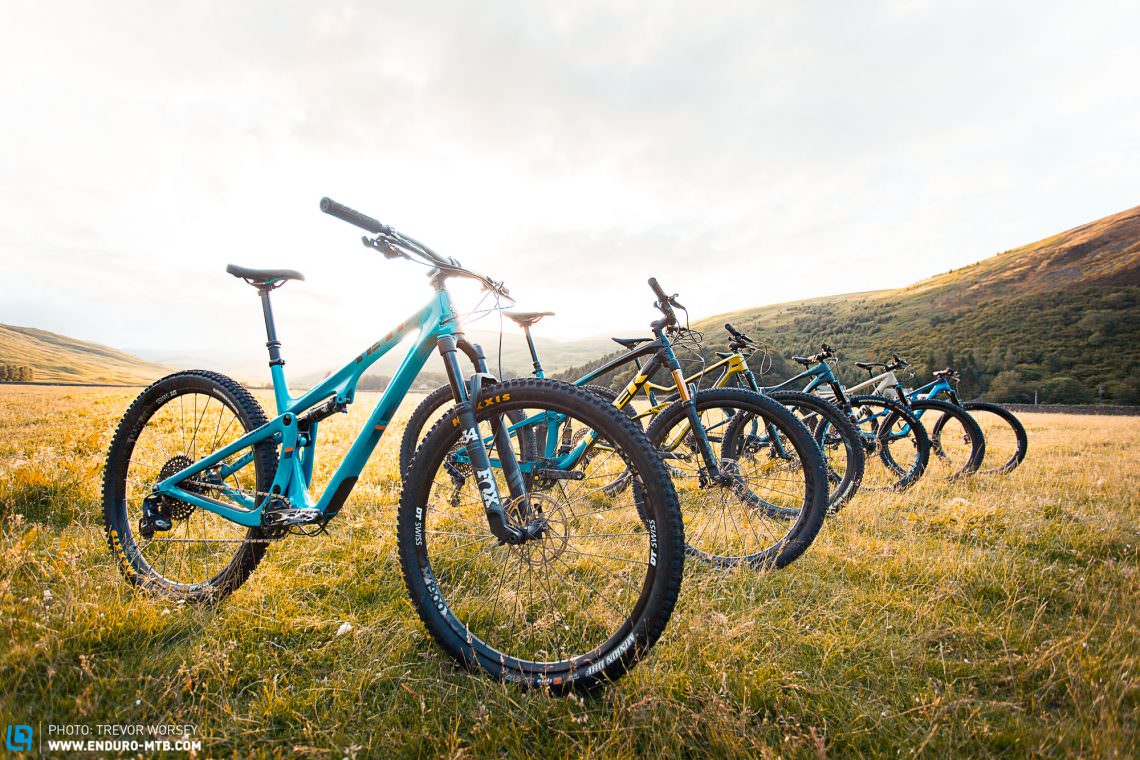
Our trail bikes are changing. We now have suspension kinematics that minimise pedal bob, while maximising big-hit fun. Seat tubes are growing steeper so we can climb better and bikes are growing increasingly lighter. The latest generation of 140–150 mm trail bikes have become the holy grail of do-it-all machines. So why do manufacturers still offer short-travel trail bikes? Is there a benefit to bikes with 130 mm or less travel? Are we missing something? So many questions. It’s time for some answers.
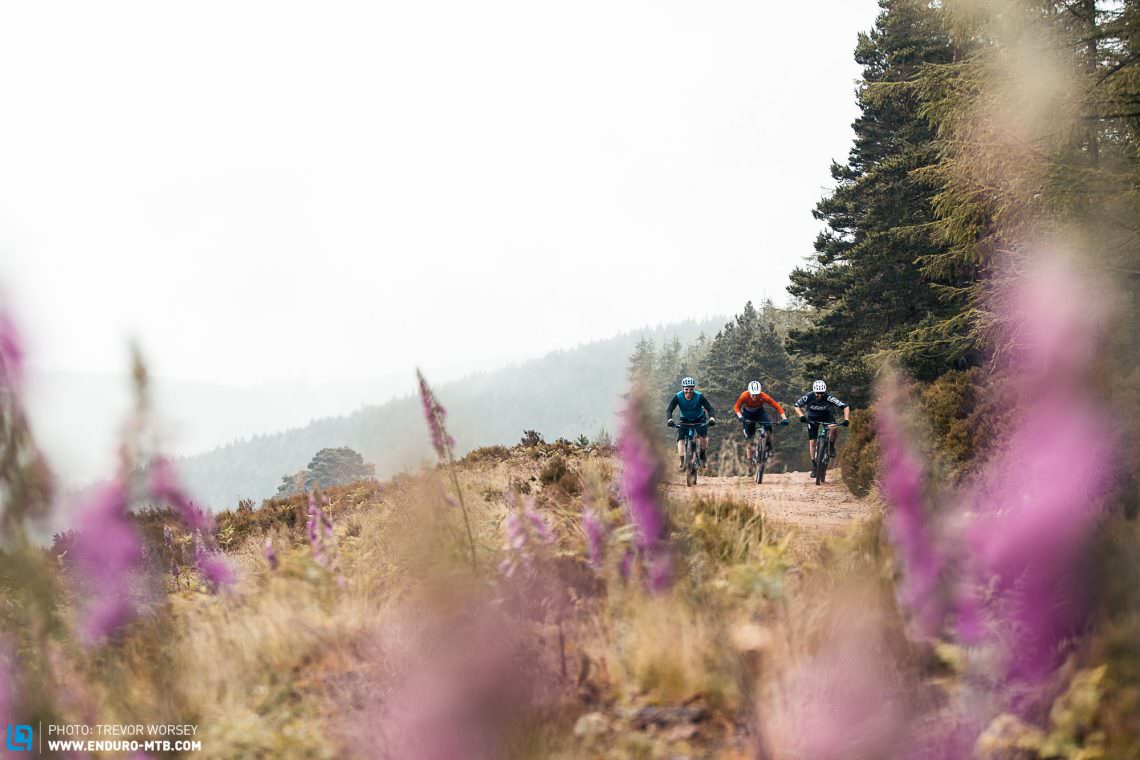
Does short-travel mean less fun?
Does short-travel mean less fun? No way! If your local mountains are more like molehills, and your Sunday ride involves long connections between the trails, a short-travel bike will be a quick-riding passport to adventure and endless fun. On flow trails, a short-travel bike will pump faster through compressions and stay higher in its travel, rewarding you with more smiles and heaps of excitement. On many rides, carrying extra travel only dulls the sensations and feedback from the trail, meaning less agile and engaging handling than a well designed short-travel bike can provide. While a 140–150 mm trail bike is a great choice for many riders, the best bikes in this test show it’s important to choose a bike based on where and how you want to ride, rather than just numbers on a spec sheet.
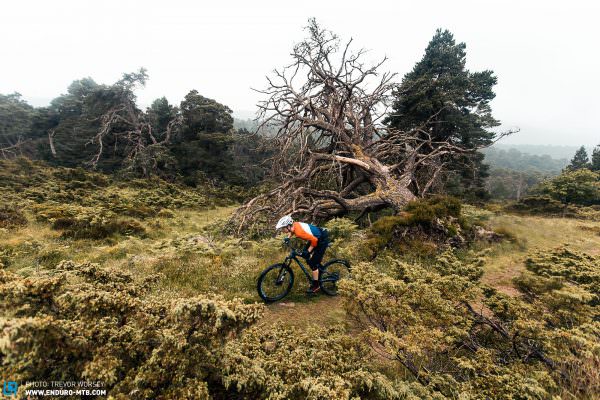
Imagine driving a Dodge V8 and a stripped out rally hatchback down a tight-twisty road. We can guarantee you’ll have more fun in the lighter, more agile rally car.
The short-travel trail bikes in this group test
For this group test, we wanted to include a diverse selection of bikes at a range of prices. On paper, all six bikes share similar geometry (with one exception) and range of application. All are 29ers, a wheel size that best suits the kilometre eating, corner railing nature of a good short-travel bike. The Specialized Epic EVO and Trek Top Fuel both mark a step up in versatility from dedicated XC race machines. They essentially take a racing platform but slack and stretch it out. The Whyte S-120C enters from the opposite end of the spectrum, packaging an enduro bike ethos in a short-travel chassis. Sitting in the middle, the Canyon Neuron, Merida ONE-TWENTY and Yeti SB100 are purpose built to be good at everything from marathon epics to fast laps of your local loop.

Suspension kinematics are important
The saying “It’s not about the size, it’s about how you use it” has never been more apt. With short-travel bikes, progressive suspension kinematics are essential. With less to play with, the suspension needs to maintain control and can’t give up all its travel too quickly. For active riders, the Merida ONE-TWENTY, Trek Top Fuel and Whyte S-120C excel with a supportive kinematics that give just enough travel to smooth out big hits and almost always retaining some reserves. The result is that these bikes provide massive support for pumping to generate free speed from the trail and also provide lots of feedback from the trail. In contrast, the Canyon Neuron and Yeti SB100 have more linear kinematics, sacrificing a little mid-stroke support in pursuit of comfort and control through rock gardens, as well as boosting comfort and reducing fatigue on longer rides.

Be suspicious of a low weight on the spec sheet
If you think that less travel equals less weight, you might have to reconsider. Given how hard we ride our bikes, both short- and long-travel bikes will actually require very similar components and in turn, it becomes hard to cut down weight without significant compromises in performance.
No matter if you have 100 or 150 mm of travel, you’ll still be riding effectively the same suspension units, need the same high-performance tires and will want to be able to brake just as quickly. Many brands make compromises to lower their bikes’ weight, saving a few grams on the scales by fitting inferior components. Brakes are often an easy and not immediately obvious downgrade. Fitting delicate 160 mm rotors on the rear and specifying smaller callipers might save 200–300 g, but the brakes still have to slow down the mass of a hard-charging 80+ kg rider. Do you ride a flow trail slower than an enduro trail? We don’t. Merida is the only brand to get this right, fitting powerful SRAM Code RSC brakes to their ONE-TWENTY. Tires are the next place to cut weight. While short-travel trail bikes do not need to come fitted with super heavy downhill casings, we still expect to see a versatile, capable and above all durable tire.
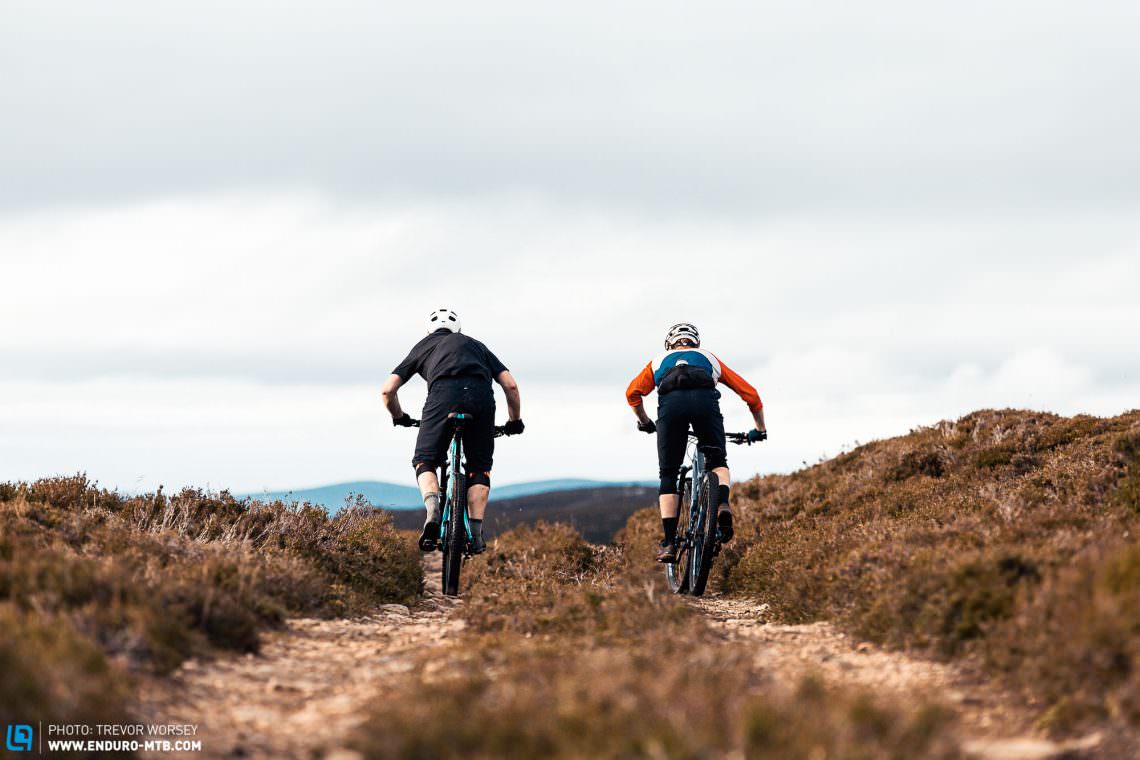
Carbon vs Aluminium Wheels
You can have a lighter bike without performance compromises but it will come at a cost. Spending more allows manufacturers to fit better components that reduce weight while maintaining or even improving performance. We are generally big fans of aluminium rims, especially on harder hitting bikes where they are more affordable if damaged and offer a smoother ride feel. However, lightweight carbon rims accelerate quicker and give the bike a more lively and agile feel, properties that in our test enhance the ride of our short-travel bikes. The Merida ONE-TWENTY 8000 scores well here, saving over 400 g on the combined wheel weight (4.38 vs 4.79 kg) when compared to the Yeti SB100 fitted with similar all-round tires. The Trek Top Fuel and Specialized Epic EVO both have very lightweight wheelsets, but also ‘cheat’ a bit by fitting lighter but less durable and versatile tires for combined wheel weights of 3.94 and 4.02 kg respectively.
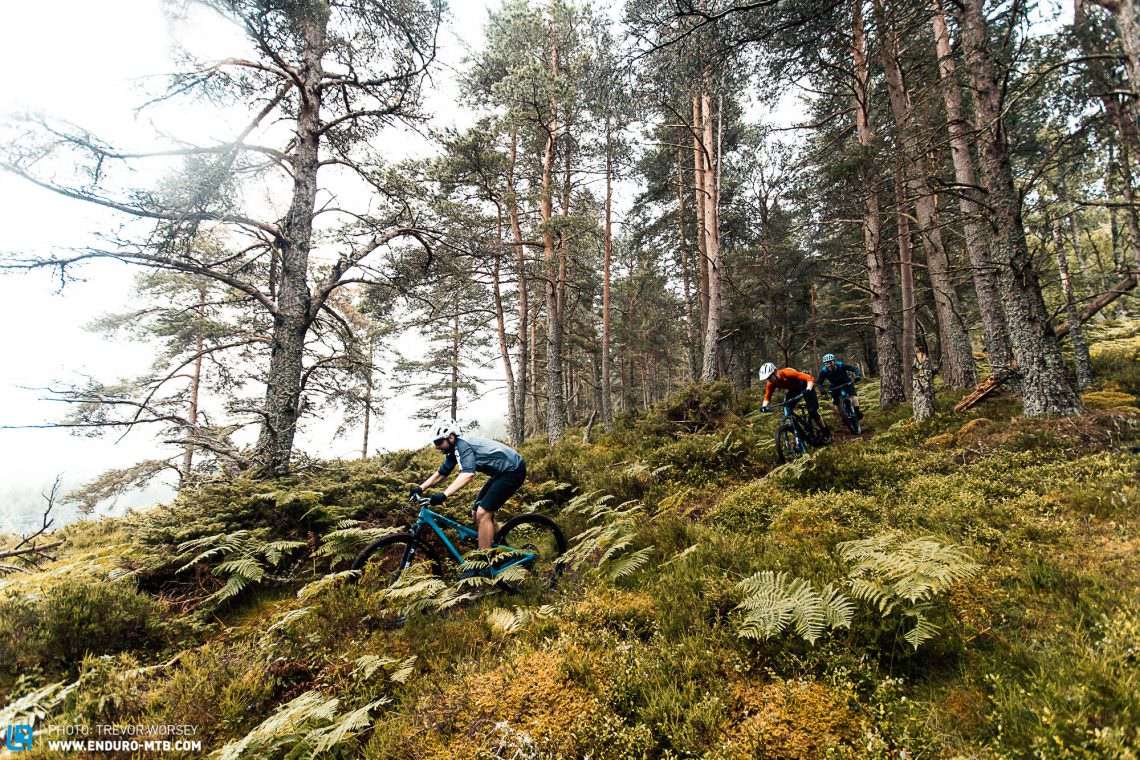
These bikes are made to climb fast so why don’t they have steep seat tubes?
This is a great question and one that consumed our team during much of our testing. The bikes in this group test have an average seat-tube angle of 74.8° , making them slacker than the latest geometry trends in trail and enduro bikes. The Merida again takes the win with a 75.5° seat tube angle, but still falls short when compared to the latest enduro bikes. Take the Yeti SB100: its 74° seat tube angle is far slacker than the newer and longer travel SB130 and SB150 which both have 77° effective seat tubes. It’s true that short-travel bikes sit higher at sag than long-travel bikes, reducing the effective seat tube angle less, but could they learn a lesson in efficiency from their bigger brothers? Yes, they could. All the bikes in this test climbed better with the saddle far forwards on the rails, indicating that slightly steeper seat tubes would benefit overall pedalling efficiency. We hope that short-travel bikes follow the steep seat tube trend that is sweeping through the trail and enduro sector.
Tops & Flops
Often small details can make a huge difference: seamless integration, first-class ergonomics and carefully selected parts. Easier said than done – here are some of the tops and flops from this grouptest.
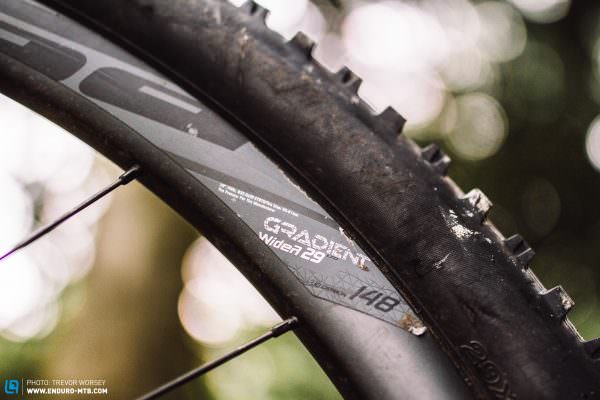
How we tested the bikes and where?
We packed the bikes into the back of a van and headed to the amazing trails of Ballater in the Scottish Highlands. Ballater is the hidden gem of Scottish riding, offering long flow trails, gruelling ascents and an iconic fast and furious ridgeline descent that is the perfect test of a short-travel ripper. We braved the Scottish midges and challenging weather conditions to push the bikes hard. Parts broke, tires were slashed but great fun was had. For a more thorough test of the bikes’ downhill performance, we also challenged them hard on shuttle assisted runs in the notorious Innerleithen bike park.
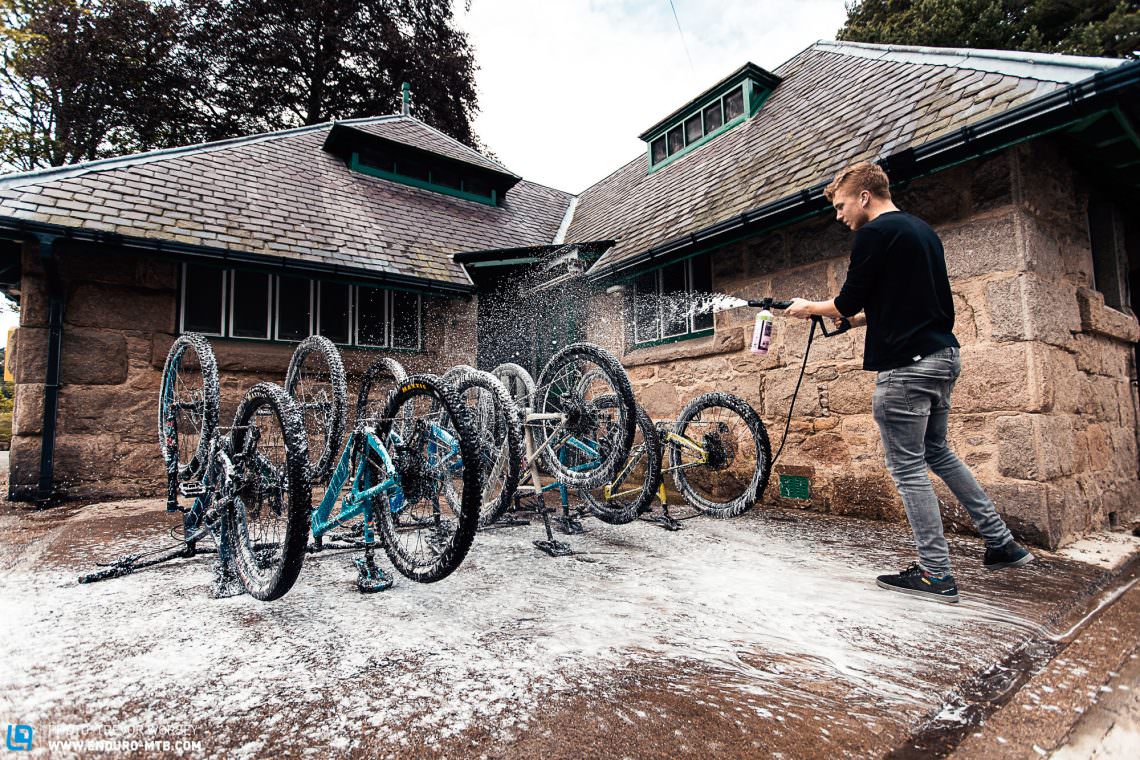
The test team

Six bikes with six very different personalities left us with many surprises. After extensive testing, the biggest surprise has been just how versatile short-travel bikes have become. Yes, many of the tires lacked grip and the brakes were weaker, but we soon found ourselves effortlessly straying onto full-bore enduro trails. The second surprise is just how much fun short-travel bikes are to ride. After-work rides become longer and big climbs are relatively speaking effortless. Staying high in their travel with supportive suspension, they turn even the most boring trails into a playground. Every compression is the opportunity to pump for more speed and every bump becomes the lip of a jump. If your trails are more flow than gnar, you’ll have more fun and smiles on a short-travel bike.

When it came to choosing our favourites, it was a tough call. With an XC oriented build kit, the Specialized Epic EVO was a beast on the climbs but it felt least at home on variable terrain. We also weren’t completely convinced by the Micro Brain shock, especially the noticeable delay before the inertia valve opens the compression damping under compression. The Canyon Neuron is the polar opposite: linear and efficient it would make a perfect bike for comfortable long tours but lacked spark when pushed to the limit. As is usual for Canyon, it does represent excellent value for money though. The Whyte S-120 C is the fastest bike on challenging terrain, where its progressive geometry and capable build kit give it an advantage that can be measured in seconds on the descents However, the uncompromising enduro specification and heavier wheelset is noticeable on the climbs when chasing the best in this test.
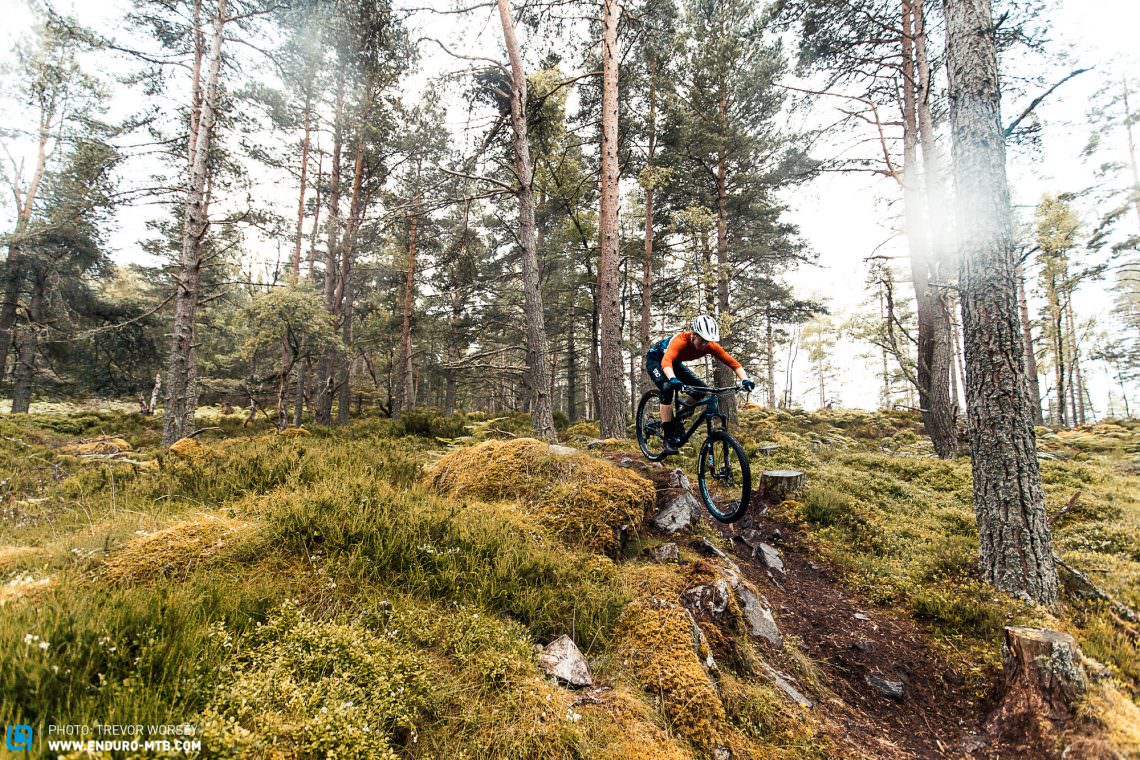
It was almost impossible to separate the top three bikes with all of them receiving high praise from the testers. The Trek Top Fuel is a testament to a new way of thinking. Potent, versatile and fiercely competitive, we can’t think of many situations where it would not excel. It was only the increased complexity of the TwistLoc (a grip shifter style suspension lockout) and the weak brakes that pushed it off the top spot. The Yeti SB100 was also a team favourite, blending effortless ground-covering efficiency with an easy-going playfulness that delighted all our testers. With a beautiful frame that deserves upgraded components, it’s a bike that we would be proud to own. For the first time ever, a Yeti takes our Best Value award. That leaves the Merida ONE-TWENTY : a versatile trail rocket that happily went everywhere and anywhere we took it. With a faultless build kit, great brakes, great suspension and an agile and engaging ride that will delight riders of all experience levels, there is nothing to fault, giving it the well-deserved Best In Test award.
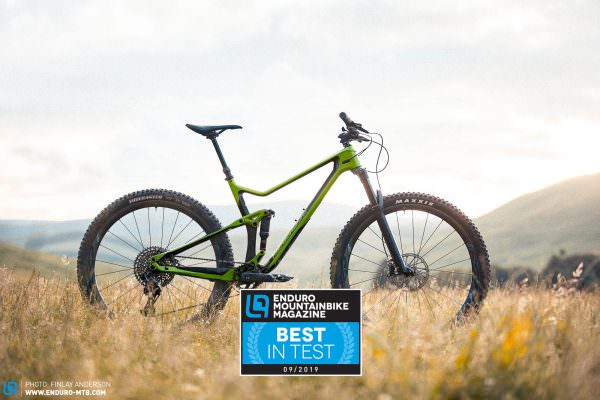
All bikes in test: Canyon Neuron CF 8.0 | Merida ONE TWENTY 8000 | Specialized Epic Expert Evo | Trek Top Fuel 9.9 | Whyte S-120C RS | Yeti SB100 C GX
If you’re looking for a bike with more travel you should definitely check our test about the best enduro bike of 2019: The best enduro bike you can buy
This article is from ENDURO issue #040
ENDURO Mountainbike Magazine is published in a digital app format in both English and German. Download the app for iOS or Android to read all articles on your tablet or smartphone. 100% free!

Did you enjoy this article? If so, we would be stoked if you decide to support us with a monthly contribution. By becoming a supporter of ENDURO, you will help secure a sustainable future for high-quality mountain bike journalism. Click here to learn more .
Words & Photos:
You may also like

Exclusive test: 2025 AMFLOW PL Carbon Pro – What is AMFLOW’s eMTB...

Baby instead of biking? – How bike parenting can keep the wheels...
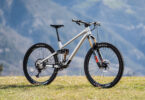
Last chance! ENDURO reader survey 2024 – Win a RAAW Jibb V2

First ride on the new 2025 Propain Spindrift 5

FOX electric gold – The new 2025 FOX Transfer Neo Factory 2025...

Santa Cruz Bronson 2025 – Santa Cruz’s new all-round weapon for...
Best down-country mountain bike: short travel shredders
- Danny Milner
- January 10, 2024
Short on travel but big on geometry, we review the best down-country mountain bike rigs – fleet-footed steeds that blend the speed of an XC bike with the capability of trail bike.

Trek Top Fuel 8 Credit: Roo Fowler
Short on travel, light on weight, but big on geometry, the best down-country mountain bike rippers give you everything you want and nothing you don’t. Fast and fun, in a lightweight, efficient package, these bikes can cover ground with minimal fuss and still be thrashed to within an inch of their lives on proper trails.
- Best mountain bikes: hardtail, XC, trail and enduro to suit all budgets
- Best cross-country XC mountain bikes
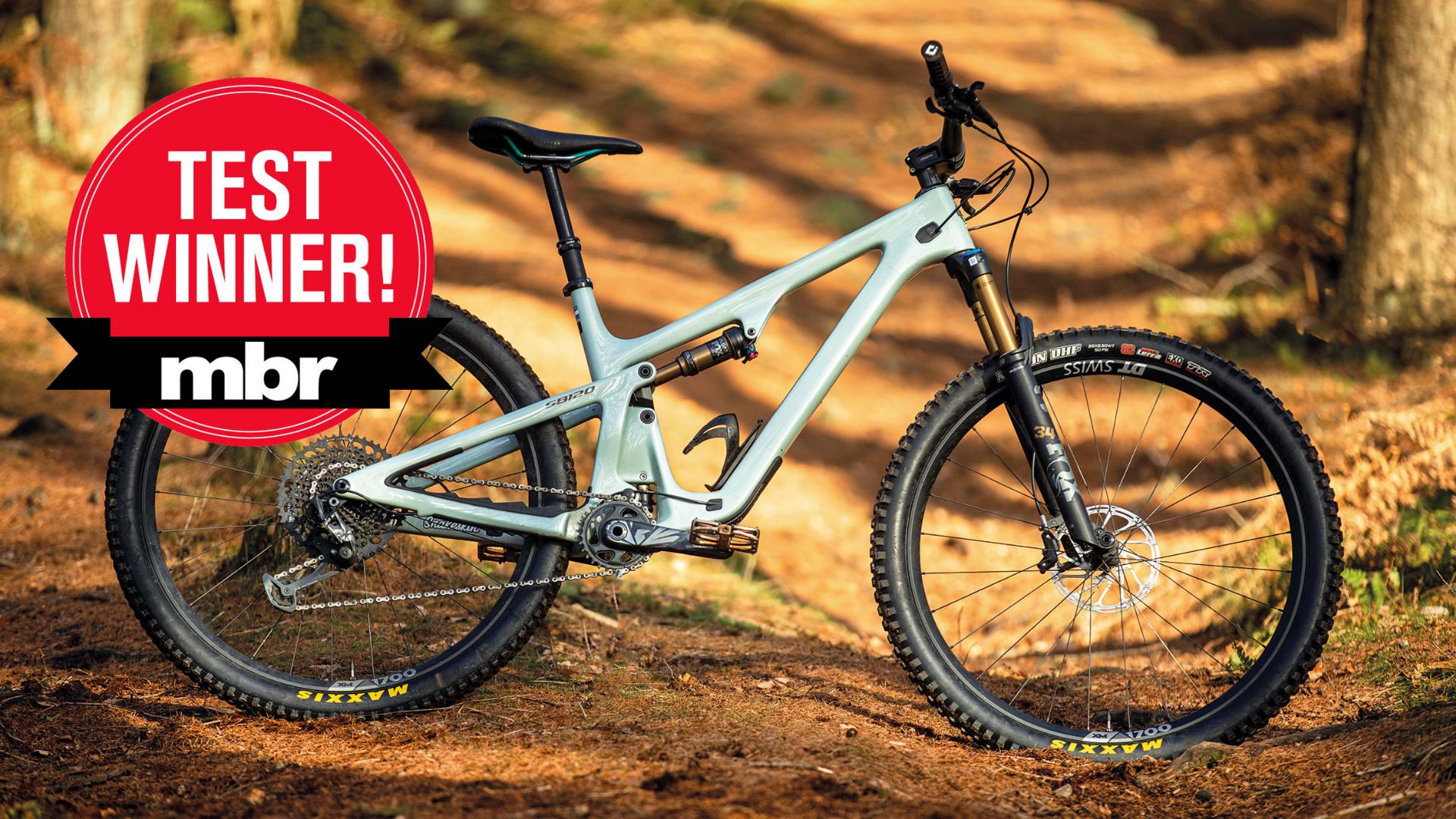
The Yeti SB120 is a down-country bike you can buy with your head as well as your heart
1. Yeti SB120
The best down-country bike if money is no object.
Wheel size: 29in | Frame: Turq carbon, 120mm | Sizes: XS, S, M, L, XL | Weight: 13.3kg (29.3lb) | Rating: 9/10
Reasons to buy:
- All round overachiever with superlative suspension
- Wide size range
Reasons to avoid:
- Agile rather than ultra aggressive
- Not actually that light
- No internal storage
From one of the most aspirational brands in the business comes the impeccable SB120. Yeti shrinks and shoehorns its unique Switch Infinity suspension design into the SB120 chassis. Where the swingarm moves up and down on dual Fox shafts just above the bottom bracket. And the new design has improved seals, bearings, hardware, and pivots, so it should stay in tip-top condition for longer.
And this clever suspension design really works. As we explained in our review, “the supple suspension is stable under power gives a really positive pedalling feel”. Then, when you really hit a something hard and the rear wheel sticks to the ground, giving superb traction and control. It needs a lighter set of wheels to do the flickable geometry and sublime suspension justice, but even out of the box the Yeti SB120 had us smitten.
Read our full review of the Yeti SB120

Santa Cruz’s Tallboy is a terrier that thinks it’s a rottweiler
2. Santa Cruz Tallboy
Best down-country bike for sending it.
Wheel size: 29in | Frame: Carbon CC, 120mm | Sizes: XS, S, M, L, XL, XXL | Weight: 13.08kg (28.84lb) | Rating: 9/10
- Outstandingly fast and focused full-send aggression
- Does things normally reserved for burlier bikes
- Superb size range
- Internal storage compartment
- Needs a pretty skilled rider to avoid pratfalls
- Uncomfortably uncooperative on technical off-piste trails
- Can be tiring to ride
Although often overlooked in the comprehensive, verging on confusing, Santa Cruz range, we think the Tallboy is an undiscovered gem. You’ve heard of small man syndrome, or small dog syndrome, well the Tallboy has small bike syndrome, where it steadfastly believes it’s actually an enduro bike, and deserves to be ridden as such. The stiff frame and aggressive angles beg to be wrung out on every descent, yet the efficient suspension and lightweight mean it’s always the first bike back up to the top of the hill.
For some riders, all that straining at the leash might be too much. But if you love wringing the neck of a short travel whip, and seeing your buddies slack-jawed in amazement as you undermine and overtake their big-travel enduro bikes, the Tallboy is the ultimate sleeper bike.
Read our full review of the Santa Cruz Tallboy

Transition’s Spur is still one of the finest down-country bikes we’ve ever tested
3. Transition Spur
Best lightweight down-country bike.
Wheel size: 29in | Frame: Carbon, 120mm travel | Sizes: S, M, L, XL | Weight: 11.25kg (24.8lb) | Rating: 10/10
- Perfect blend of speed and control
- Lightweight
- Not the most robust build if you’re carrying some timber
- Narrow size range
The Transition Spur is arguably the bike that spawned the down-country category, and also the bike that perhaps best defines it. At under 11.5kg, the Spur flies out of the gate, haring up climbs and tearing along high-speed singletrack. That lack of inertia encouraged us to sprint every rise, pop every jump, and schralp every turn, helped by the stable geometry and supple suspension.
With lightweight RockShox Sid forks up front, the temptation is to add travel and girth, but to do so is to dilute the Spur’s potency and add unnecessary grams. So while there’s a bit of flex when pushed hard, we’d treat that as part of the charm, and lap up the whirlwind of action that accompanies every descent. As we said in our review, the Transition Spur is “the best-realised ‘down-country’ bike we’ve ever tested and the one we all covet if we were spending our own cash”.
Read our full test review of the Transition Spur

Trek’s Top Fuel 8 offers a high-octane ride
6. Trek Top Fuel
Explosive trail weapon.
Wheel size: 29in | Frame: Carbon or alloy, 120mm travel | Frame sizes: S, M, M/L, L, XL, XXL | Weight: 14.89kg | Suspension travel: 130mm f/120mm r | Rating: 9/10
- Poppy, playful and efficient
- Available in six frame sizes
- Internal down tube storage
- Mino Link flip chip allows geometry tweaks
- Needs a 180mm rear rotor
- Accurate rear shock set up is crucial
- A solid build, so not the lightest in its class
While the Trek Top Fuel used to be a lean, mean, cross-country fighting machine, the middle-aged spread has left it sagging a little on the scales. But don’t let that fact put you off, because the ride quality is worth its weight in gold, even if it won’t be competing for gold medals on the race track.
In our test we praised the Top Fuel as offering a “fast, fun and engaging ride”. Where “Its poppy playful nature, combined with generous sizing, means you never feel limited by the travel for regular trail riding”. Combined, this means the Trek Top Fuel provides a high-octane ride that keeps the pace high without compromising on fun. If you can stretch to one of the carbon options, that will help shed some weight, and really light the blue touch paper.
Read our full test review of the Trek Top Fuel 8

The Canyon Neuron 6 is fast and frugal
7. Canyon Neuron 5
Speed freak that also enjoys a party.
Wheel size: 27.5in or 29in | Travel: 130mm | Frame sizes: XS, S, M, L, XL | Frame: Aluminium or carbon | Weight: 14.63kg (32.25lb) | Rating: N/A
- Friendly yet rewarding geometry
- Excellent value
- Seat tube could be a bit shorter
- Saddle is a bit too racy
- Not that light for a down-country bike
The Neuron is Canyon’s back-to-basics trail bike, newly updated for 2023, There are four carbon and four alloy models to choose from, with prices starting from £1,849 for the Neuron 5 and going up to £5,749 for the Neuron CF LTD. There’s also a kids’ Young Hero model with an XS frame and 27.5in wheels for £1,499, and women’s versions of the Neuron 6, Neuron 7 and Neuron CF8 available at no extra cost.
As with the previous bike, all XS and S frames come with 27.5in wheels, while the Medium upwards come with 29in wheels. As with most Canyons, you’ll need to factor in a bike box at £18.99 and delivery at £37.99 to all of the headline prices. Whichever you choose, the latest Neuron is versatile, affordable and a total blast to ride, as happy hitting enduro tracks and sending jumps as racking up the miles on a multi-day ride. The alloy frame has a comfortable, compliant ride that’s never jarring, and the choice of fast-rolling Schwalbe tyres means it rolls along almost effortlessly.
Read our full test review of the Canyon Neuron 6

Looks so sharp you could cut yourself just looking at it: The YT Izzo Uncaged 7
Rapier-sharp speed and agility
Wheel size: 29in | Frame: Carbon, 120mm travel | Frame sizes: S, M, L, XL, XXL | Weight: 11.4kg | Rating: N/A
- Acutely responsive and ruthlessly efficient
- Agile and accurate
- Good spec for the price
- Nowhere to hide in the rough
- Traction/grip is not the best
- Doesn’t really need the remote lockout
- Front tyre could be more aggressive
YT’s razor-sharp Izzo feels a million miles away from the brand’s signature Capra and popular Jeffsy trail bike. It’s blisteringly fast but ruthlessly unforgiving, so you need to be on top of your game and fighting fit to keep it under control and take the punches. It’s much stiffer than the Transition Spur, and not as capable as the Santa Cruz Tallboy or Yeti SB120, so in some ways it’s a bit of an anomaly. But it’s also a great-looking bike, feels amazing in certain situations, and the fact that it’s a challenge to get the most out of will definitely appeal to a certain type of rider.
Read our full test review of the YT Izzo Uncaged 7

Orange knows how to build a great handling bike, and the Stage Evo is no exception
9. Orange Stage Evo
Packs big bike geometry into a nimble 120mm package.
Wheel size: 29in | Frame: 6061-T6 Aluminium, 120mm travel | Frame sizes: S, M, L, XL | Weight: 13.83kg (30.49lb) | Rating: N/A
- Incredibly well-poised handling belies its modest weight
- It’s arguably a trail bike
Orange may have ploughed its own furrow over the years, towed by a horse rather than a GPS-guided John Deere, but despite the UK-brand’s traditional frame materials and construction methods, it continues to bang out bikes that ride every bit as well as more cutting-edge rivals. Often even better. The Stage Evo is one such bike, and effectively a shrunken Stage trail bike. And from the very first corner we were reminded why Orange still commands a loyal customer base – the Stage Evo simply shreds. When we tested it, we noted “yes, it’s easy to ride beyond the physical limits of the travel, but that’s what makes the Stage Evo such an engaging bike on regular terrain”.
Read our first ride review of Orange Stage Evo

As soon as you release the reins, the Spur starts to gallop
What is a down-country mountain bike?
A few rules to help categorise a down-country bike. The first rule is that these rules are made to be broken!
Nothing over 120mm
No more than 120mm of suspension travel at either end. The archetypal down-country bike should have closer to 100mm of rear travel. And if there’s a 130mm travel fork up front, it’s ruled out. Usually. There are some outliers than we allow into the down-country fold. Otherwise the whole thing just gets far too close to a regular trail bike. So, no Norco Optic or Nukeproof Reactor 290c ST. Too trail-bikey.
Having said that, neither rear travel nor fork travel should have less than 100mm. Save that for XC race bikes.

With less mass to manhandle, down-country bikes like the YT Izzo goad you into throwing shapes at every opportunity.
Nothing steeper than 67°
We’re talking head angles here. Non-XC geometry is the key thing that must be included if a bike is to be classed as down-country. And though we say ‘geometry’ we really mean head angle. There’s currently not much consensus about the other angles and measurements on down-country mountain bikes; they don’t all have longer reach numbers, nor steeper seat angles, nor super low BBs.
But the head angle on all down-country bikes cannot be steeper than 67°. 66° is arguably the most commonly seen number.
Big wheels only
You’ll not find any 27.5in wheels here. Nope, not even just on the rear as a modern mullet setup. 29in wheels rule the down-country roost.

Although it doesn’t have the poppiest suspension feel, the Tallboy is great fun on jump trails
What’s the difference between an XC bike and a down-country bike?
That’s a contentious one, and mostly a matter of opinion. But in our view, a down-country bike is a trail bike with the weight and travel of an XC bike, whereas an XC bike generally has steeper geometry, a lower front end and a stronger bias towards efficiency. Using, for instance, remote lockouts to maximise power transfer on smooth surfaces. The lines are blurred, however, and some XC bikes are closer to down-country bikes than others. And the components used also make defining bikes more difficult. Some down-country forks have all-out XC race forks. Some have middling 34-35mm stanchions. Some have four-pot brakes and huge rotors. Others just have 180/160 twin-pot combos. Some have dinky stems. Some still sport stems over 50mm long.

True XC bikes, like the Specialized S-Works Epic WC, are lighter, pricier, and more focussed machines.
It’s the finishing kit that is perhaps key to the down-country experience. And expectation. Some down-country bikes appear to be aimed at ex-XC lycra-heads looking for more fun and less sketch in their rides. Other down-country bikes are aimed at the all-out aggro brigade who have tired of their super-capable enduro bikes and wish to inject a level of limit to their Sunday shredding.
In our opinion, it’s the latter type of down-country bike that is most interesting and exciting. But more capable XC bikes also provide unique thrills, and that injection of effortless pace never gets boring.
Slacker, longer, lower… shorter. Bring it on.

- Mountain Bikes
- Gravel Bikes
- Hybrid Bikes
- Electric Bikes
- Commuter Bikes
- Exercise Bikes
- Women’s Bikes
- Kids’ Bikes
- All Best Bike Brands
- Mountain Bike Brands
- Electric Bike Brands
- Bike Rack Brands
- Brand Review: Rad Power Bikes
- Brand Review: Ride1UP Bikes
Disclaimer: Bikexchange is reader-supported . We may earn an affiliate commission when you buy through the links on our site.
Best Short-Travel Full-Suspension Mountain Bikes – 100 to 130mm
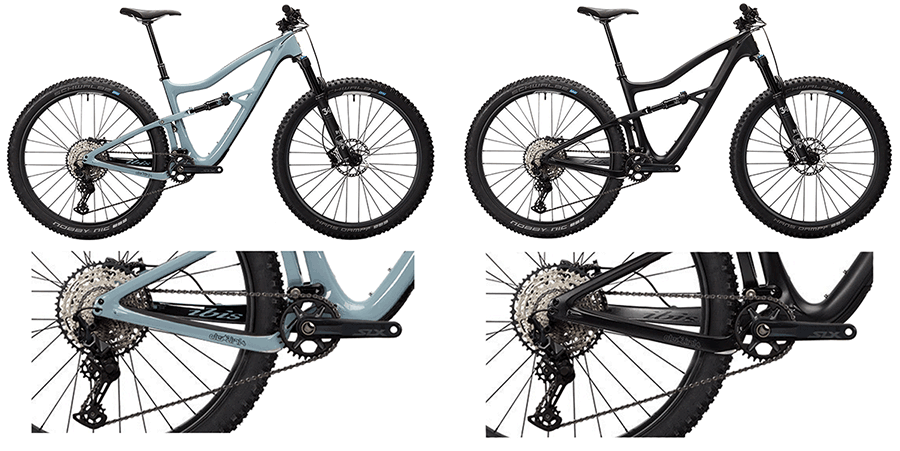
Ibis Ripley – One of the most iconic short-travel playbikes available.
Trail and Cross-Country mountain bikes offer limitless fun on various terrains. There are quite a few different mountain bike types out there, but in this review – we’ll be focusing on the lighter end of the spectrum, bikes that are considered as short travel full-suspension mountain bikes.
- You may also like: 15 Best Full-Suspension Mountain Bikes to Consider
Best Short-Travel Full-Suspension Mountain Bikes
1 . orbea – oiz h20.
Best XC Full-Suspension Mountain Bike

Aluminum / 12-Speed Shimano Deore / 29×2.35″
MSRP: $3,599 Jenson USA
Fork : Fox 32 Float Rhythm, 120mm travel Shock : Fox i-Line DPS Performance, 120mm travel Wheels : Orbea OC1 25c
The Orbea Oiz H20 is a sleek full-suspension XC bike built for speed and efficiency. With a premium aluminum frame, quality components, and World Cup geometry, you’ll be smashing your PRs with the Oiz in no time.
It’s ideally suited to cross-country or long-distance trail riding, with a 12-speed Shimano Deore/XT groupset that includes a 10-51T cassette.
Fox provides both the I-Line DPS Performance shock and the 32 Float Rhythm fork. To complement the lightweight Orbea OC1 rims, you get 29×2.35″ Rekon Race EXO tires.
Head tube angle: 68º / Seat tube angle: 74º / Chainstay: 435mm
Buy on Jenson USA
2 . Santa Cruz Bicycles – Blur C S
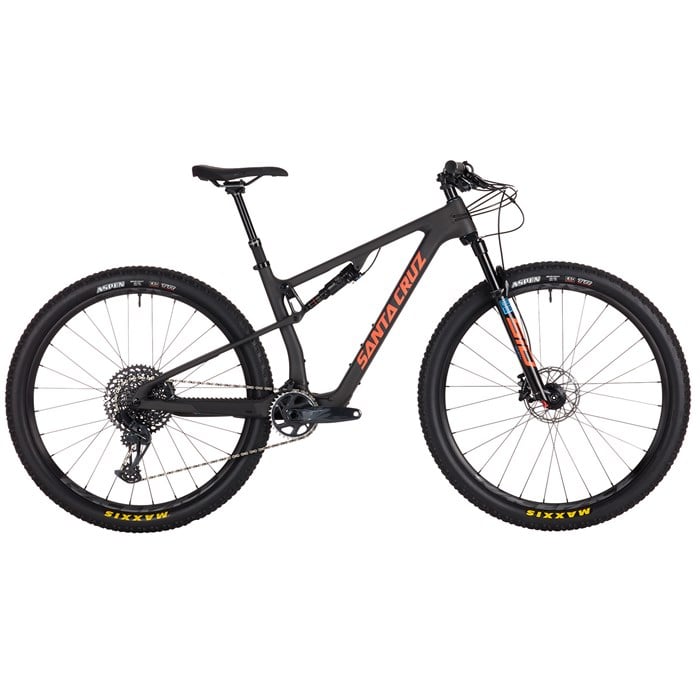
MSRP : $5,549 Evo.com
Fork: RockShox SID SL Select 100mm travel Rear Shock: RockShox SIDLuxe Select+ 100mm travel Wheels: RaceFace AR Offset 29″
The Santa Cruz Blur is the famous MTB brand’s race-ready XC bike, designed to be lightweight, fast, and efficient.
The Blur C S uses Santa Cruz’s more affordable carbon grade, which has excellent stiffness and strength characteristics that help maximize power transfer.
A 100mm travel RockShox SidLuxe Select+ shock is enhanced by a patented SuperLight suspension linkage that keeps the weight low but enhances rear-end traction on trickier sections.
This build comes with a SRAM GX Eagle 12-speed, 10-50T drivetrain with Level TL hydraulic disc brakes. Other notable components include the fast-rolling Maxxis Aspen 2.4″ tires, an SDG Tellis dropper for extra descending control, and lightweight RaceFace AR Offset rims.
Pick the Santa Cruz Blur C S if you’ve got lofty XC ambitions and the budget to match.
Buy on evo.com
3 . Pivot – Mach 4 SL Ride
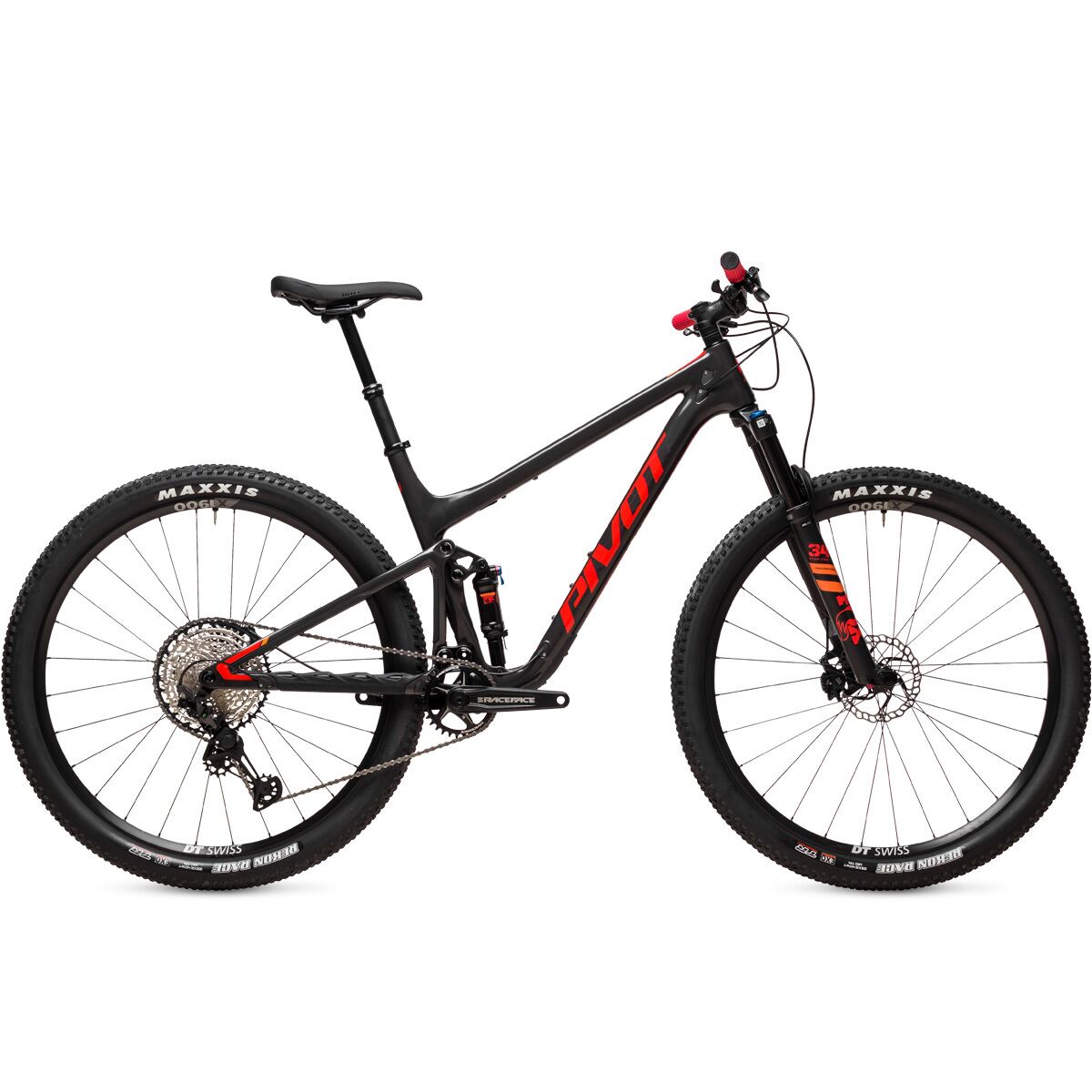
Carbon / 12-Speed Shimano XT/SLX / 29×2.2″
MSRP: $6,199 Competitive Cyclist
Fork : Fox Float 34 Performance Step-cast 120mm Shock : Fox Performance Float DPS 100mm Wheels : DT Swiss X1900 alloy
The Pivot Mach 4 SL Ride is a sleek full-suspension XC MTB by a lesser-know but high-end MTB manufacturer, perfect for racers who want top performance.
The full carbon frame is incredibly light and strong, built for 29″ wheels and DW-Link suspension that perfects anti-squat characteristics for a snappy, responsive feel and extra traction. This model comes with race-ready 2.2″ Maxxis Ardent Race EXO tires.
The Mach 4 SL Ride has 100mm rear and 120mm fork suspension. In addition, you’ll have ample gearing from the 12-speed Shimano XT/SLX drivetrain. Thankfully, Pivot includes a Fox Transfer Performance Elite dropper post with 100 to 150mm travel depending on the size.
Choose the Pivot Mach 4 if you want to take your XC riding to the next level with a bike that’s ready for aggressive riding.
Buy from Competitive Cyclist
4 . Niner – Jet RDO 4-Star
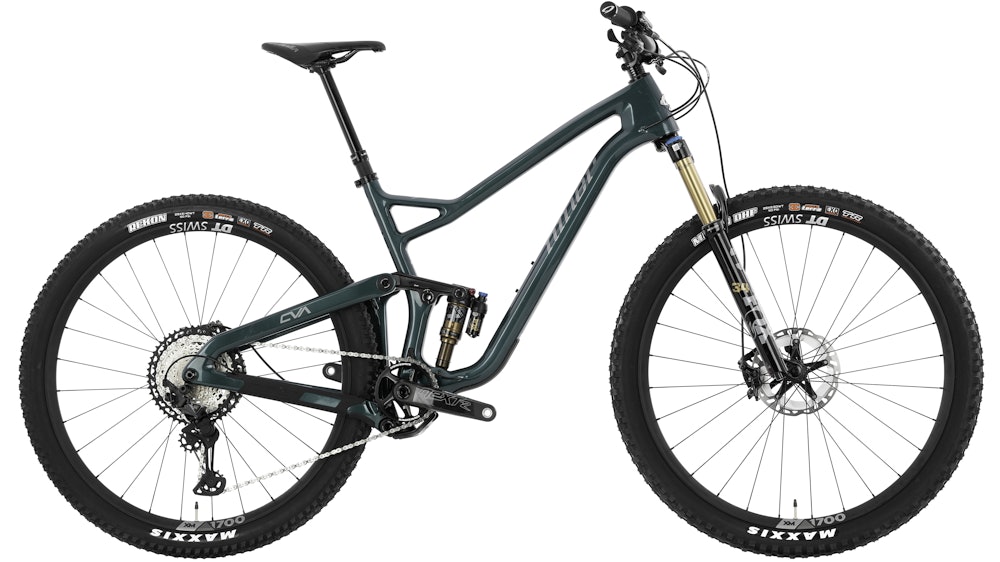
Carbon / 12-Speed Shimano XT / 29×2.6″
MSRP: $6,799 Jenson USA
Fork : Fox 34 Float Factory GRIP2 EVOL 130mm travel Shock : Fox Float X Factory EVOL 120mm travel Wheels : DT Swiss XM-1700 Spline 30
One of the more expensive offerings on our list, this Niner full-suspension mountain bike is a burly trail/XC bike with modern trail geometry and top-quality parts.
The RDO Carbon frame features Niner’s CVA suspension platform, integrated protection, and 2.6″ tire clearance. The 130mm travel Fox Float Factory fork and 120mm Float X Factory shock provide a plush feel on rough trails while the CVA design improves the pedaling efficiency of the system.
A 12-speed Shimano XT drivetrain comes with RaceFace Next R carbon cranks and a 10-51T cassette. 180mm rotor XT hydraulic disc brakes round out the groupset.
An unusual inclusion is the Schwalbe Nobby Nic Addix Speedgrip 2.6″ tires which are very versatile and tough but add a little more weight. Finally, you have a KS Lev SI dropper with 100 or 150mm of travel.
Choose the Jet RDO 4-Star if you want a highly-capable trail/XC bike with innovative design features, solid components, and long-lasting quality.
Head tube angle: 66.5º / Seat tube angle: 76º / Chainstay: 430mm
5 . Rocky Mountain – Element Alloy 30
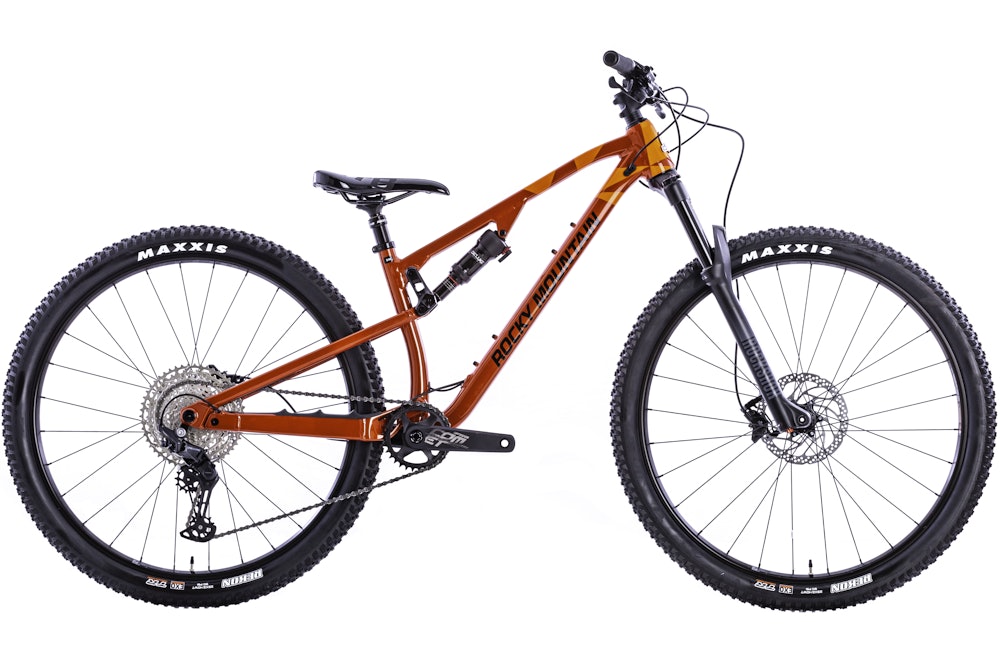
Aluminum / 12-Speed Shimano Deore / 29×2.4″
MSRP: $3,089 Jenson USA
Fork : RockShox Recon Gold 130mm Shock : RockShox Deluxe Select+ 120mm travel Wheels : WTB ST Light i27 TCS 2.0 TR 29″ (27.5″ on XS frame)
The 29″ Rocky Mountain Element Alloy 30 is a cross-country/trail MTB with a do-it-all personality.
The FORM alloy frame has relatively aggressive trail geometry which pairs well with a RockShox Recon Gold 130mm fork, Deluxe Select+ 120mm shock, and Toonie Drop dropper post for confident riding on most trails.
The groupset includes Shimano’s Deore M6100 drivetrain with a 10-51T cassette with MT4100 hydraulic disc brakes. This setup and Maxxis Rekon 2.4 makes climbing easier and descending safer.
Head tube angle: 65º / Seat tube angle: 76º / Chainstay: 436mm
6 . Yeti – SB120 T1

Turq-Series Carbon / SRAM X01/GX Eagle / 29×2.5/2.3″
MSRP: $8,200 Jenson USA
Fork : Fox Factory 34 GRIP2 130mm Shock : Fox Factory Float DPS 120mm Wheels : DT Swiss XM1700
The SB120 is a Yeti full-suspension MTB focused on cross-country and trail riding. This bike has an eye-watering price but has the spec and performance to match.
The Yeti SB120 T1 is built for speed and versatility with 29″ wheels and modern trail geometry. This is balanced by confidence-inspiring and premium 2.5/2.3″ Maxxis Minion DHF/Aggressor EXO tires.
A blended SRAM groupset consists of a 12-speed, 10-52t X01/GX drivetrain that provides reliable and durable performance and G2 RSC four-piston hydraulic disc brakes. The wide gear ratio allows for easy hill climbs while powerful brakes ensure safe descents.
Consider the SB120 T1 if you want a high-end trail bike for tackling a wide variety of trails.
Head tube angle: 66.5º / Seat tube angle: 76.5º / Chainstay: 433-443mm
7 . Co-op Cycles – DRT 3.3
A reliable, affordable XC bike

Aluminum / 12-Speed Shimano SLX / 27.5 or 29 x2.4″
MSRP: $3,299 REI
Fork : RockShox Revelation Motion Control RC 120 or 130mm Shock : RockShox Deluxe Select+ 120 or 130mm Wheels : WTB ST Light i30 TCS
The DRT 3.3 is a cross-country bike with plenty to offer beginner or intermediate XC mountain bikers. It features progressive wheel sizing and suspension travel based on frame size, Airsprung RockShox suspension, and premium Maxxis High Roller or Dissector tires.
This bike has a lightweight but strong aluminum frame that helps keep the price down without sacrificing too much performance. This is boosted by a Shimano SLX 12-speed with a 10-51t climbing cassette and powerful Shimano SLX disc brakes for controlled descending.
Head tube angle: 66/67° / Seat tube angle: 75° / Chainstay length: 433/441mm
Buy on REI.com
8 . Juliana – Wilder C R TR
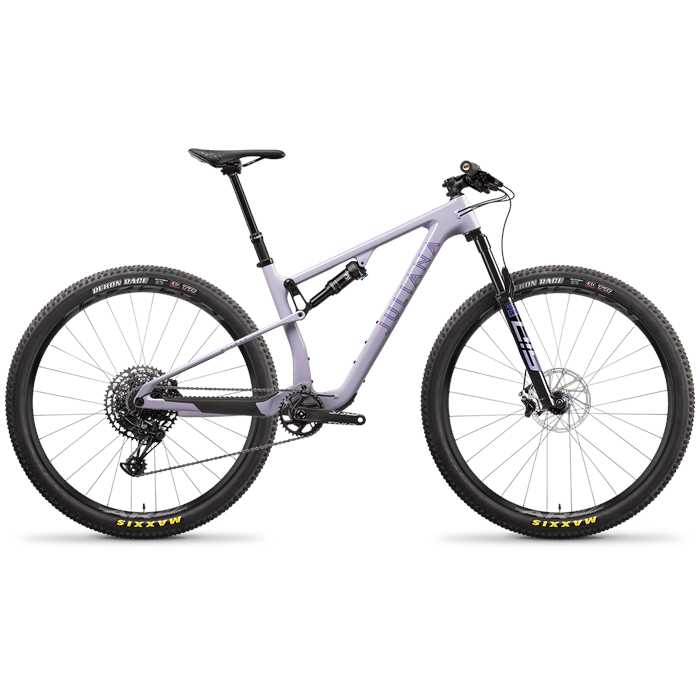
MSRP : $4,899 Evo.com
Fork: RockShox SID RL 120mm travel Rear Shock: Fox Float Performance DPS 115mm travel Wheels: RaceFace AR Offset
Julianna’s Wilder is a race-ready trail bike designed to tackle the toughest trails with confidence. As Santa Cruz’s women-specific brand, Julianna takes advantage of its VPP suspension system to provide the Wilder with unbeatable suspension performance.
Large 29″ RaceFace AR rims and slack geometry allow you to roll over any obstacle on the trail. In addition, female-tailored geometry and a Carbon C frame ensure the Wilder is painless to maneuver.
Finally, this bike is built on an SRAM NX Eagle drivetrain and paired with grippy Maxxis Rekon Race tires and powerful SRAM Level T hydraulic disc brakes to ensure smooth climbing ability and controlled descending.
Buy on Evo.com
9 . Marin – Rift Zone 1
Best value full-suspension mountain bike

Series 3 Aluminum / 11-Speed Shimano Deore / 29×2.3″
MSRP: $1,899 Jenson USA
Fork : RockShox Recon Silver RL 130mm Shock : X-Fusion O2 Pro R 125mm Wheels : Marin Aluminum Double-Wall
The Rift Zone is a 29-inch trail mountain bike designed for speed over fast, flowy trails.
Multi-Trac suspension improves big hit absorption and delivers a more efficient pedaling platform for the 130mm RockShox Recon Silver RL fork and a 125mm X-Fusion O2 Pro R rear shock.
Vee Tire Crown Gem 29×2.3″ tires are durable but lack some grip in the corners and are slightly slow for this type of bike.
The Rift Zone 1 runs a typical 11-speed Shimano Deore drivetrain with Shimano MT201 hydraulic disc brakes and is finished off with a budget alloy seatpost instead of a dropper.
This is a solid XC/trail bike that offers excellent value for money in the entry-level category of full-sus bikes.
Head tube angle: 65.5º / Seat tube angle: 76º / Chainstay: 425mm
Buy on JensonUSA.com
10 . Norco – Fluid FS 2

MSRP: $2,499 Jenson USA
Fork : RockShox 35 Silver R, 130mm travel Shock : RockShox Deluxe Select, 120mm travel Wheels : Stan’s NoTubes Flow D
The Norco Fluid is a full-suspension mountain bike with an innovative progressive frame design for enhanced fit and performance. It features 130mm of front travel and 120mm in the rear, with a reliable Shimano Deore 12-speed drivetrain and matching Shimano MT420 hydraulic disc brakes.
Norco chose Stan’s NoTubes Flow D rims with Maxxis Dissector 2.4″ tires for their excellent grip and durability. For a seatpost, you can rely on an X-Fusion Manic dropper. Every detail is accounted for on the Fluid FS 2, making it an excellent value trail bike.
Head tube angle: 66º / Seat tube angle: 76º / Chainstay: 431mm
Buy from JensonUSA.com
11 . GT – Sensor Sport

Aluminum / MicroSHIFT Advent X, 10-Speed / 29 x 2.3″
MSRP: $2,300
Fork : RockShox Recon Silver, 140 mm Shock : X-Fusion 02 Pro RL 130mm travel Wheels : WTB Aluminum rims
The GT Sensor Sport is a full-suspension trail mountain bike designed to handle almost any trail out there .
This bike can smash climbs and thunder down descents with ease thanks to GT’s LTS rear linkage technology which soaks up trail chatter and improves traction.
The lightweight, durable aluminum frame is fitted with a RockShox Recon Silver RL 140 mm fork and an X-Fusion 02 Pro RL 130 mm shock which offer decent performance for this price range.
This bike takes rolls along smoothly and corners confidently with 29″ wheels wrapped in WTB Breakout 2.3″ tires. Finally, you can rely on a MicroSHIFT Advent X 10-Speed drivetrain for smooth shifting and powerful but inconsistent Tektro HD-M275 hydraulic brakes.
Head tube angle: 65.5º / Seat tube angle: 76º / Chainstay: 435mm
Buy from Jenson USA
12 . Alchemy Bikes – Arktos 120

Carbon / 12-Speed Shimano XT / 29×2.3″
MSRP: from $4,699 Alchemy Bikes
Fork : Fox 34 29 Factory Kashima 130mm travel Shock : Fox DPX2 Factory Kashima EVOL 120mm travel Wheels : Industry Nine 29 Enduro S Hydra
The Alchemy Bikes Arktos 120 is a full-suspension XC/trail mountain bike that’s perfect for riders who enjoy charging uphill and thundering down descents.
The Alchemy carbon frame is ultra-lightweight and laterally stiff, and the seat tube allows longer dropper posts like the stock Fox Factory 175mm Transfer dropper.
The Arktos runs on Alchemy’s patented Sine Suspension dual-linkage platform. This system provides next-level performance through enhanced efficiency on climbs and improved handling and traction on chunky descents. The 130mm and 120mm Fox Factory Kashima suspension soaks up all but the most aggressive hits.
The Arktos 120 comes with a choice of three 12-speed groupsets (Shimano XT or SRAM GX/X01). Each has a hill-crushing cassette and 180mm-rotor hydraulic discs. Finally, burly Industry Nine enduro rims are fitted with Maxxis Minion DHF and DHR 29×2.3 tires, providing plenty of capability but adding some extra weight.
Consider the Arktos if you want high-end performance and an award-winning carbon frame at a reasonable price.
Head tube angle: 65.75-66.5-º / Seat tube angle: 77.75-78.5º / Chainstay: 437mm
Buy on Alchemy Bikes
13 . Pivot – Trail 429 Pro
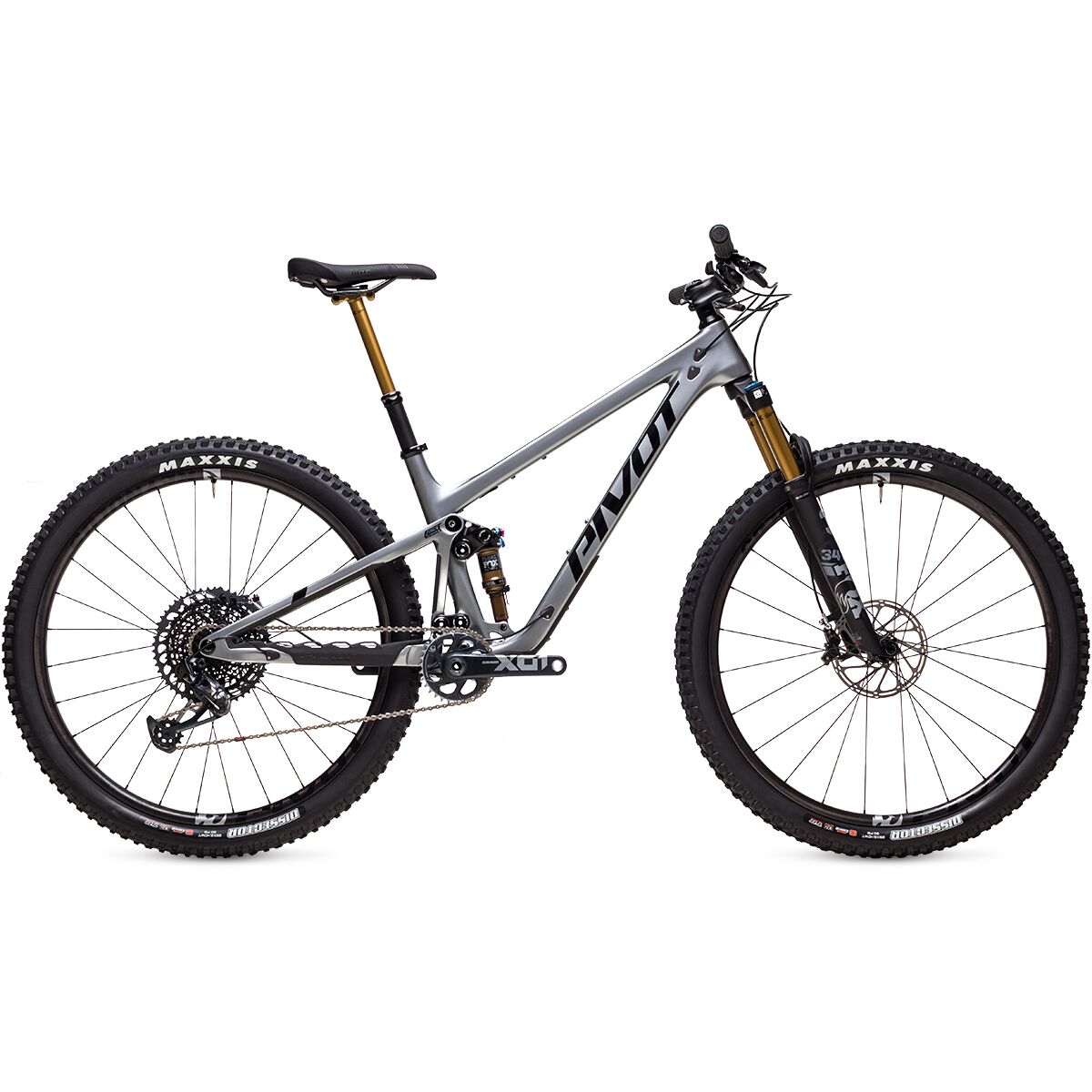
Carbon / SRAM X0 Eagle / 29×2.4″
MSRP: $9,900
Fork : Fox Factory 36 GRIP2 140mm travel Shock : Fox Factory Float X, 130mm travel Wheels : Reynolds Blacklabel carbon
Pivot Cycles is a relatively new bicycle company that has already won awards for its innovative design.
This can be seen on its Trail 429 Pro 29er full-suspension trail/XC bike, a lightweight carbon beast with top-level parts. It’s a professional XC bike for advanced riders, with modern trail geometry in the low flip-chip setting that provides confidence on steep descents.
The suspension is tight, with a Fox Factory 36 140mm fork up front and 130mm Factory Float X shock on the rear. The DW-Link platform and carbon fiber build kit allow you to get more power from each pedal stroke, making this a highly efficient climber.
Using the 12-speed SRAM X0, 10-52t drivetrain you get perfect shifting every time and plenty of gears for steep grades. In addition, the Trail 429 has powerful four-piston SRAM G2 RSC hydraulic disc brakes.
Don’t miss out on the Pivot Trail 429 Pro if you’ve got a huge budget and want unbeatable trail performance to match.
Head tube angle: 66-66.5º / Seat tube angle: 75-75.5º / Chainstay: 430-432mm
Buy from Mike's Bikes
14 . Santa Cruz Bicycles – Tallboy R

Aluminum / 12-Speed SRAM NX Eagle / 29×2.4″
MSRP: $4,199
Fork : FOX Rhythm 34, 130mm travel Shock : Fox Float DPS Performance, 120mm travel Wheels : Race Face AR Offset 30
The Tallboy is of the most popular Santa Cruz full-suspension Mountain Bikes and this version has a tighter, more grounded feel, perfect for attacking bumpy terrain at high speed.
With the Santa Cruz Flip-Chip upper link, you can fit 29″ or 27.5″ rims and tires, although it comes standard with 29×2.4″Maxxis Dissector/Rekon EXO tires on Race Face AR Offset 30 rims.
The 12-speed SRAM NX Eagle groupset runs a wide-ratio 11-50T cassette for easy climbing and includes SRAM Guide T four-piston hydraulic disc brakes.
It’s finished off with a Burgtec Enduro MK3 stem, handlebar, SDT Tellis dropper, and Cane Creek 10 IS integrated headset.
Head tube angle: 65.7º / Seat tube angle: 76.8-76º / Chainstay: 436mm
15 . Juliana – Joplin 4 C R
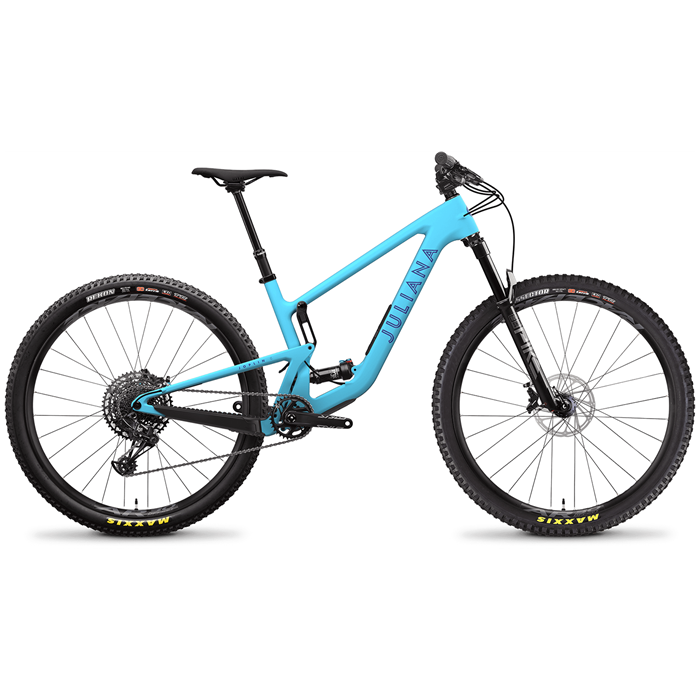
Carbon C / 12-Speed SRAM NX Eagle / 29×2.4″
MSRP: $5,299 Evo.com
Fork : RockShox Pike Base 130mm Shock : Fox Float Performance DPS 120mm travel Wheels : Raceface AR Offset 30
The Juliana Joplin is a women’s full-suspension trail/XC mountain bike built for speed.
The premium Santa Cruz Carbon C frame is fitted with a RockShox Pike Base fork with 130mm of travel and a Float Performance DPS 120mm rear shock. These components are enhanced by the tailored lower-link VPP suspension that improves pedaling efficiency and traction.
The drivetrain is a 12-speed SRAM NX Eagle with an 11-50t cassette for steep climbs and for braking you have SRAM Guide T hydraulic discs.
Finally, the Juliana Joplin 4 C R has an SDG Tellis dropper and 2.4″ Maxxis Dissector/Rekon 3C MaxxTerra EXO tires to provide confidence when descending on fast, chunky trails.
Choose this women’s mountain bike if you love days on the trails with lots of elevation gain and a variety of trails.
Head tube angle: 65.7º / Seat tube angle: 76-76.7º / Chainstay: 430-433mm
16 . Ibis – Ripley AF
🏆 Best all-around mountain bike for every terrain

Aluminum / 12-Speed Shimano Deore / 29×2.4″
MSRP: $3,799 Jenson USA
Fork : Fox Float 34 Performance, 130mm travel Shock : Fox Performance Float DPS, 120mm travel Wheels : Blackbird Send Alloy Max Clearance 2.6″
Coming in at just under $4,000, this is one of those bikes that outperforms its price tag. Straight off the bat, the 12-speed Shimano Deore groupset is impressive with hydraulic disc brakes.
Naturally, it has a premium quality aluminum frame with superb DW-Link suspension technology, offering 120mm of rear travel from Fox Performance Float DPS shock. With a similar kit upfront, you get 130mm of travel on the Float 34 fork, and it’s all rounded off with Blackbird rims and 2.4″ Maxxis DHR II and Dissector tires.
Head Tube Angle: 65.5º / Seat Tube Angle: 76º / Chainstay length: 432mm
17 . Yeti – SB115 C2
CARBON C1 BIKE

Available in 3 designs
Carbon / 12-speed SRAM GX Eagle / 29×2.5″, 2.3″
MSRP: $6,200 Competitive Cyclist
Another top-class mountain bike from Yeti , this combination XC and trail bike attacks both the hills and the drops with equal vigor and aggression. The lightweight carbon frame combined with the 12-speed SRAM GX Eagle 10-52T cassette makes easy work of hills, while the Switch Infinity rear suspension technology combined with 130mm travel on the Fox Performance fork makes downhills a breeze.
You get added support from a thick 2.5″ Maxxis Minion DHF front tire and 2.3″ Aggressor on the rear, wrapped around DT Swiss rims. Oh and let’s not forget the Fox Transfer dropper seat post for added ease and enjoyment!
Head tube: 67.6 / Seat Tube: 74.1 / Chainstay: 437mm
Buy on Competitive Cyclist
18 . Santa Cruz Bicycles – Blur
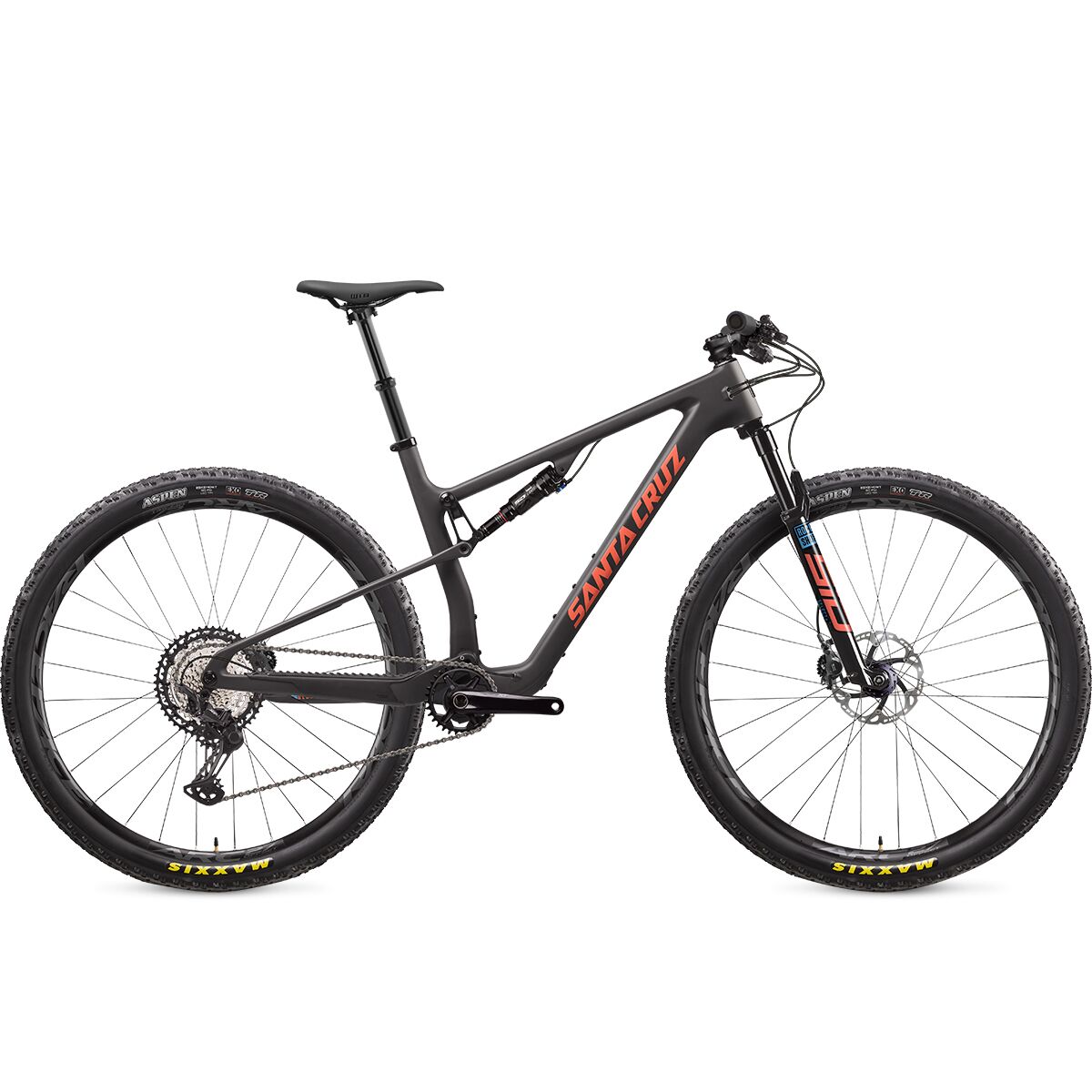
Carbon C / 12-Speed Shimano XT / 29×2.4″
MSRP: $6,599
Fork : RockShox Sid SL Select+ 100mm travel Shock : RockShox SidLuxe Select+ 100mm travel Wheels : Race Face ARC Offset 27
The race-ready Blur XC bike from Santa Cruz is designed for fast riding on cross-country trails.
The SuperLight suspension linkage combined with a 100mm RockShox Sid SL Select+ fork and SidLuxe Select+ shock provides plenty traction on the rougher stuff.
Fast-rolling 29er wheels, Maxxis Aspen 2.4″ XC racing tires, a stiff and lightweight carbon frame, and agile geometry give the Blur its high-performance personality.
The groupset is a 12-speed Shimano XT with four-piston hydraulic disc brakes and plenty of gearing from the 10-51t cassette.
Consider the Santa Cruz Blur if you’re ready to take your XC rides to the next level.
Head Tube Angle: 65.7-65.4 / Seat Tube Angle: 77.5-76.8 / Chainstays: 423-433mm
Buy on Mike's Bikes
19 . Cannondale – Habit Carbon 1
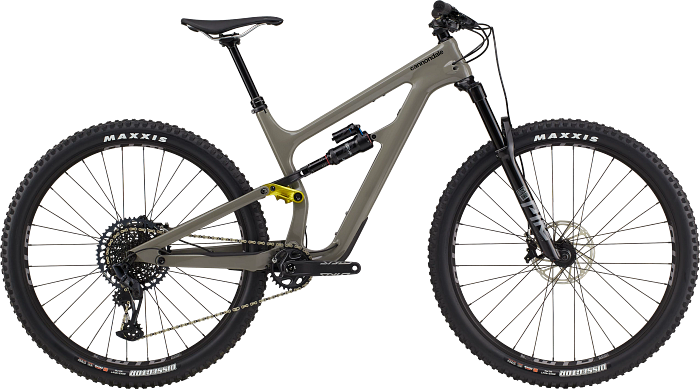
MSRP: $5,500 Planet Cyclery
Every XC rider comes across an unexpectedly steep descent every now and again, leaving them in a precarious situation with an inadequate bike. The Cannondale Habit Carbon 1 rises to this challenge, offering an XC-specific bike that can tackle steep downhills with confidence.
It achieves this with the addition of a Cannondale DownLow dropper post combined with Cannondale’s Proportional Response Tuned suspension system. The RockShox Pike Select+ 140mm fork has slightly longer than usual travel for an XC bike, with the 130mm RockShox Super Deluxe Select+ rear shock to match. A wide-range SRAM GX Eagle drivetrain with a 10-52t cassette and SRAM G2 RSC hydraulic disc brakes make up a solid mountain-ready groupset that can tackle climbs and descents with ease.
HT: 66° / ST: 74.5° / Chainstay: 435mm
Buy on Planet Cyclery
20 . Evil – Following LS GX
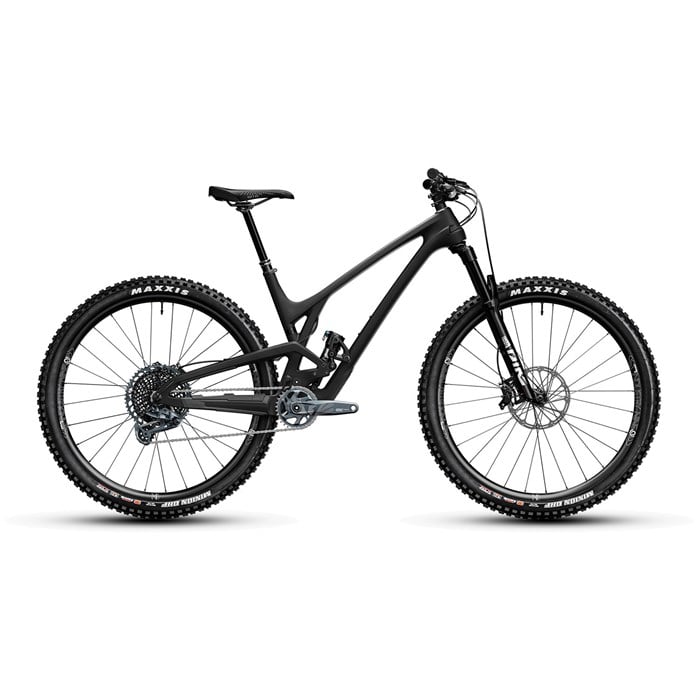
MSRP: $6,450 evo.com
Evil Bikes is known for making high-quality mountain bikes that push the boundaries of design and innovation. The ‘Following’ is its versatile XC offering – a high-speed MTB with 29″ wheels, semi-compact geometry, and mid-range travel that can tackle unusually harsh conditions
The proprietary DELTA suspension system and RockShox Deluxe Ultimate RCT shock are both highly tunable to adapt to varying conditions so if you feel like doing some downhill riding, simply adjust it to your needs and hit the trails. On this version of Evil’s Following, SRAM provides decent 12-speed gearing and instant braking with its mid-level GX Eagle groupset and G2 RS disc brakes.
Where Can You Ride a Short-Travel Mountain Bike?
Short travel mountain bikes are ideal all-rounder bicycles for fast and zippy trails, whether it is flat or hilly.
Downhill mountain bikes with lots of travel are ideal for extremely rough terrain with big drops and large obstacles but provide a disadvantage on flatter terrain.
The less stiff your suspension is, the more speed you lose when riding fast on flat terrain. So you need to choose a bike that best suits the type of riding you intend to do. For most All-mountain, Cross-country, and Trail riding, you shouldn’t need more travel than 100-130mm. MTB bikes with travel between 140-180mm are intended for intense downhill and enduro-style riding.
Of course, many of these bikes have adjustable suspension, so in some cases, you can change it for the terrain of that day. However, if you don’t intend on ever tackling extreme downhills, big jumps, or huge drops, then there is no need to spend the extra on advanced suspension with unnecessarily long travel.
Other Factors to Keep in Mind
Carbon vs. aluminum: which is better.
Which is better: Carbon or Aluminum for a full-sus. MTB? Well, carbon has taken over the whole cycling industry for a while by now, and it is not different from the mountain bike scene. As carbon-tubing gets better each year, there is a reason why mountain bikers prefer carbon over aluminum. Carbon simply has the right ‘feel’ to the whole ride, while providing enough durability and ways to form a bike.
Tires & Tire Pressure
It is recommended to use more air in the rear tire when on trails.
- 29″ – 18-28 psi. Plus-size tires or on wider wheels (Ibis) can be run on lower,11-18 psi range
- 27.5″ (650b) – 16-30 psi.
Lowering your tire pressure means you create more contact with the ground so if you have thin tires, less pressure will provide more grip. However, while this may be a bit more comfortable offroad it comes at the sacrifice of speed on flatter ground. Depending on your weight, you should try to find a perfect balance that isn’t too low or too hard.
Tubeless tires can usually run lower pressure since there is no tube to pinch. Similarly, wider rims can also accommodate lower tire pressure. These are all factors to consider when pumping your tires.
Suspension set-up
You should always tune your suspension correctly to accommodate your weight and riding style. This can be done by rocking up and down on the bike to measure your ‘sag’ rate and then adjusting the air or spring pressure accordingly.
If you’re going to be hitting big jumps or drops, you’ll need a wider, looser suspension to take heavy impact. If you’re riding mostly flat trails, you’ll want it stiffer so you don’t over-compress and lose speed on each little bump.
Compression / Sag / Rebound
The Sag, as mentioned earlier, is important to measure and set accordingly before heading out on the trails. Once that’s done, set the rebound damping by pushing on the front suspension and seeing if you get any ‘bounce’. Tighten it until it only rebounds once, doesn’t bounce up and down.
For the compression settings, you’ll need to specify them according to your riding style. Different shocks have different settings, so it’s down to your style and preference. Basically, add more compression damping if you want tighter traction on corners, or less if you want more absorption on big drops.
Rider Weight
It’s important to get the correct weight distribution on a full-suspension bike otherwise you could injure yourself on the trails. The longer wheelbase a bike has, the more stable it will be, so heavier riders should consider this factor.
Bottom bracket height is also important, as the higher the less stability you get but it can’t be too close to the ground either for obvious safety reasons. Generally, these measurements can all be perfected for you in-store when you buy a new bike. It’s always a good idea to have a professional fit your bike for you.
Share this on:
About the Author

Mark Hartley
Leave a reply cancel reply.
Your email address will not be published. Required fields are marked *


- Cycling Magazine
XC trail versus short-travel trail bikes: what’s the difference?
Parsing out the distinctions between micro-categories.

Bike categories have never really been concrete, clear divisions but, with some recent developments, they are getting more confusing. What makes the difference between a cross country trail bike and a trail bike with short travel? How about the difference between XC and XC Trail? Or long-travel and short-travel trail bikes? And why are there so many categories now?
Brands try to put bikes in categories to make it easier for riders to understand what bike is best suited to their riding. But as the basic categories proliferate into endless micro-categories, the picture gets blurry. Especially when some cross country bikes, like the latest Rocky Mountain Element, have the same travel as some short-travel trail bikes, like the Giant Trance 29. These two bikes have quite different purposes.
So how do you tell them apart if suspension travel is no longer an easy guide? More importantly, how do you find the right bike for you? Below, we’ll break down the differences between categories and how to decide which one suits your style of riding best.
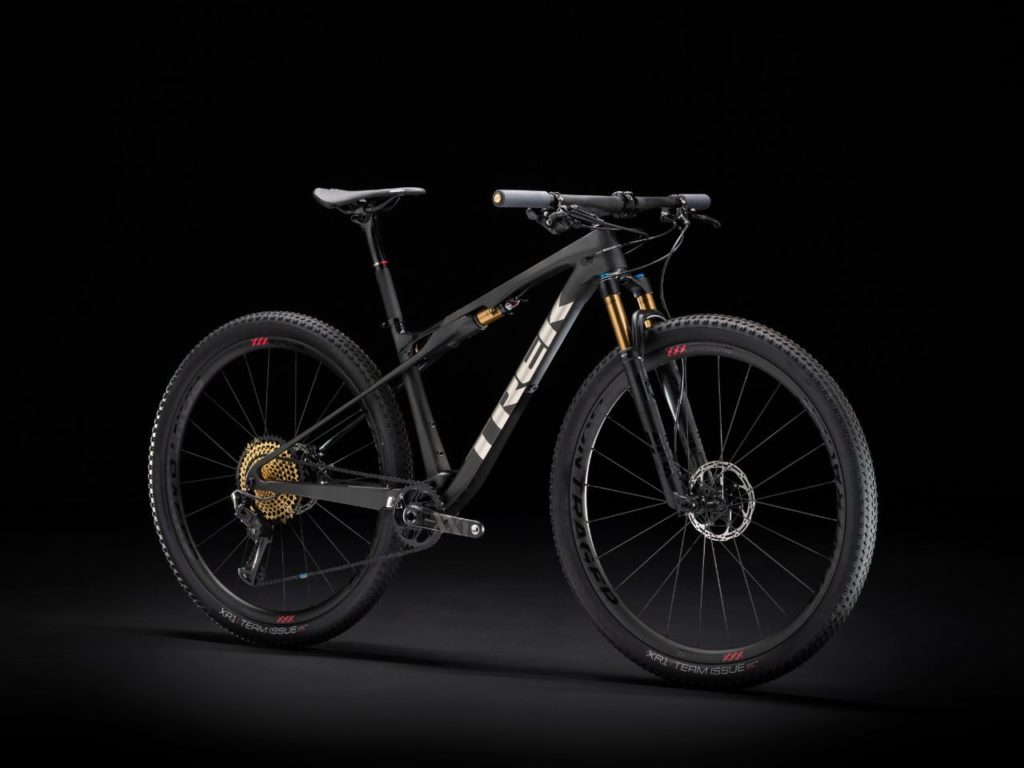
Trek Supercaliber is 100 per cent focused on XC racing
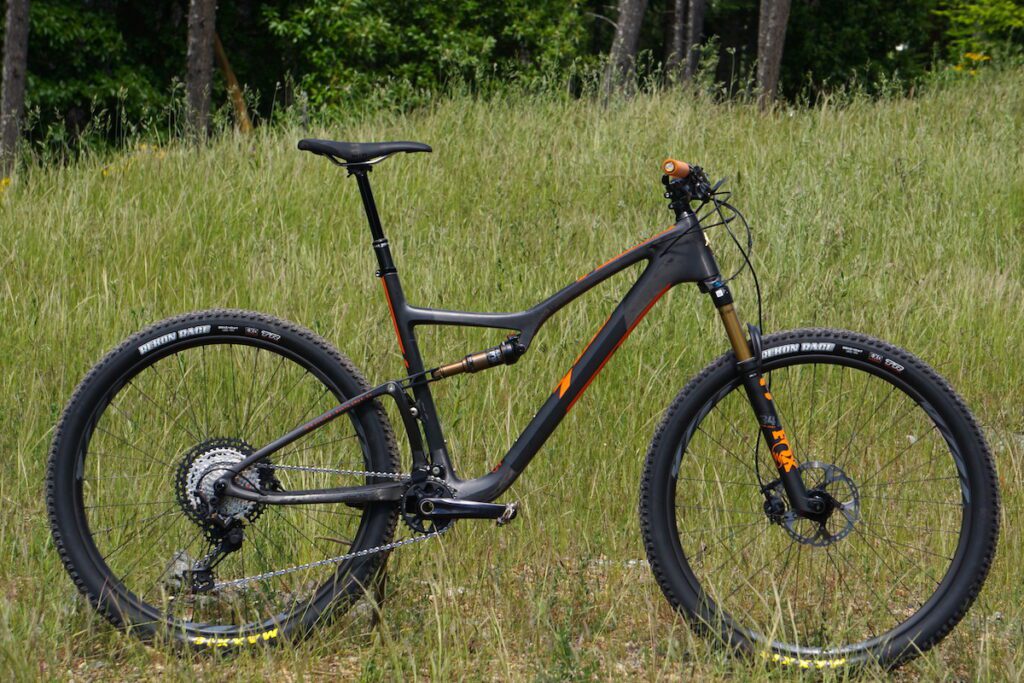
Ibis Exie is a 100-mm travel XC race bike, but with the option to run a 120-mm fork.
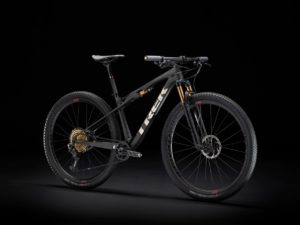
Cross country (XC)
Cross country bikes are designed to be fast and efficient, especially while pedalling. They have geometry that makes them comfortable for spending long hours in the saddle, typically have faster steering for winding through tight, technical trails and aim for a lower weight to aid in easier acceleration and climbing. They can be hardtails or dual suspension with just enough travel, up to 100 or 110mm of rear wheel travel, to take the edge off of roots and rocks and improve speed and control on descents. XC bikes usually use 29″ wheels for efficiency, though some brands still offer 27.5″ wheels in smaller sizes.
Cross country bikes are usually thought of as race bikes since they put such a strong emphasis on pedalling and climbing efficiency. They are, though, a great option for anyone who tends to ride flatter, smoother trails or anyone who enjoys climbing as much as they do descending.
Examples: Ibis Exie , Trek Supercaliber , Canyon Lux World Cup , Norco Revolver FS 100, Scott Spark RC.
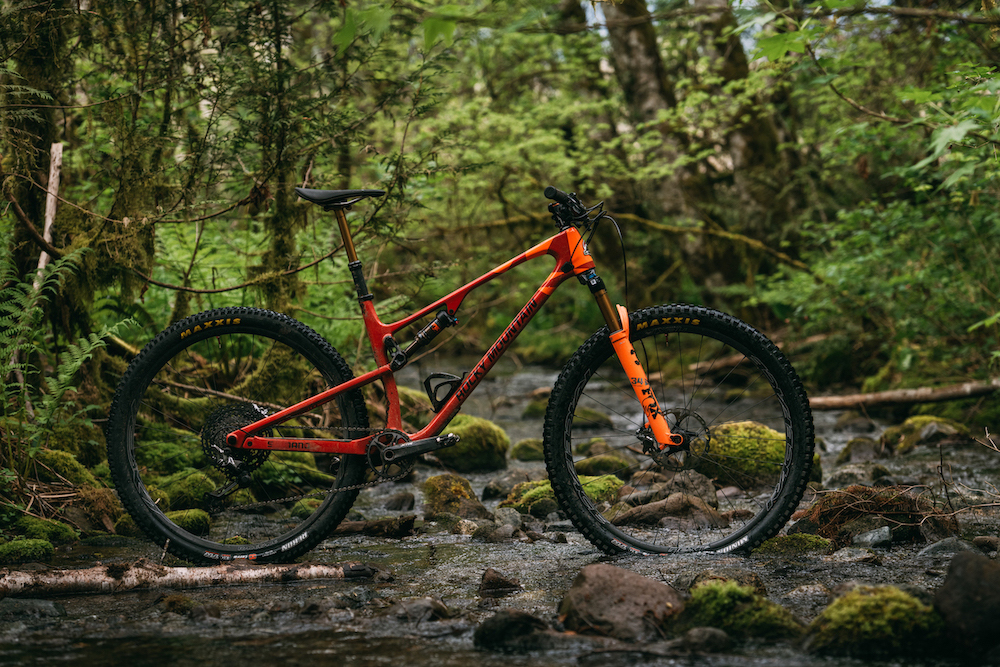
2022 Rocky Mountain Element pushes the limits of XC with 120mm rear travel, 130mm forks and aggressive geometry. Photo: Margus Riga

Canyon Lux Trail builds off of the brand's World Cup bike for a race-focused take on XC trail
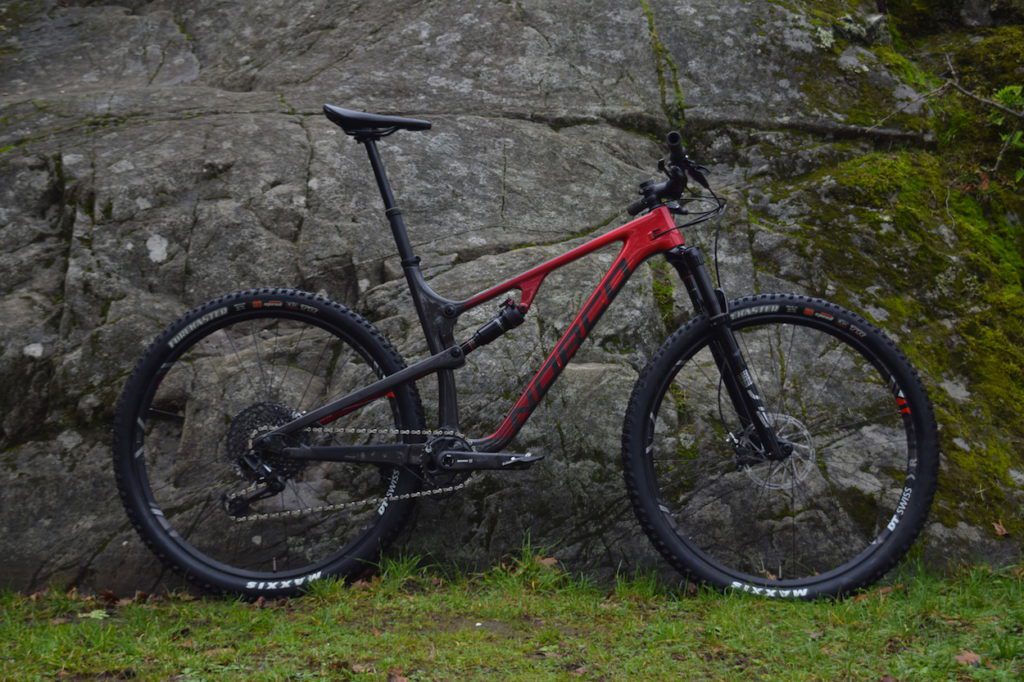

Norco Revolver 120 similarly builds off the Revolver 100 platform to blur lines between racing and riding for fun.

Scott Spark is a slightly longer-travel version of the Spark RC
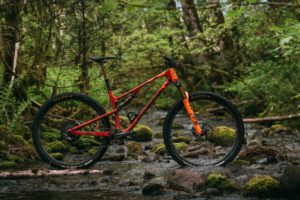
A newer category of bike that’s really gained momentum over the last few years is “XC Trail” bikes. Some brands have made tougher builds of their cross country bikes for years, sometimes with slightly more travel. Now, more brands are making separate XC Trail models. These bikes typically have between 110 and 120mm of rear wheel travel and either 120 or 130mm forks, though that’s just the start of the differences.
These don’t just have more travel than their XC counterparts. They also tend to have different geometry, often slightly more balanced between descending capability and climbing efficiency, and tougher parts. XC Trail bikes are great if you’re aiming for a more technical cross country stage race (like BC Bike Race or TransRockies), or if your everyday riding includes lots of climbs but also more technical descents. These bikes are still very focused on efficiency but open the door to taking on (or having fun on) harder or more challenging descents than a pure XC bike.
Examples: Rocky Mountain Element , Canyon Lux Trail , Norco Revolver FS 120 , Scott Spark .

2022 Giant Trance only has 120mm rear travel, but it's much more focused on fun than climbing speed. Photo: Nick Iwanyshyn

Norco Optic really pushed the burly short travel trail bike idea with 125mm rear travel.

Canyon's Spectral 125 is a zesty take on its 150-mm travel Spectral bike
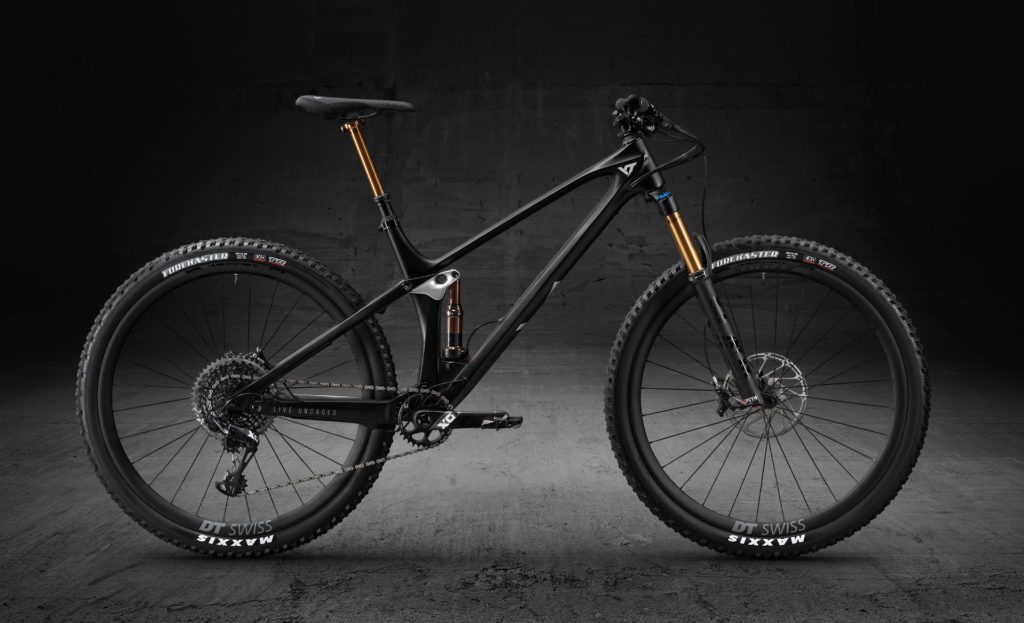
YT Izzo is a balanced 130-mm front and rear, but designed around trail fun more than XC speed.

Trail bikes (short travel)
Another newer category that is really coming into its own lately is the short-travel trail bike. These scaled-down trail bikes answer rider’s call for bikes that are designed to attack descents but aren’t bogged down by too much suspension travel. Why would you want that? Well, if you want the confidence and control of a trail bike going downhill but your local trails don’t warrant a 150mm/160mm bike, these bikes give you proper geometry and just enough travel. Alternately, if you want a challenge, want a more responsive or precise bike but still want to hit bigger things, short-travel trail bikes back up a little travel with burlier parts.
These bikes can range in travel from roughly 115mm to 130mm of rear wheel travel with forks adding another 130 or 140mm up front. More important than travel is the frame design. Short-travel trail bikes are tougher, and therefore often heavier, than XC bikes. With a focus on descending capabilities, they use geometry that puts you in a more forward position than a cross country bike so you can attack descents in a more aggressive riding position. They often use longer dropper posts to get the seat fully out of the way on descents. The seated position is often more upright, for comfort climbing. The tradeoff is that it’s not as comfortable as a cross country bike when rides stretch beyond a couple of hours or when riding on flatter terrain.
Examples: Giant Trance , Canyon Spectral 125 , Norco Optic , Commencal TEMPO , YT Izzo .
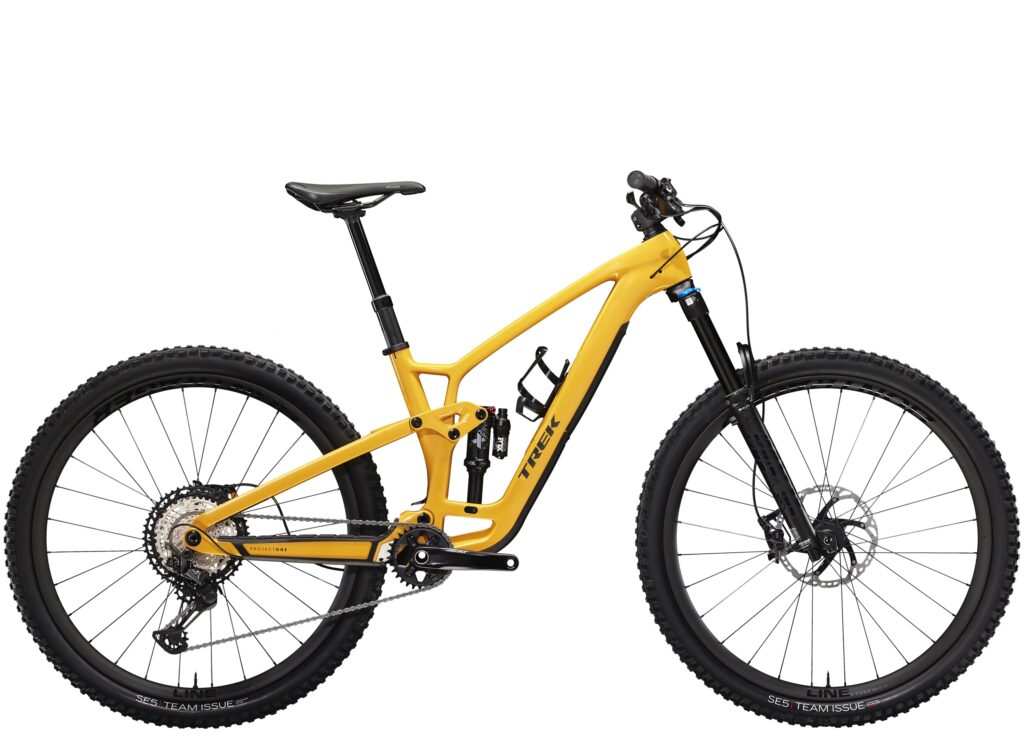
Trek Fuel EX uses all kinds of geometry adjustment chips to make it work on any kind of trail.
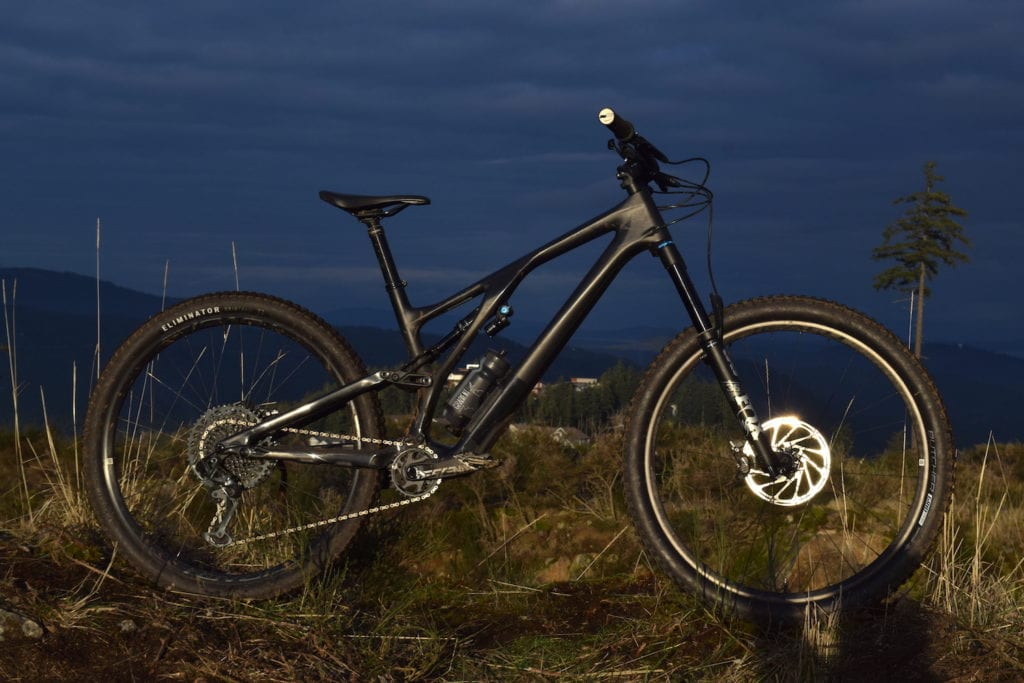
Specialized Stumpjumper was one of the earlier bikes to add geometry adjustments and a MX wheel option.
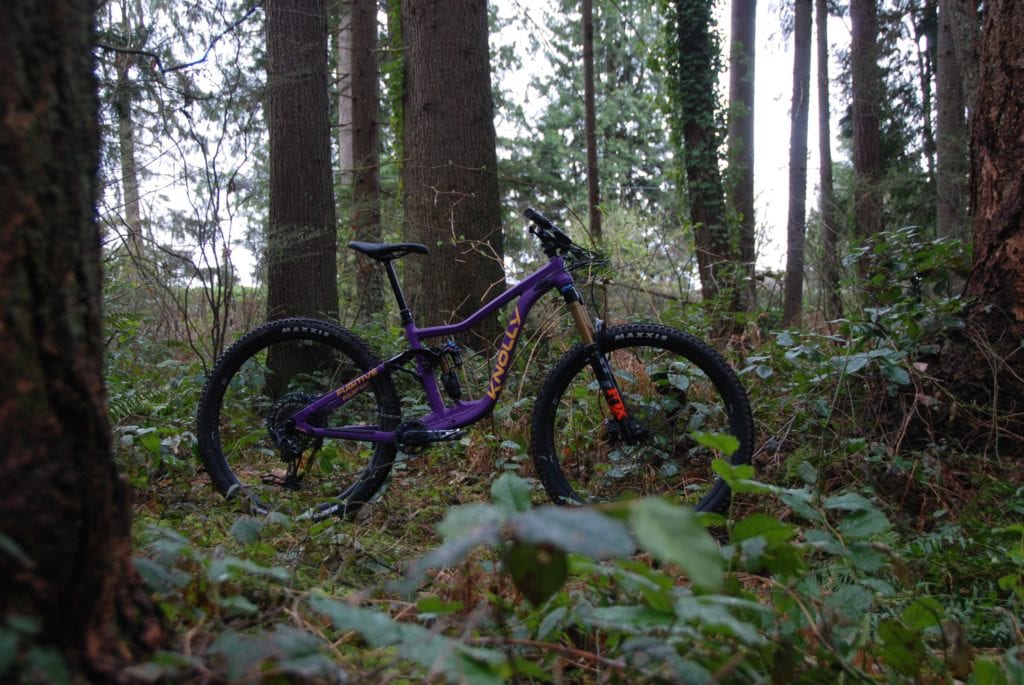
Knolly Fugitive 138 is just shy of 140mm rear wheel travel, but uses a big 150-mm fork

Norco Sight takes the Optic design and adds travel

Canyon Spectral CLLCTV is a dedicated mixed-wheel bike
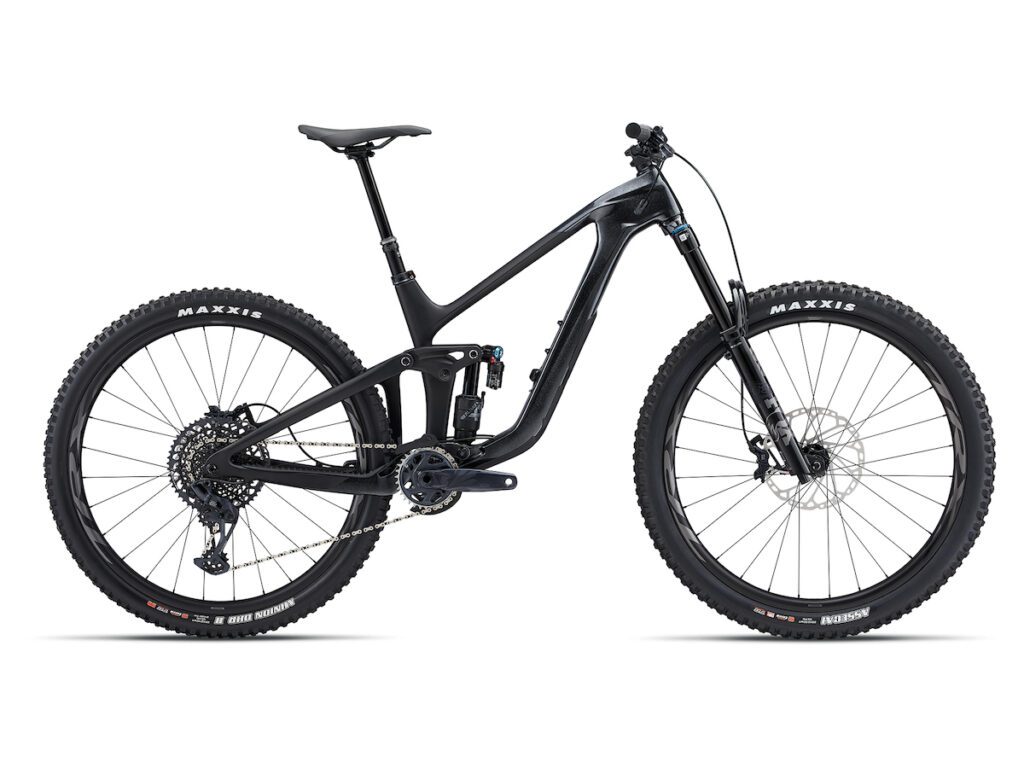
Giant Reign always toes the line between trail fun and enduro speed
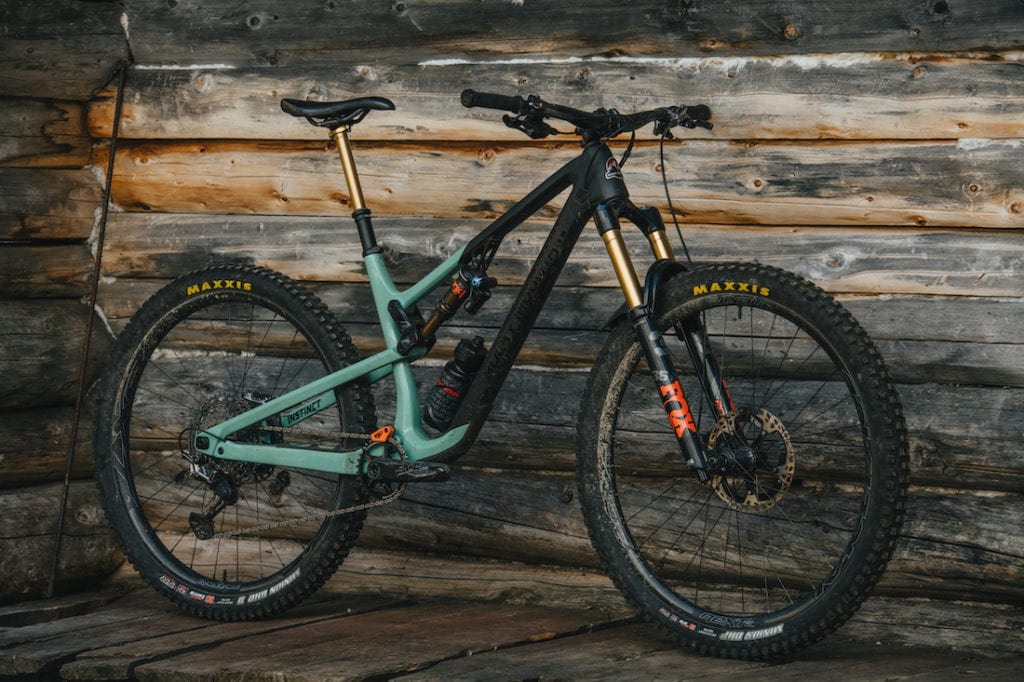
Rocky Mountain Instinct.Photo: Margus Riga
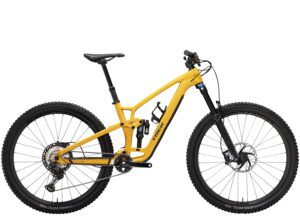
Trail bikes (mid-travel and long-travel)
Trail bikes are the broadest category of mountain bike. They cover all kinds of riding styles and all manner of different trails. Basically, anything that’s not a cross country bike or specifically designed as an enduro race bike can be a trail bike. As the average travel numbers have grown, short-travel trail bikes have split off as a specific niche within the broader trail bike category. But mid- and long-travel trail bikes remain as the do-it-all mountain bike. Trail bikes can still be reasonably good at pedaling, but they also have enough suspension to let you hit basically any trail you want, including larger jumps and features. They have bigger tires, 27.5″ or 29″ wheels (or one of each), tougher suspension, bigger brakes and longer-travel dropper posts.
Examples: Specialized Stumpjumper EVO , Trek Fuel EX , Rocky Mountain Instinct , Canyon Spectral , Norco Sight , Giant Reign , Knolly Fugitive 138

XC Trail vs. Short-travel trail? Look to the components
So, what is the difference between an “XC trail” and “short-travel trail” bike? They both approach a similar travel range, but from opposite directions. XC trail makes a cross country bike more capable, without losing efficiency. Short-travel trail bikes take the idea of a trail bike and make it more efficient without losing toughness.
One feature that sets XC trail and short-travel trail bikes apart is to look at the components. While drivetrains are now relatively universal, Shimano XT will work as well on an enduro bike as it does on a XC race bike, other components are more specific. Trail bikes will use forks with wider stanchions (like the Fox 36 on some Norco Optic and Canyon Spectral 125 models) versus lighter forks on XC Trail bikes (like the RockShox SID on a Norco Revolver 120 or Fox 34 on a Rocky Mountain Element). XC trail bikes may use smaller brake rotors or two-piston calipers instead of four-piston brakes and may also use shorter-travel dropper posts compared to trail bikes. Tires are also likely to be heavier and have more aggressive treads on short-travel trail bikes versus the fast-rolling tires on an XC trail bike.
Which you prefer will depend on how you approach your riding. If you like the idea of a cross country bike but want something tougher, XC trail is probably the way to go. It will still be fast and efficient, but more fun to ride on more aggressive trails. On the other hand, if you like to hit jumps and bash through rocks but you want something more precise, or your local trails don’t demand 150mm of travel, a short-travel trail bike could be right for you. It’ll still be tough, and it’s still designed to put descents first, but it will likely be a bit heavier and have slower tires than an XC trail bike.

- Email address: *
- Email This field is for validation purposes and should be left unchanged.
- MAGAZINE OFFERS
- BIKE INSURANCE
- Best Products
- Maintenance
- Accessories
- Long-Term Reviews
- First Look Friday
- Bike of the Week
- Tech Features
- Routes and Rides
- Bike Galleries
- BikeRadar Bargains
- Buyer's Guides
- Fitness & Training
- Sizing & Fit
- Mountain Biking UK
- Cycling Plus
- BikeRadar Podcast
Best trail mountain bikes 2024 | 27 of the best trail MTBs and buyer's guide
The top trail bikes as rated by our expert reviewers, plus our buyer's guide for everything you need to know
Laurence Crossman-Emms / Our Media
Stan Portus
The best trail bikes hit the sweet spot between rowdy enduro bikes and svelte cross-country bikes, delivering performance that's equal parts fun and super-capable.
This has made trail bikes an incredibly popular category among the best mountain bikes in recent years. They give you a bit of everything, and open up the widest range of trails and riding when compared to other types of mountain bike.
The flipside is that choosing the best trail bike for you can be quite a bewildering prospect – there are simply so many options on the market.
Fortunately, you've come to the right place because our expert mountain bike testers have spent years riding and reviewing dozens of trail bikes. This list of the best trail bikes in 2024 will help you find the perfect machine for you.
We've also put together a buyer's guide to trail bikes at the end of this list that explains everything you need to know about this type of mountain bike, from what sort of terrain they are good for to the size of disc brake rotors – we've covered it all!
Best trail mountain bikes in 2024
Whyte t-160 rs.

- £2,999 as tested
- Pros: Fast and reassuring on the descents; well-specced for the money; good climbing ability
- Cons: Seat angle could be steeper
We were so impressed with Whyte's T-160 RS that it won the title of Trail Bike of the Year 2024 .
The British brand has given the bike an almost unbelievable spec list for the money, with a RockShox Lyrik Ultimate fork and a Super Deluxe Ultimate RC2T shock used for suspension.
We found the T-160 RS performed well on rough trails, remaining calm over rocks and roots thanks to the sophisticated suspension.
It's a bit hefty at 16kg, but it tackles climbs with comfort and efficiency – although we'd have liked a slightly steeper seat angle.
- Read our full Whyte T-160 RS review
Atherton AM.130.1

- £7,800 / $7,735 / €7,345 as tested
- Pros: Impressive suspension; agile and composed ride feel; head-turner
- Cons: Pricey; not the latest spec for the price
Atherton's AM.130.1 is made using an additive construction technique that sees carbon tubes connected with 3D-printed titanium lugs, enabling the brand to offer the bike in 22 frame sizes.
A DW6 linkage gives the bike a good balance of sensitivity and support, with its small-bump compliance making trail imperfections disappear without losing response to direct inputs.
The bike comes with SRAM's X01 mechanical groupset, which is far away from the electronic groupsets usually found at this price point.
- Read our full Atherton AM.130.1 review
Boardman MTR 8.9
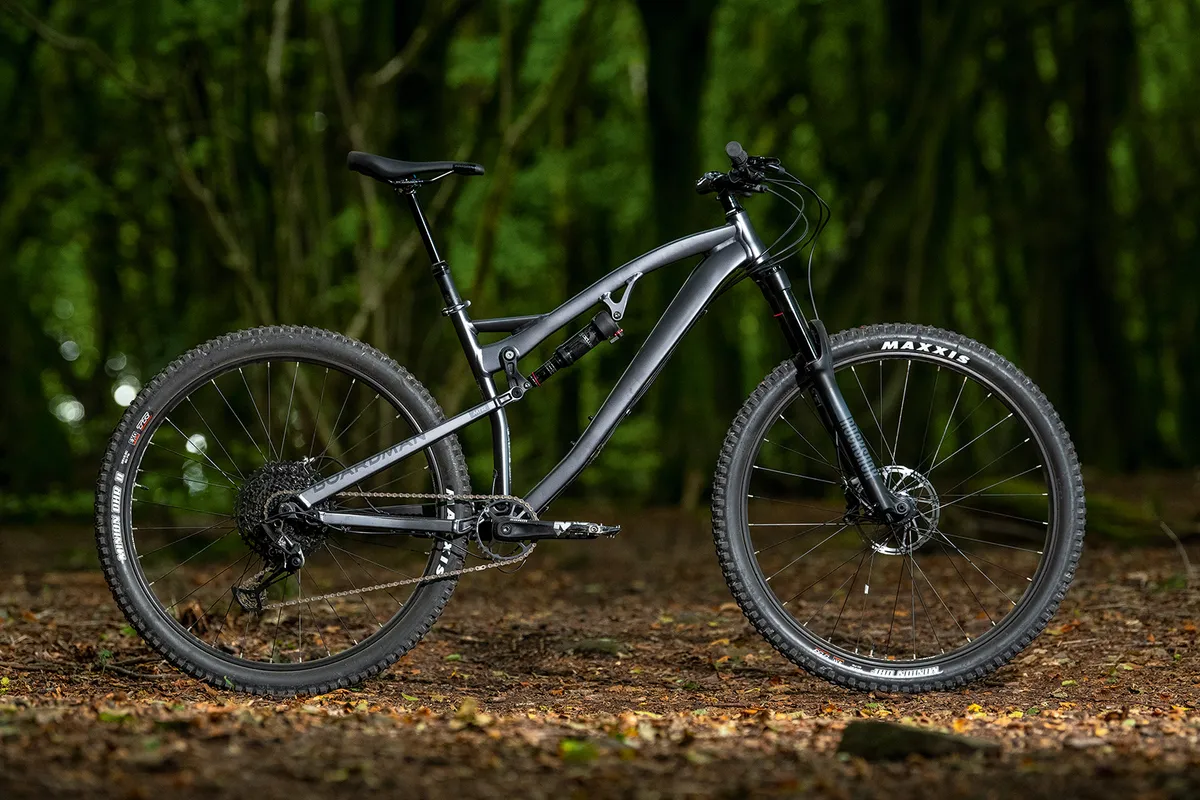
- £1,750 as tested
- Pros: Fantastic all-rounder
- Cons: Limits become clear on extreme terrain
The Boardman MTR 8.9 has the same geometry and suspension as the pricier MTR 9.0.
It has a well-chosen spec that balances cost, performance and strength, with a RockShox front fork, a SRAM NX Eagle drivetrain and Maxxis tyres.
The triple-butted alloy frame looks purposeful and has externally routed cables, making for easy maintenance. There is a bottle mount too, but we found there to be minimal clearance.
The geometry is modern but not extreme with a generous reach, leading to a comfortable ride.
You do have to shift your weight forward to keep front-wheel traction over tricky ascents, and downhill the bike is fairly noisy. So really this is a bike for speedy trail centre rides, rather than super-challenging terrain.
The bike is also ripe for upgrades and, with a few parts swapped out, we think it would be great as a lightweight, mile-munching machine.
- Read our full Boardman MTR 8.9 review
- Buy now from Halfords
Cannondale Habit 4
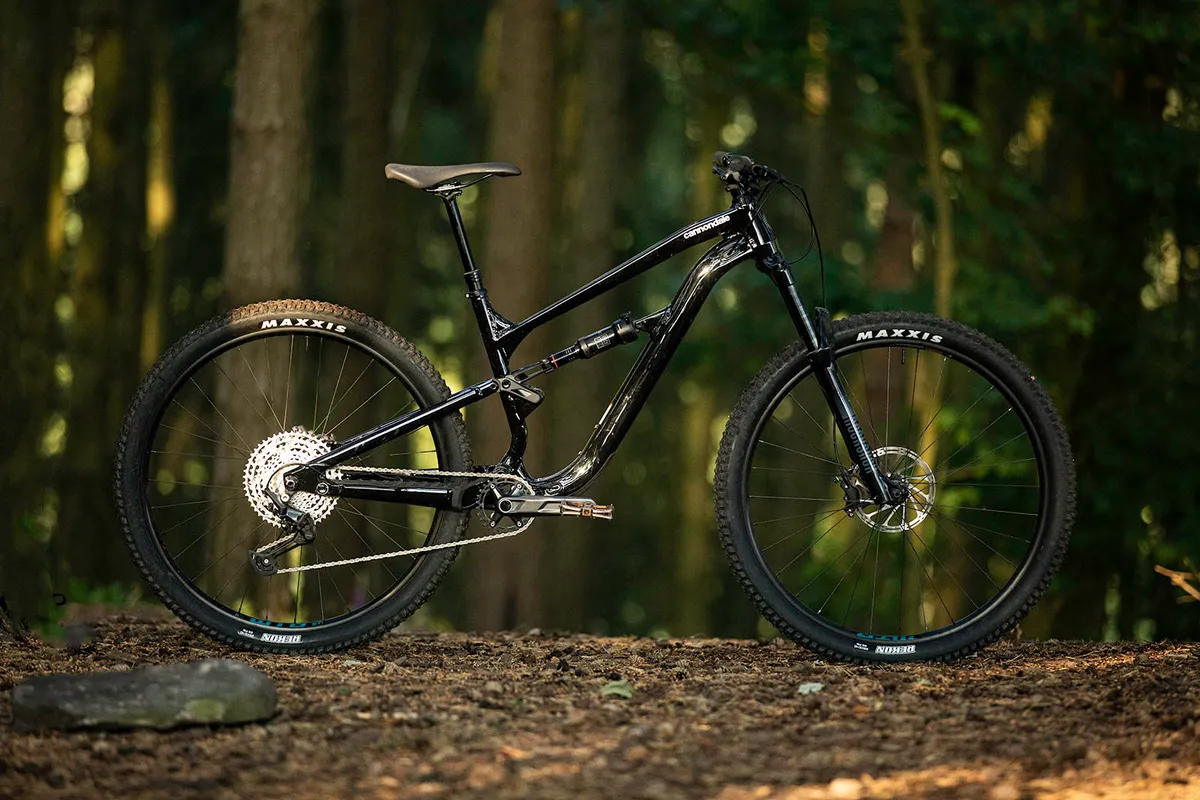
- £2,300 / $2,300 / €2,699 / AU$4,399 as tested
- Pros: Well-balanced; confidence-inspiring ride; fun and flicky
- Cons: Shimano Deore drivetrain can be a little clunky
The Habit 4 impressed us with its playful and balanced ride feel.
Its aluminium frame features size-specific geometry, with Cannondale increasing the chainstay length with the frame size. The bike feels surefooted and quick to turn.
We found the RockShox Recon fork to bind on hard compressions, though this didn't take too much away from the performance of the bike.
A steep seat tube angle of 77.5 degrees makes winching up climbs comfortable, although the bike lacks some of the punchiness of other MTBs on this list.
Canyon Spectral CF7
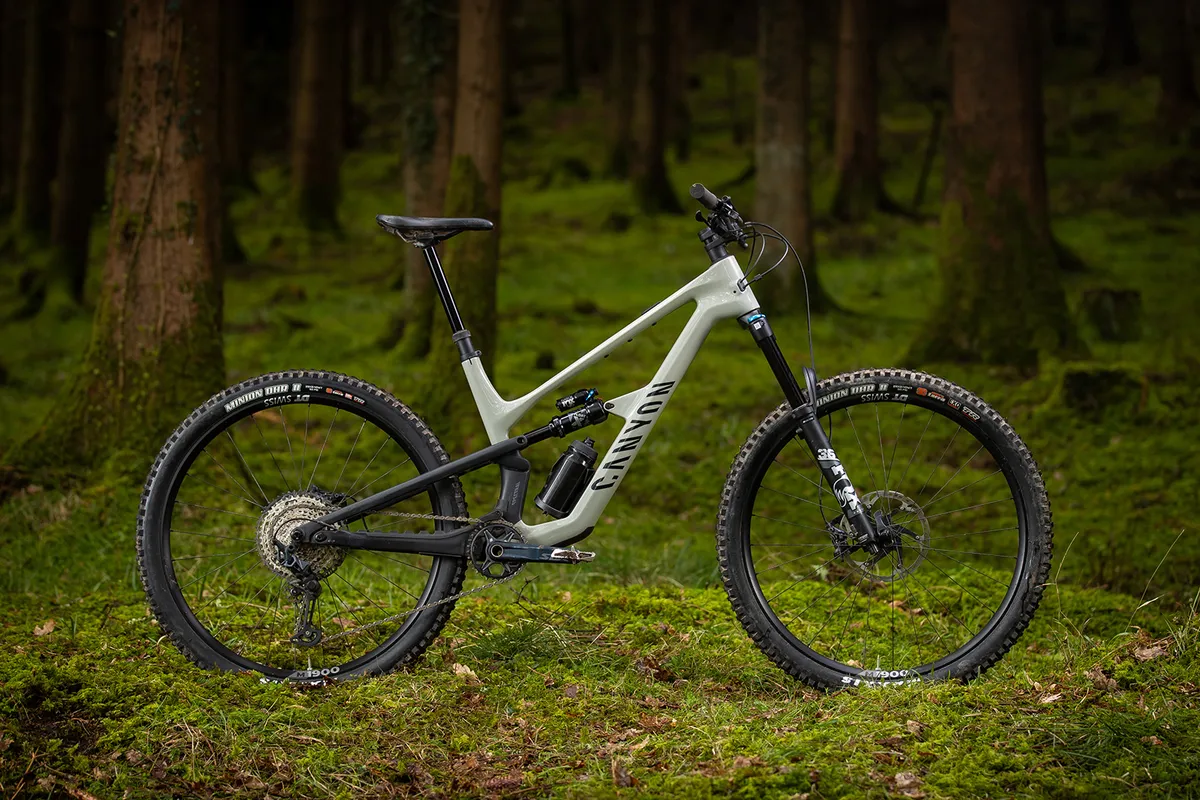
- £3,299 / $3,699 / €3,449 / AU$5.249 as tested
- Pros: Playful character that's stable at high speed; smooth, comfortable suspension; well thought-out geometry
- Cons: Fork isn't the most supportive when riding aggressively; down-tube storage doesn't feel the sturdiest
The Spectral offers impressive ground-covering ability for all-day cruises and a geometry that leaves nothing to be desired on the descents.
It's playful on all gradients and remains settled when ploughing through rough sections of the trail. This is helped by Canyon's KIS (Keep It Stable) system, which uses a pair of springs to connect the top tube and fork steerer.
The bike represents exceptional value, with a carbon frame and fantastic spec list sealing the deal.
While the Fox Rhythm 36 fork proved easy to set up, we felt it could be more supportive for aggressive riding.
- Read our full Canyon Spectral CF7 review
Canyon Neuron 5

- £1,849 / $2,099 / €1,899 / AU$2,949 as tested
- Pros: Fast-rolling on mellow trails; composed ride feel; grippy in most conditions
- Cons: Suspension feels overworked on steeper trails
Canyon's Neuron covers ground fast, with supple suspension that provides good comfort while descending, although, it can feel a tad active on steeper, technical descents.
The bike has a nimble ride feel that helps it eat up trail centre singletrack with ease, with the Schwalbe tyre combo offering fast rolling speeds.
We found the RockShox Recon fork to be a little out of tune with the rear of the bike, and not providing the desired amount of support on steeper terrain.
- Read our full Canyon Neuron 5 review
Merida One-Forty 700
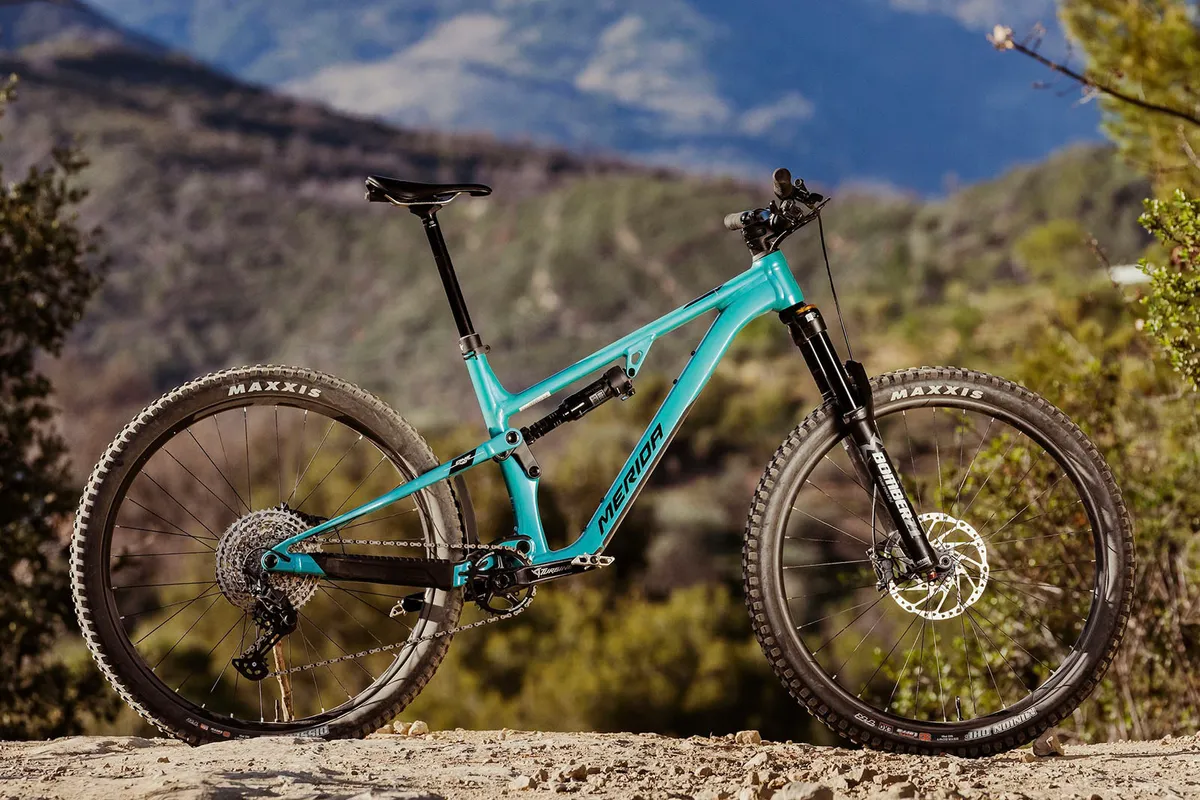
- £3,100 / €3,869 / AU$4,599 as tested
- Pros: Boundary-pushing geometry options; one of the best climbers out there
- Cons: Stem could be shorter; not the smoothest ride
The Merida One-Forty 700 impressed us in testing, winning our Trail Bike of the Year 2023 award.
The carbon fibre frame, which is shared with the longer-travel One-Sixty , uses flex stays in the rear linkage and provides 140mm of rear travel.
Merida has packed serious value for money into the bike, with a RockShox Deluxe Select+ rear shock and a 150mm Marzocchi Z1 fork.
On climbs, the bike has zero wallow and a perky attitude, making the uphills easier than on its contemporaries.
Downhill, the geometry is spot on with composed and accurate handling adding to the ride.
- Read our full Merida One-Forty 700 review
Norco Fluid FS C2
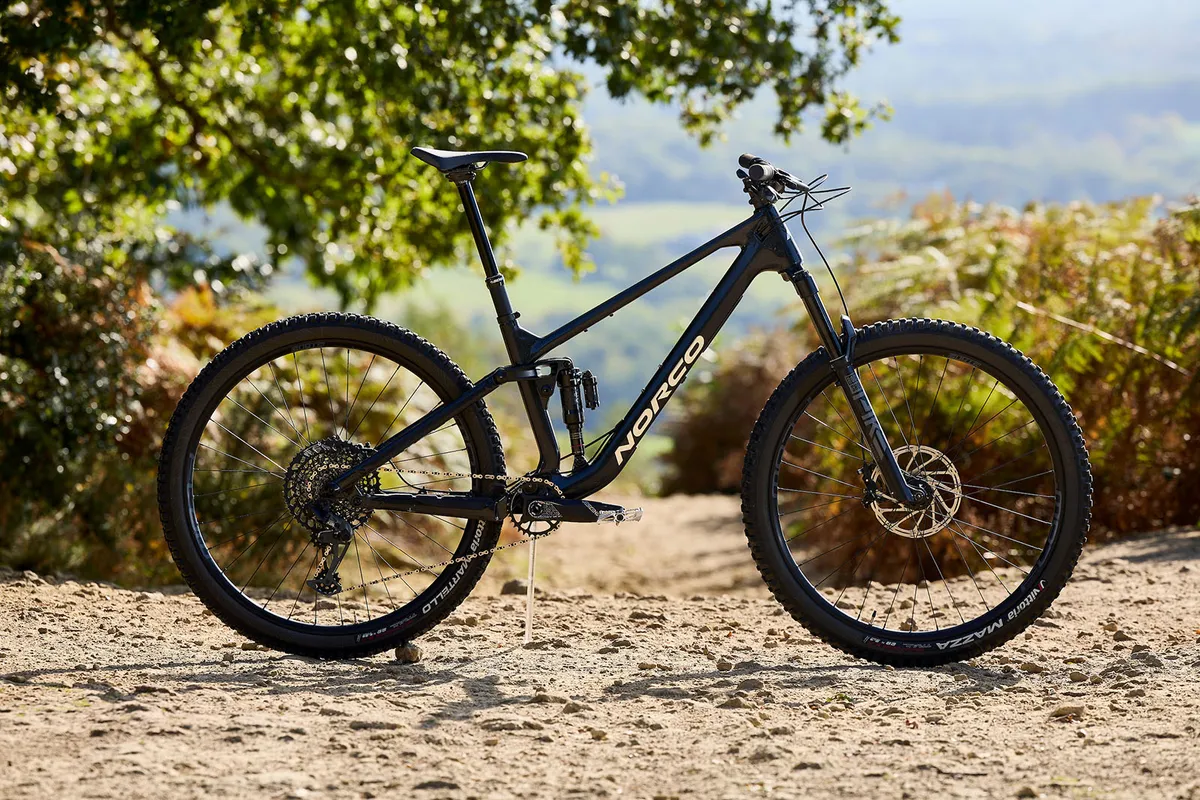
- £4,999 / $4,999 / €5,299 as tested
- Pros: Confidence-inspiring geometry; makes good use of suspension travel
- Cons: Brakes could be more powerful; tyres won't suit everyone
Norco's Fluid FS C2 has a playful agility on the trail that remains composed at high speeds.
With a 140mm RockShox Pike Select+ fork up front and a Super Deluxe Select+ controlling 130mm of rear-wheel travel, the Norco feels planted through rough terrain, balancing a poppy yet bump-gobbling ability.
We found the Fluid capable of all aspects of trail riding, but it was on the hills where it really impressed, with the bike eager to attack short, sharp climbs with grace.
Because it's able to carry a lot of speed down the trail, the SRAM G2 RS brakes feel a little under-gunned in some situations, with the bike deserving of more powerful brakes.
- Read our full Norco Fluid FS C2 review
YT Jeffsy Core 1
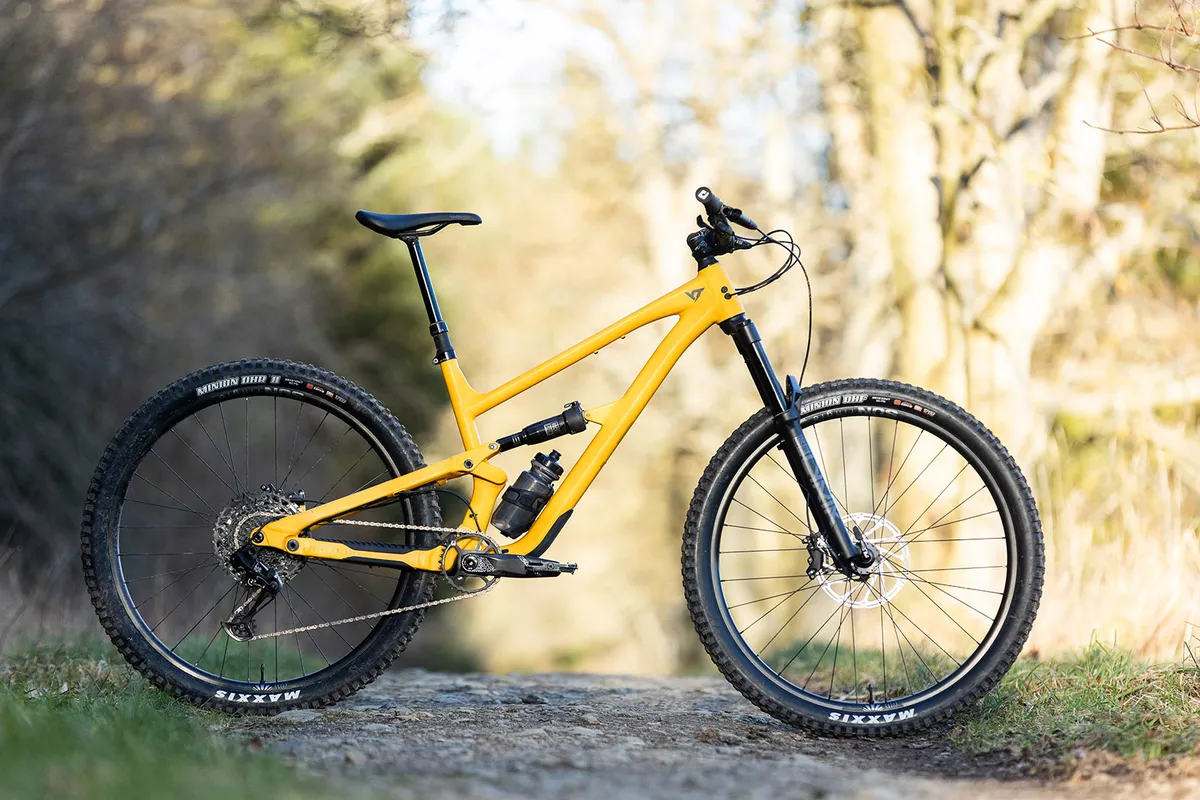
- £2,499 / $2,799 / €2,499 as tested
- Pros: Confidence-inspiring geometry; good spec for the money; fork performs well
- Cons: It's not the the lightest
YT's entry level to the Jeffsy range offers the value for money often associated with the German direct-to-customer brand.
The bike offers impressive capability, tackling enduro trails with ease while remaining playful on mellower trails.
A centred riding position gives you plenty of confidence to push the bike to the limit on the descents. A steep 77.9-degree seat angle puts your weight over the BB, helping on technical climbs.
It's not the lightest trail bike we've tested, but we feel this is less important with it sitting towards the more aggressive side of the segment.
- Read our full YT Jeffsy Core 1 review
Boardman MTR 9.0

- £2,000 as tested
- Pros: Rides with confidence and has excellent brakes; RockShox fork and rear shock
- Cons: Contact points detract from overall package
The MTR 9.0 is Boardman's flagship mountain bike, with an upgraded alloy frame, 150mm RockShox fork, a Deluxe Select+ rear shock and a groupset that is, by and large, comprised of Shimano SLX-level parts.
The bike is happiest heading downhill, where it feels planted, and the Shimano SLX four-piston brakes provide a whole load of stopping power.
The MTR climbs reasonably well. The relatively steep seat-tube angle helps you get your weight over the bottom bracket, and the wide-ranging 10-51 tooth cassettes help winch you up the toughest climbs.
The bike has a dropper post, which is great for such a gravity-focused bike, but the dropper lever is a bit small and not the easiest to use.
The bike rides with more confidence than you might expect and, apart from the dropper lever, there really isn't much to fault.
- Read our full Boardman MTR 9.0 review
- Buy now from Tredz
Boardman MTR 8.8
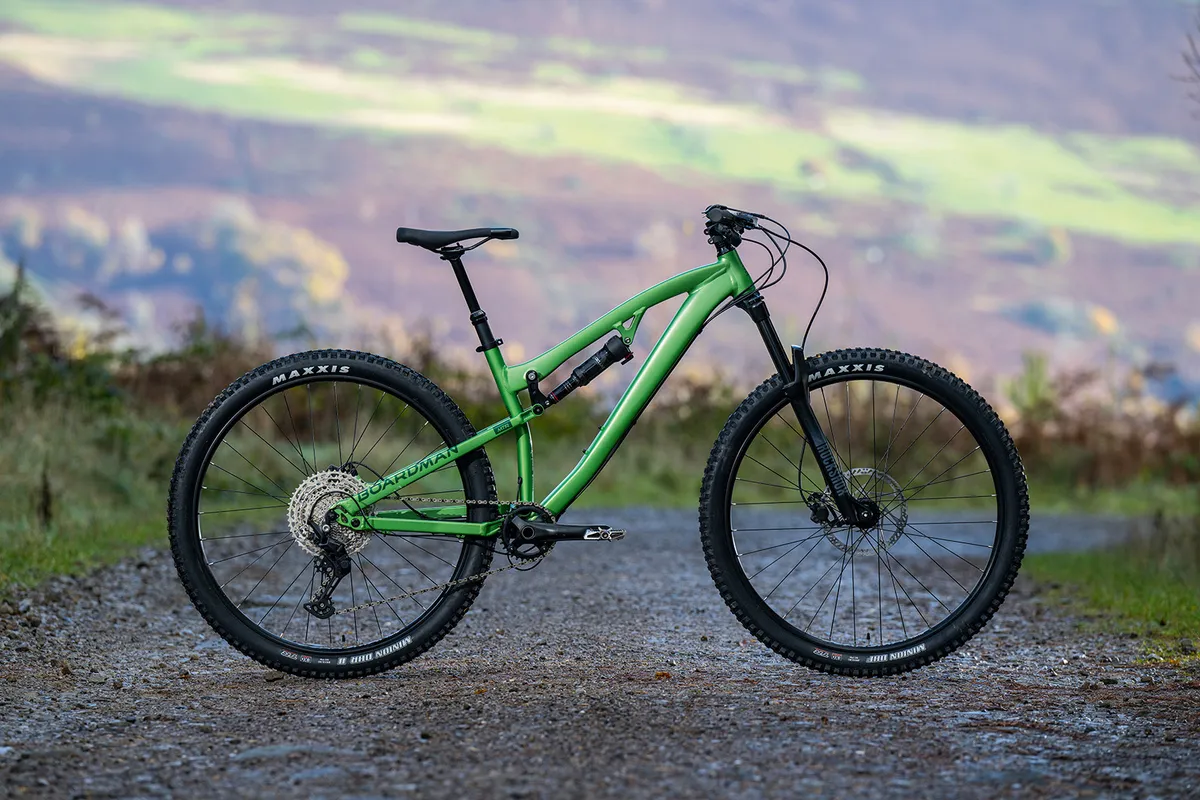
- £1,350 as tested
- Pros: Impressive spec for the price; good suspension feel
- Cons: underpowered brakes; dropper post length
Boardman's MTR 8.8 is built to be the ideal all-round UK trail bike. It's very capable when pointed down a trail, thanks in part to the 145mm of rear suspension controlled by a RockShox Deluxe Select+, and 150mm RockShox Recon Silver RL fork.
Considering its suspension travel, it climbs very well, but it's the descents where the Boardman shines.
In its price range, there aren't many bikes that can provide the same levels of performance. However, a couple of spec changes, such as a longer dropper post and more powerful brakes, would make the riding experience even better.
- Read our full Boardman MTR 8.8 review
Cannondale Habit LT 2

- £3,500 / $3,625 / €3,699 / AU$5,899 as tested
- Pros: Spritely and playful character; good climber; absorbs big hits well
- Cons: Basic suspension dampers aren't the smoothest
The Habit LT 2 is Cannondale's long-travel trail bike with 140mm of rear suspension travel matched to a 150mm fork upfront.
We found the bike enjoyed being pumped and pushed over tough terrain while being able to absorb big impacts when asked to.
The suspension isn't as smooth as forks that use posher dampers, but the confidence-inspiring brakes and geometry will allow you to push the bike on more challenging trails.
- Read our full Cannondale Habit LT 2 review
Canyon Spectral 125 CF 7

- £3,349 / $4,199 / €3,499 / AU$5,349 as tested
- Pros: Aggressive geometry and stiff, low-slung frame; great handling on really steep terrain
- Cons: Sluggish at slow speed on mellow terrain; thin tyres
A shorter-travel trail bike, the Spectral 125 mixes that with a 140mm-travel fork and a long reach geometry that's built for more aggressive riding. It's a different, all-carbon frame from the longer-travel Spectral bikes and saves 100g in weight.
The stiff, aggressive, low-slung frame is great for bikepark laps and climbs, but you need to increase the sag from the recommended values for the bike to handle rock gardens comfortably.
The bike navigates super-steep terrain admirably though, with the long frame helping to maintain stability. It pays to tinker with the Spectral 125's suspension settings and to ride hard to get the best out of the bike.
Want a spec upgrade? We've also tested the Canyon Spectral 125 CF8 .
- Read our full Canyon Spectral 125 CF 7 review
Carrera Titan X
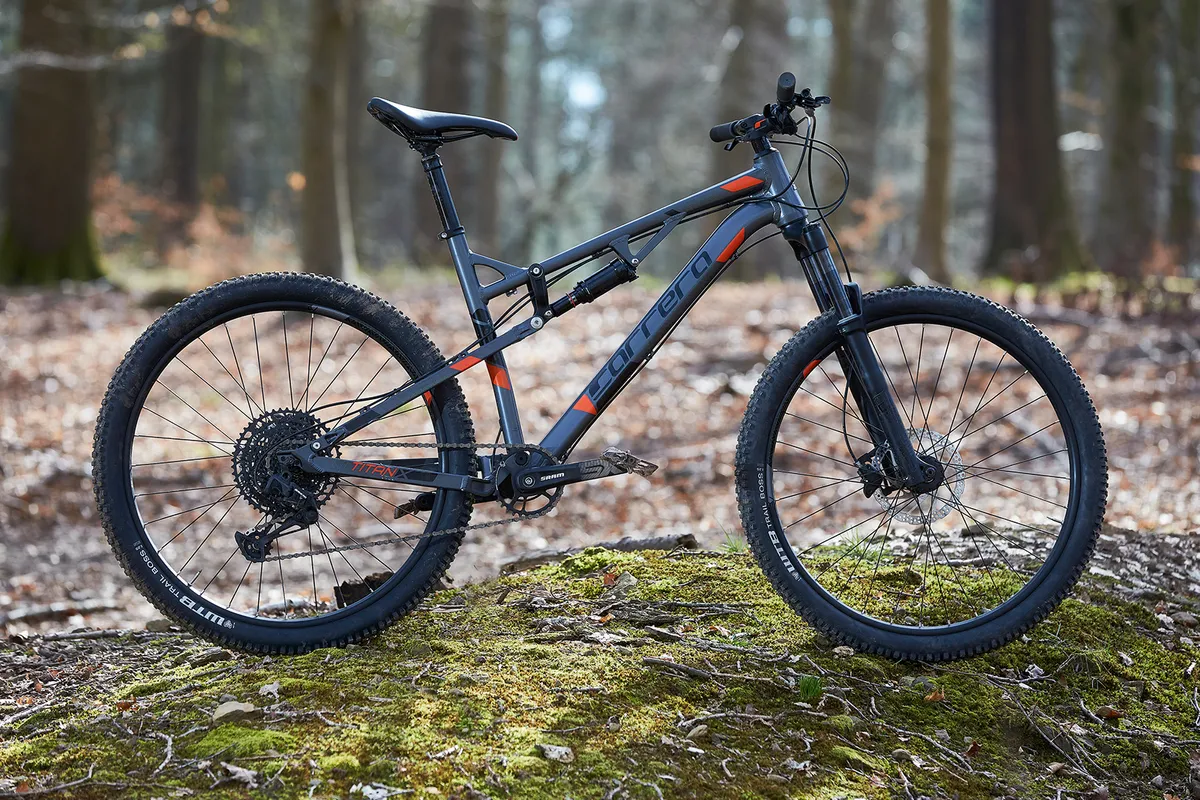
- £850 as tested
- Pros: Excellent spec for the price; a real advantage over hardtails at this price
- Cons: limited size range
Full-suspension bikes for under £1,000 are a rarity, and ones that are as well-specced as the Carrera Titan X are rarer still.
The kit on this bike is really impressive. It has SRAM SX 12-speed gearing with a 1x setup, a Trans-X dropper post and Shimano hydraulic brakes. In short, what you'd expect from a pricier bike.
When it comes to ride performance, the Titan X's suspension works surprisingly well, making this bike a good shout over a hardtail – which is normally the go-to option at this price point.
When climbing, the Titan X's frame is a little cramped due to its relatively old-school geometry, but it winches up hills better than you might expect.
The only real drawback to the Titan X is the limited sizing, and taller riders should stay clear. This is a real try-before-you-buy bike, but if it fits and you're on a budget, it's a compelling option.
- Read our full Carrera Titan X review
Cotic Jeht Silver Mullet
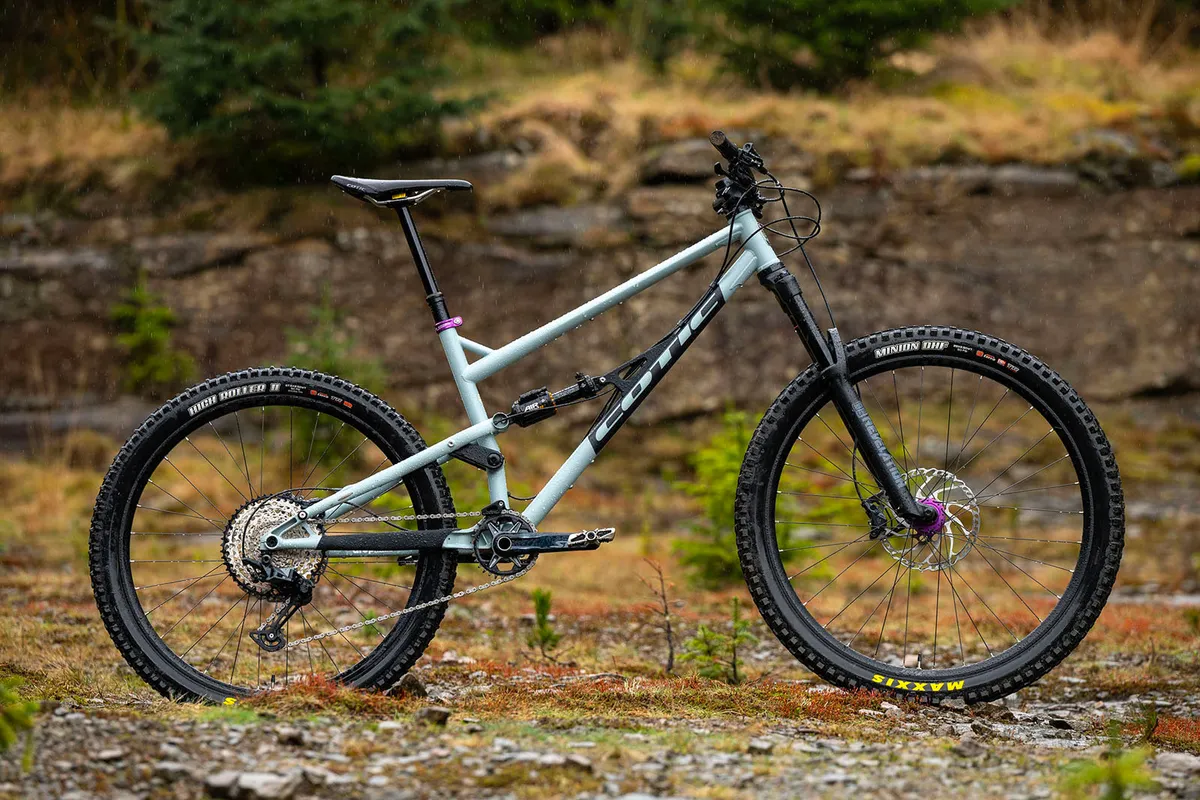
- £3,989 as tested
- Pros: Composed and confident; smooth feeling suspension
- Cons: Stiff suspension under braking; feels large
The Cotic Jeht is made from Reynolds 853 steel with a steel-alloy rear triangle that has 140mm of suspension travel.
Its long, low and slack geometry is on point and allows you to let the bike run through the techiest of sections while still feeling in control.
The Jeht is a fairly tall bike, and when braking the rear suspension isn't as good as some of the competition, especially those bikes using a four-bar design.
The spec can be matched to your pockets, with our test bike featuring an upgraded RockShox Revelation fork with a Charger 2.1 damper.
- Read our full Cotic Jeht Silver Mullet review
Focus JAM 8.9

- £4,799 / €4,699 / AU$6,999 as tested
- Pros: Impressive suspension maintains ground contact well; clever internal frame storage
- Cons: Hefty weight; complicated stem design
With 150mm of travel, the JAM 8 series bikes get a carbon front triangle with neat internal storage and share geometry with the alloy JAM 6 series. There's also tidy internal routing through the stem for the cables.
The new suspension design, with its flip chip, leads to a better-supported mid-stroke than Focus's older system, leading to a more playful ride and less chance of bottoming out. It also helps keep contact with the ground well at the rear on descents.
The mix of agile handling and stable suspension leads to an exciting ride, and it's easy to pick and change your line, although the Fox 36 Performance fork feels more limiting than the rear travel.
- Read our full Focus JAM 8.9 review
GT Sensor Carbon Pro

- £4,199 / $4,750 as tested
- Pros: Incredibly supple suspension; well-balanced geometry; comfortable and confident handling
- Cons: Not the most perky climber; drivetrain spec is lacklustre
The Sensor Carbon Pro has 140mm of rear-suspension travel married to a 150mm fork up front.
We found the bike made good use of the travel, with the quality RockShox suspension providing smooth and supple bump absorption.
On steeper more technical tracks, the Sensor Carbon Pro performs excellently but it's climbing performance isn't as spritely as other trail bikes.
- Read our full GT Sensor Carbon Pro review
GT Sensor Carbon Pro LE
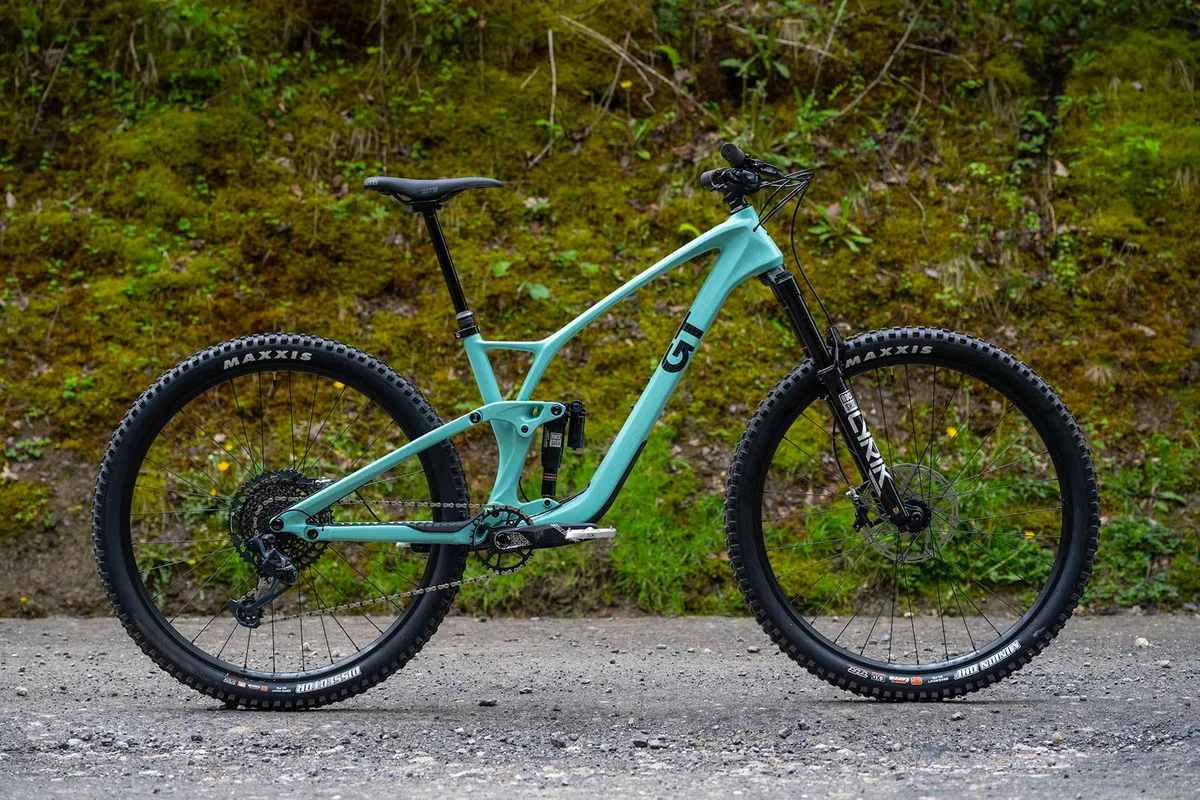
- £5,000 / $5,750 as tested
- Pros: Great for rowdy trail riding; RockShox suspension works very well; ideal for those looking for simplicity
- Cons: Freehub engagement is clunky; SRAM G2 RSC brakes struggle with power down steep trails
GT's Sensor Carbon Pro LE feels very capable on rougher trails considering its suspension travel, with the 150mm fork and 140mm rear-suspension travel combination providing a composed ride on gnarly trails.
The Sensor certainly prioritises downhill prowess, with the bike remaining poppy and responsive whatever the gradient.
The RockShox Lyrik Ultimate fork and Super Deluxe Ultimate shock provide composed damping, but SRAM's G2 RSC brakes are a little lacklustre when shedding speed.
- Read our full GT Sensor Carbon Pro LE review
Kona Honzo ESD
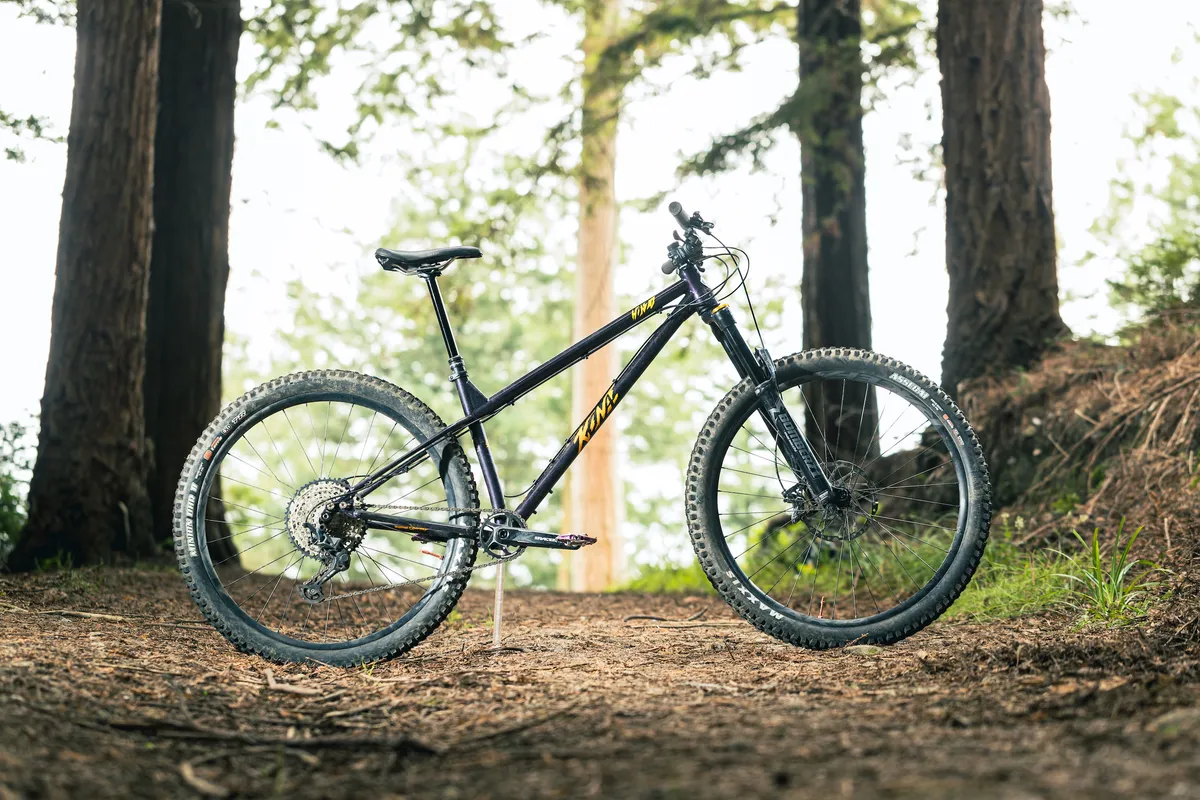
- £2,899 / $3,099 / €3,299 / AU$4,399 as tested
- Pros: Very smooth ride over the rough stuff; descends better than a hardtail should
- Cons: Not great value for money
It may be a hardtail, but the Kona Honzo is long and slack enough to handle the steepest descents, with a braced steel frame, 150mm-travel fork and plenty of room for aggressive rubber. Adjustable rear dropouts enable you to fine-tune your ride or go singlespeed.
There's bags of stability on steep descents and the bike is great at carving wide corners, but shorten the rear end and direction changes come really easily. You've got a 203mm rotor at the front and 180mm out back to help control your speed.
The Honzo's steep 77.5-degree seat tube helps with climbing and it's got plenty of room for the long-travel TransX dropper post.
We were impressed by the climbing performance, aided by a 30t chainring and a wide-range 10-51t cassette, while the bike's length means you can shift your weight around both up and downhill. It's a hardcore hardtail that shows you don't need suspension out back to have fun.
- Read our full Kona Honzo review
Marin Rift Zone XR 27.5

- £3,095 / $3,500 / €3,499 as tested
- Pros: Well-designed frame; excellent rear suspension
- Cons: Brakes lack bite; not the best climber
The Marin Rift Zone XR is built on the alloy Rift Zone frameset which provides top-notch rear suspension while prioritising front-end control.
The Fox Float X rear shock works well to support the rear end, giving the bike playfulness without sacrificing grip.
The bike's poppy character makes for an engaging ride, though the bike requires rider attention on gnarlier sections of trail.
A 'sit up and spin' attitude to climbing is provided by the upright and relaxed position, with the bike featuring more pedal bob than its competitors.
- Read our full Marin Rift Zone XR 27.5 review
Marin Rift Zone 29 XR

- £3,775 / $3,899 / €4,289 / AU$5,499 as tested
- Pros: Fast and stable at speed; clever spec choice; impressive on technical terrain
- Cons: Not the best climber; freehub engagement could be better
Marin's Rift Zone 29 XR is built for the descents, with the frame and suspension offering a great platform for tearing up your local forest.
With only 130mm of rear-suspension travel, the Rift Zone 29 XR proves numbers aren't everything by absorbing big bumps and providing a composed ride feel.
We found the Rift Zone 29 XR wasn't the fastest on the climbs, but it made up for this when pointed downhill.
- Read our full Marin Rift Zone 29 XR review
Merida One-Forty 500
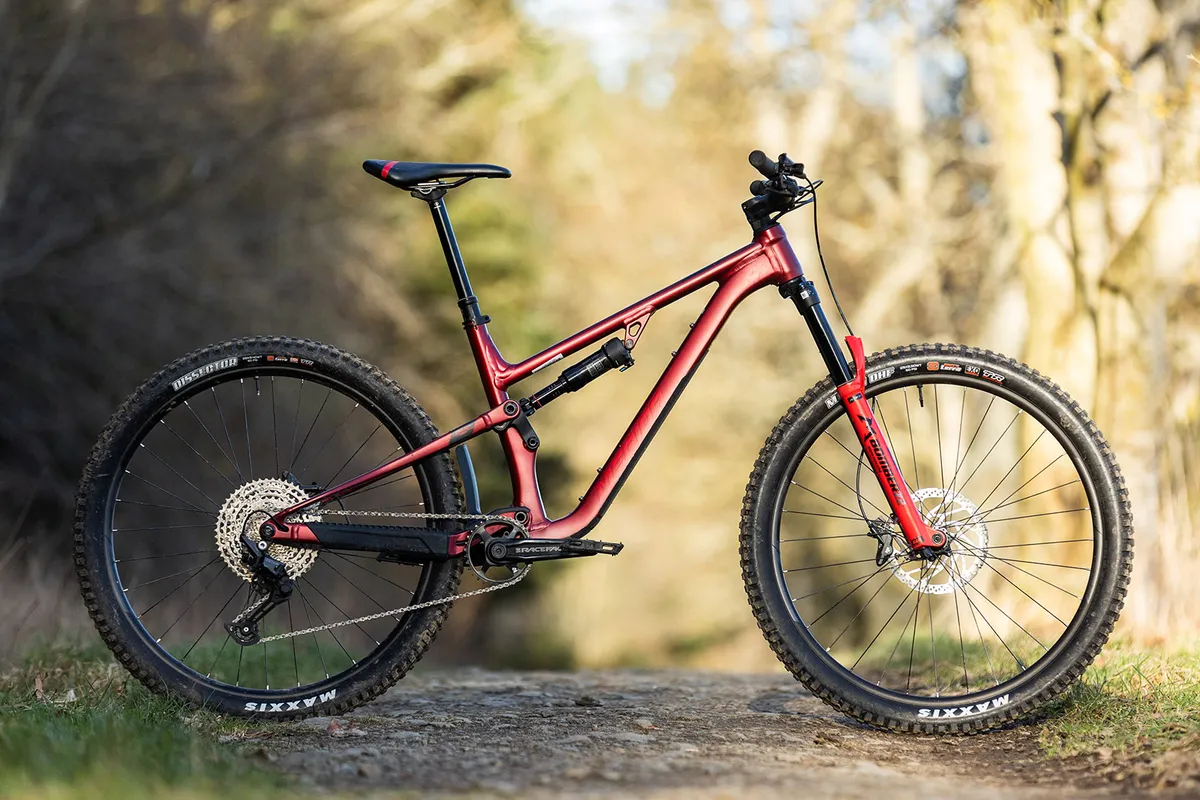
- £2,600 / €3,160 / AU$3,799 as tested
- Pros: Efficient pedalling; playful handling; good spec for the money
- Cons: Rear-end grip isn't the best in the wet; brake bite point can wander
The One-Forty 500 uses the same frame as the One-Forty 700 that we awarded Trail Bike of the Year in 2023.
At this lower price point, the bike remains an impressive performer with eager climbing characteristics and supportive suspension on the descents.
The bike offers an impressive spec for the money, though we did find the Shimano Deore four-piston disc brakes a little unpredictable, with a wandering bite point affecting the accuracy of our braking.
- Read our full Merida One Forty 500 review
Merida One-Twenty 700
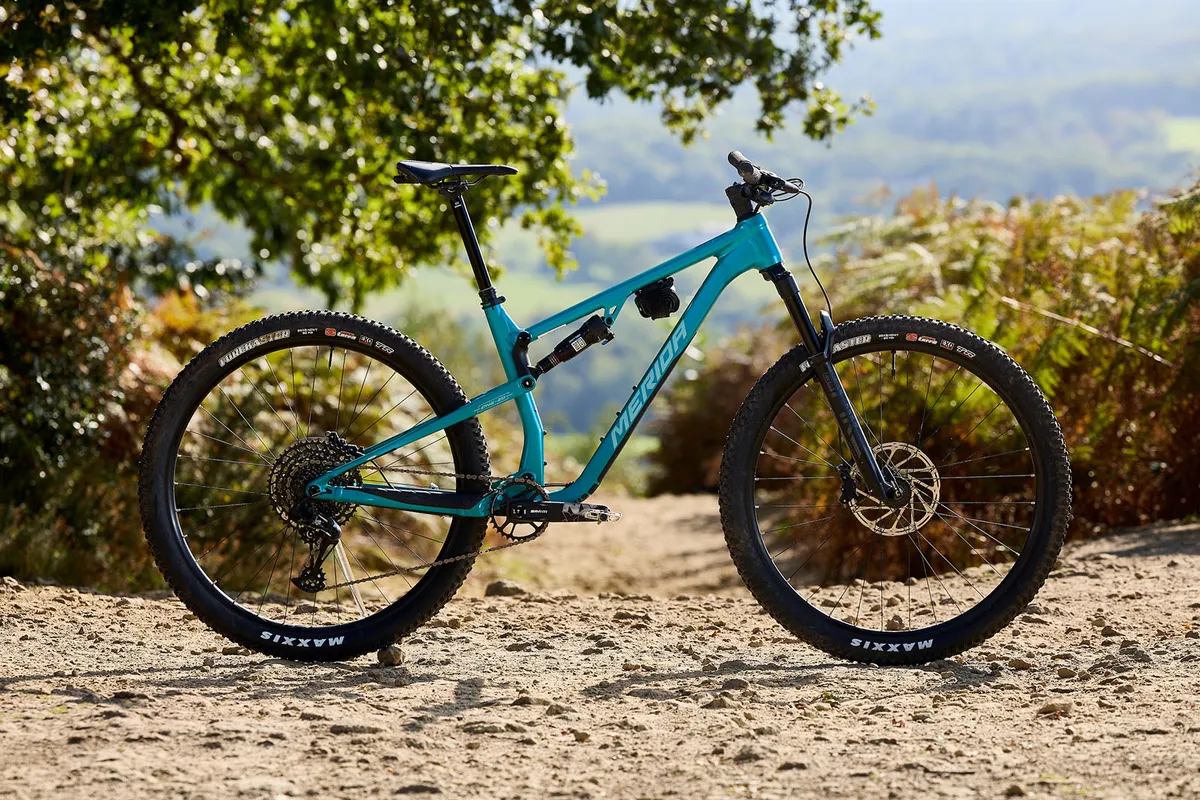
- £3,100 as tested
- Pros: Progressive suspension; confident handling; efficient pedalling
- Cons: Front end is quite harsh; brakes are average
Despite its name, the One-Twenty 700 has 130mm of suspension travel front and rear, which does a stellar job of climbing thanks to Merida's P-Flex flex-stay suspension linkage.
While the bike isn't the most composed on the downhills, the long and low geometry still eggs you on to push the brakes and tyres to their limits.
The RockShox Pike Select fork and a RockShox Deluxe Select shock work well to iron out the bumps, but the SRAM DB8 brakes feel a little underpowered when hitting the trail at full speed.
- Read our full Merida One-Twenty 700 review
Polygon Siskiu T7 29
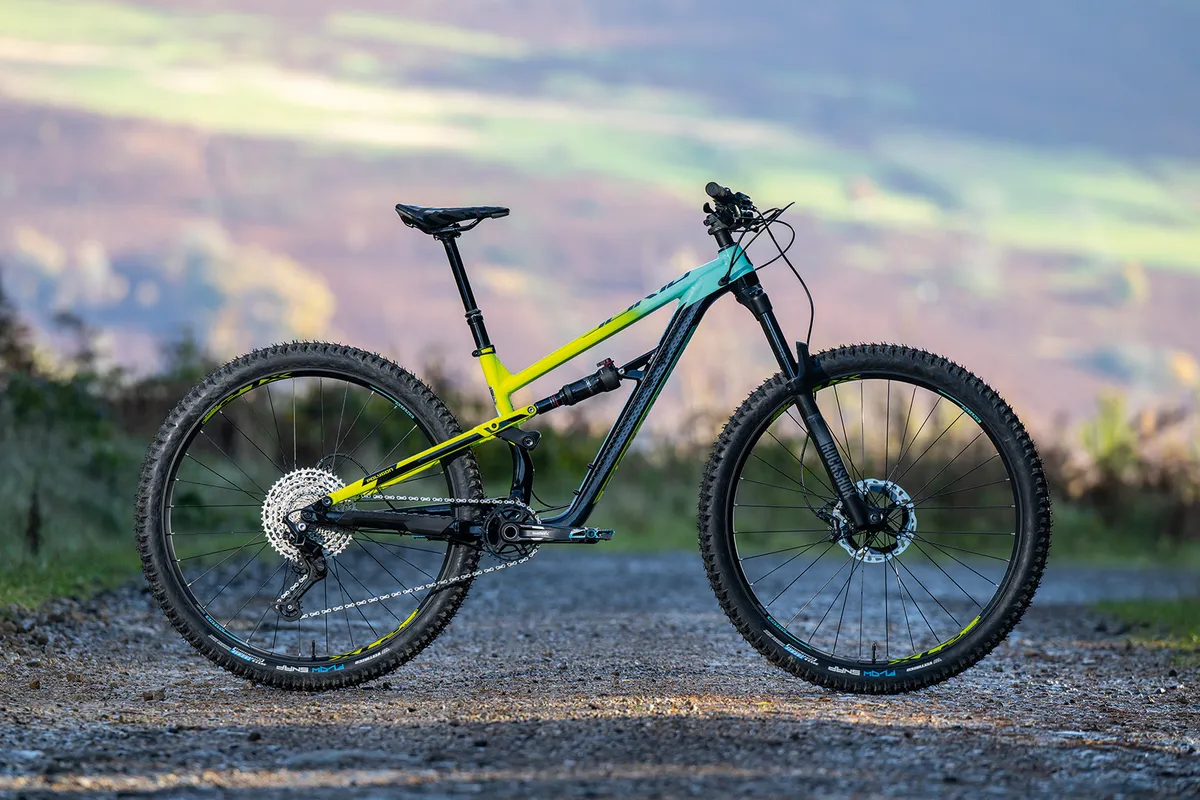
- £1,800 as tested
- Pros: Great trail geometry; impressive value for money
- Cons: Brakes are a weak point
The Polygon features modern trail geometry and decent components that make it very capable on the descents, with the 65.5-degree head angle giving confidence on even the steepest terrain.
A RockShox Deluxe Select+ controls 135mm of rear-suspension travel, while a 140mm RockShox Recon Silver RL fork supports the front. The bike comes with Shimano's Deore 1x12 drivetrain with Tektro's HD-M735 brakes.
Polygon's Siskiu will take all you can throw it, but is maybe not as responsive as bikes twice its price. If you are a GoOutdoors member, however, you can get the bike at the reduced price of £1,600.
- Read our full Polygon Siskiu T7 review
Trek Fuel EX 9.7

- £4,175 / $4,000 / €4,499 / AU$7,500 as tested
- Pros: Excellent frame; well-considered geometry; very capable with great suspension
- Cons: Poor brakes; tyres aren't the best
The Fuel EX frame provides a solid, adaptable and high-performing bedrock to the bike with the geometry and suspension design offering good confidence on the descents.
Our tester found the SRAM DB8 brakes to be a little underpowered when riding aggressively, compromising the bike on fast, technical downhill sections.
The tyres were also behind the competition, making for a less-than-precise ride feel.
- Read our full Trek Fuel EX 9.7 review
Whyte T-140 RS 29er
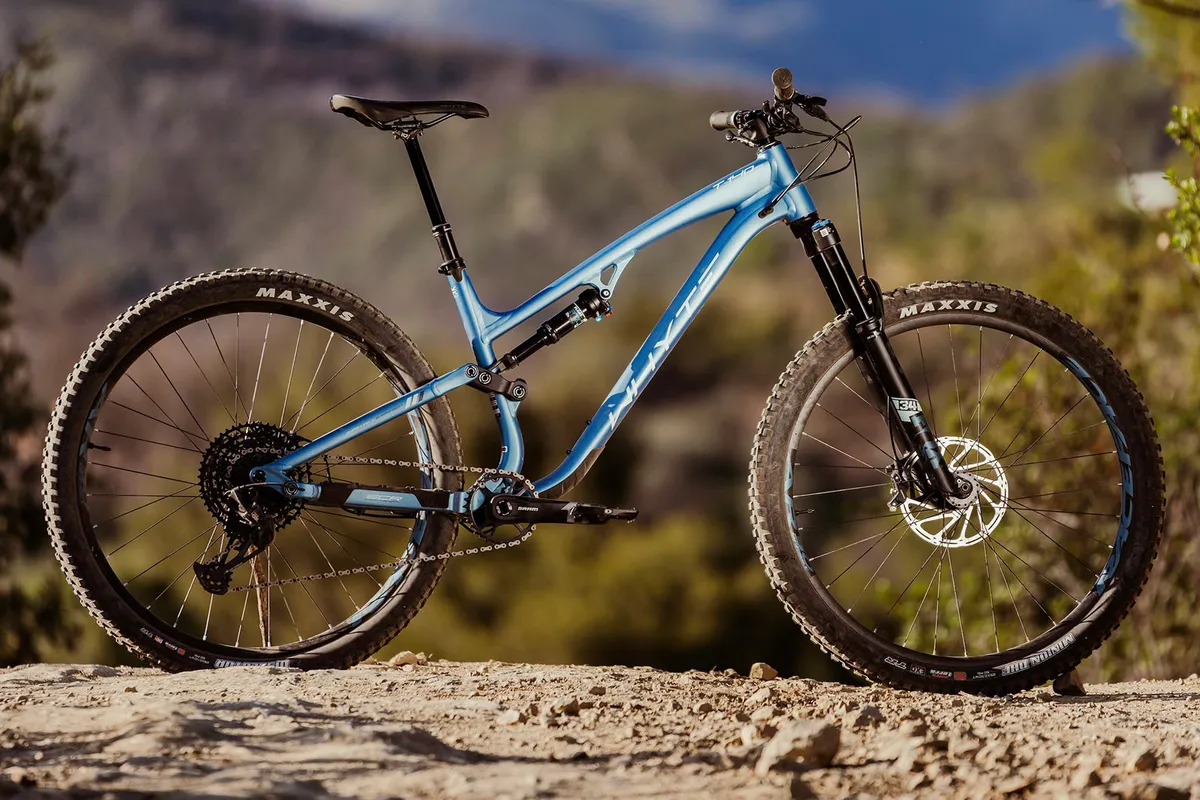
- £4,099 as tested
- Pros: Super-composed suspension; excellent pedalling characteristics
- Cons: Harder riders may push suspension to its limit; size range
Whyte's T-140 RS is a true do-it-all trail bike featuring 135mm of rear travel controlled by a Fox DPS Performance Elite shock and a 140mm Fox 34 Performance Elite fork.
The T-140 RS smoothes the way without fuss, with the rear suspension soaking up small and big hits.
The 34mm stanchion diameter of the fork becomes noticeable on seriously technical sections and can feel squirrelly under heavy braking.
The lightweight chassis helps the bike when pointing uphill.
- Read our full Whyte T-140 RS 29er review
YT Jeffsy Core 3
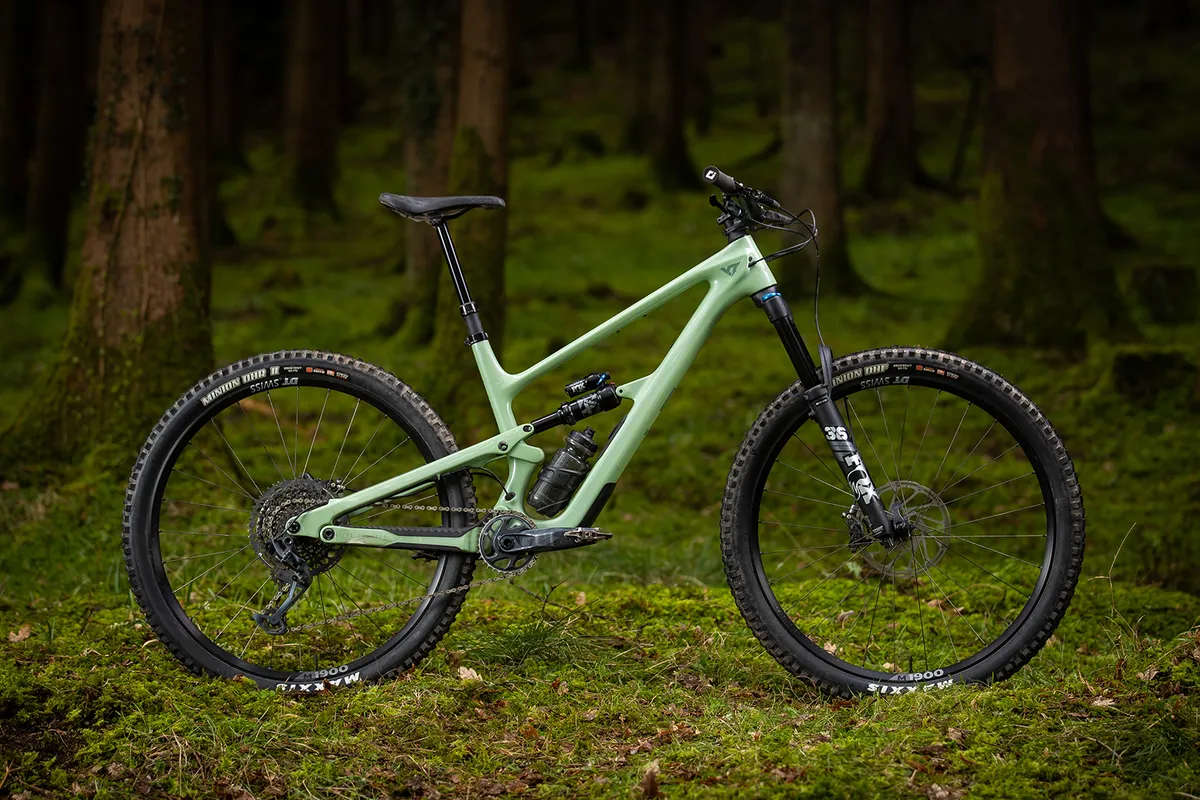
- £3,999 / $4,299 / €3,999 / AU$6,999 as tested
- Pros: Capable climber; fun handling; easy to ride on a variety of trails
- Cons: Less poppy than previous iteration
The Jeffsy performs well on the climbs, with a slight suppleness adding good traction on technical ascents, while keeping an efficient-feeling pedal platform.
Playful handling makes mellow trails entertaining, but the bike feels more mature than the previous version and remains more composed on rough terrain.
This leads to the bike being more capable downhill but at the cost of poppiness on level ground.
- Read our full YT Jeffsy Core 3 review
Why you can trust BikeRadar
BikeRadar has been an authority on bikes and cycling tech since its inception in 2007, delivering the world’s best riding advice.
We have experts testing all types of bikes, parts, clothing and accessories, from road, mountain and gravel bikes to commuting, bikepacking and electric bikes.
Our reviews are always editorially independent – with no exceptions. Our reviewers comprehensively test all products in the real world, always reflecting on performance, value and the wider market when delivering their verdicts and review ratings .
We have more than 15,000 product reviews available at your fingertips, as well as expert buying, maintenance, training, skills, health and fitness advice.
Our annual Bike of the Year test is an industry benchmark and the BikeRadar team consists of some of the most experienced riders and testers in the business.
Trail bike buyer’s guide | Everything you need to know when choosing a trail bike
What is a trail bike.

The trail mountain bike category occupies the space between lightweight, speed-focused cross-country bikes and enduro and all-mountain mountain bikes designed to fly downhill and slowly winch back to the top.
Balancing pedalling efficiency and gravity potential, trail bikes are intended to hit a sweet spot; they aren’t quite as rowdy as enduro bikes but are tougher than cross-country bikes.
They make light work of riding down flow trails with big sweeping berms and can cut it on more demanding terrain too – and you might be surprised at just how capable they truly are.
Really, trail bikes are best for mountain biking in the most general sense and are designed to give you just about enough of everything.
Trail bikes also tend to be relatively affordable when compared to other types of mountain bike. The components don’t have to be super-lightweight as on XC bikes, or heavy-duty enough to survive the rigours of downhill, which helps to keep costs down.
Although enduro and downhill bikes are considered to be the Formula 1 of mountain biking, we think trail bikes are the most important and widest-spanning category, and benefit from economies of scale where bigger production runs also play a factor in keeping prices down.
The affordability of trail bikes combined with their versatility, helps to make them an ideal choice if you’re new to the world of mountain biking or are looking for a one-bike solution to all your mountain biking needs.
What to look for in a trail bike
There are no set rules when it comes to defining what a trail bike is and, like all mountain biking sub-disciplines, they exist on a sliding scale in terms of capability, geometry, suspension travel and price.
However, there are various factors that when put together constitute a trail bike and are worth bearing in mind when looking for one of these versatile machines.
Frame material
Many brands stick to aluminium alloy or carbon fibre for trail bike frames, while some more boutique builders opt for alternative frame materials, such as steel or titanium.
Carbon has the advantage of being lighter and stronger, and can be made to be stiffer than an equivalent aluminium frame, so it's a good choice if zipping uphill and weight are priorities. It does, however, cost more than aluminium.
While it might not have the exotic feel of carbon, or be as lightweight, an aluminium frame is a good call if you’re new to the sport or on a budget, but it’s hard to argue with the desirability and performance of carbon.
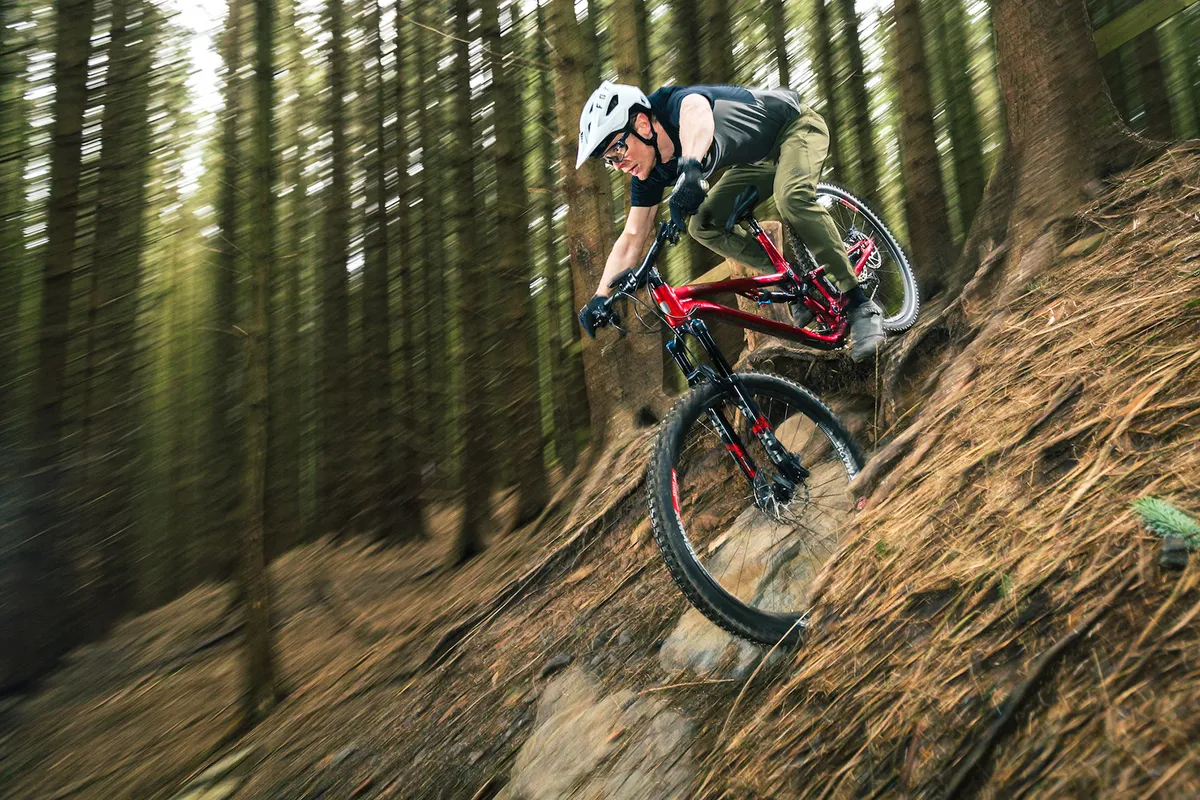
Frame geometry probably has the biggest impact on how a mountain bike handles, with even slight adjustments to the wheelbase, head tube angle and reach determining how a bike feels.
In keeping with their Goldilocks position between XC and enduro bikes, trail bikes have a relatively slack geometry that makes them capable enough to handle most rough descents, while being suitable for all-day epics and plenty of comfortable and efficient climbing.
As a general rule, trail bikes have a head tube angle of between 64 and 66.5 degrees and seat tube angle of between 73 and 78 degrees.
Look for slacker head tube angles if you want a bike that will descend better, because a slacker angle helps give the bike a calmer ride by slowing down the steering. It also makes its wheelbase longer, which helps improve stability at high riding speeds.
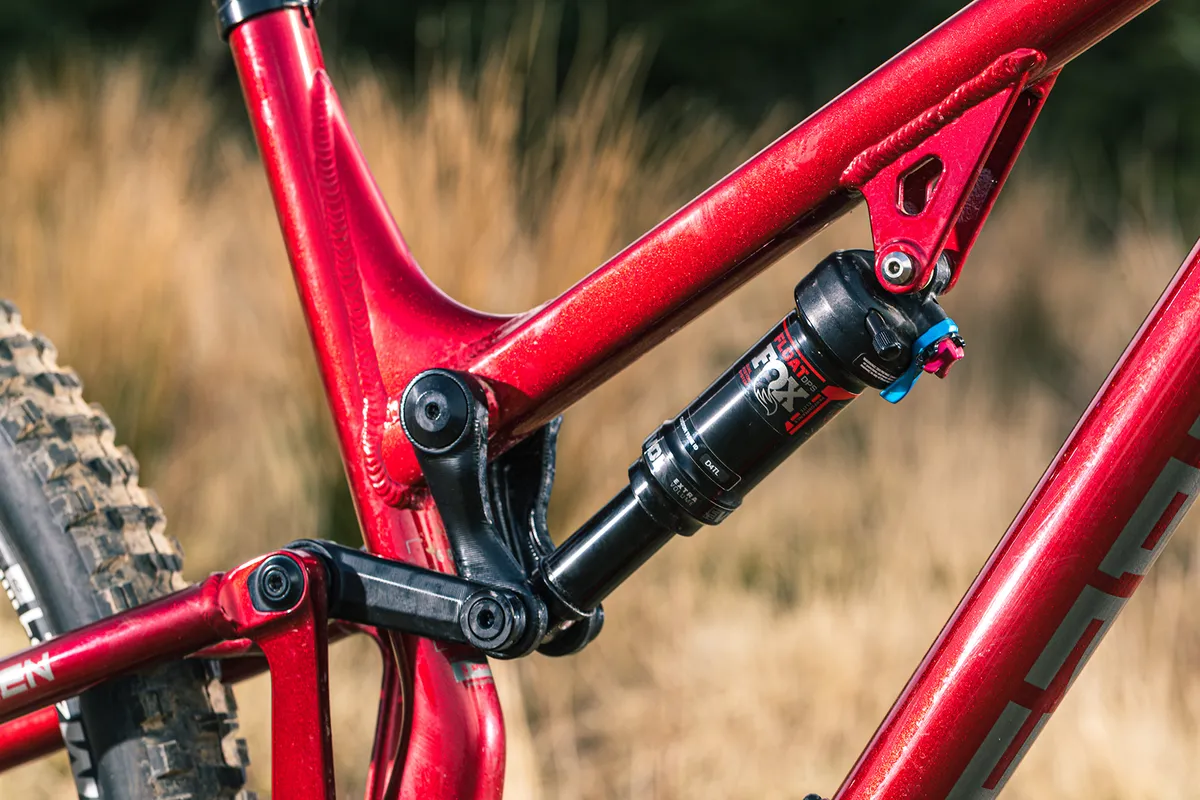
Most commonly, trail bikes have front and rear suspension with between 120mm and 150mm of travel.
As travel increases, a bike will be better suited to riding downhill and less suitable for climbing, so when considering how much travel to go for on a trail bike think about the type of terrain you'll spend most of your time riding and your riding style.
If you ride on rougher, more technical trails, or like to barrel down descents, choosing a trail bike with 140mm or 150mm is advisable.
Shorter-travel bikes won’t descend quite as well, but they are light and efficient so are a good choice if endurance riding and climbing is more your thing.
Wheel size and tyres

There used to be a time when mountain bikes simply had 26in wheels. But those days are long gone, and now mountain bikes come with either 27.5in or 29in wheels.
Both wheel sizes have their advantages and disadvantages . 29in wheels roll over obstacles and hold their momentum more, making them the preference for cross-country and the best downcountry mountain bikes . Compared to 29in wheels, 27.5in wheels are faster accelerating, stronger and more agile, with handling and placement feeling more natural too.
Trail bikes come with either of the two sizes and there isn’t really a right or wrong answer to which size wheels you should go for – you might prefer the snappier feel of 27.5in wheels or value the efficiency of 29in wheels.
One thing to bear in mind when selecting what wheel size to go for is your height. A taller rider will probably benefit from a larger wheel, whereas a shorter rider will benefit from a smaller wheel. Some manufacturers do consider this and provide models with different-size wheels depending on frame size.
Trail bike tyres tend to be chunkier with a decent amount of tread and are around 2.3 to 2.5in wide. These provide a decent amount of grip and help make trail bikes the versatile machines they are.
The best mountain bike tyres can really change how your bike feels, so it’s worth paying attention to what tyres a trail bike is specced with, but also remember that it’s not too hard to swap tyres out for something more suitable for your riding.
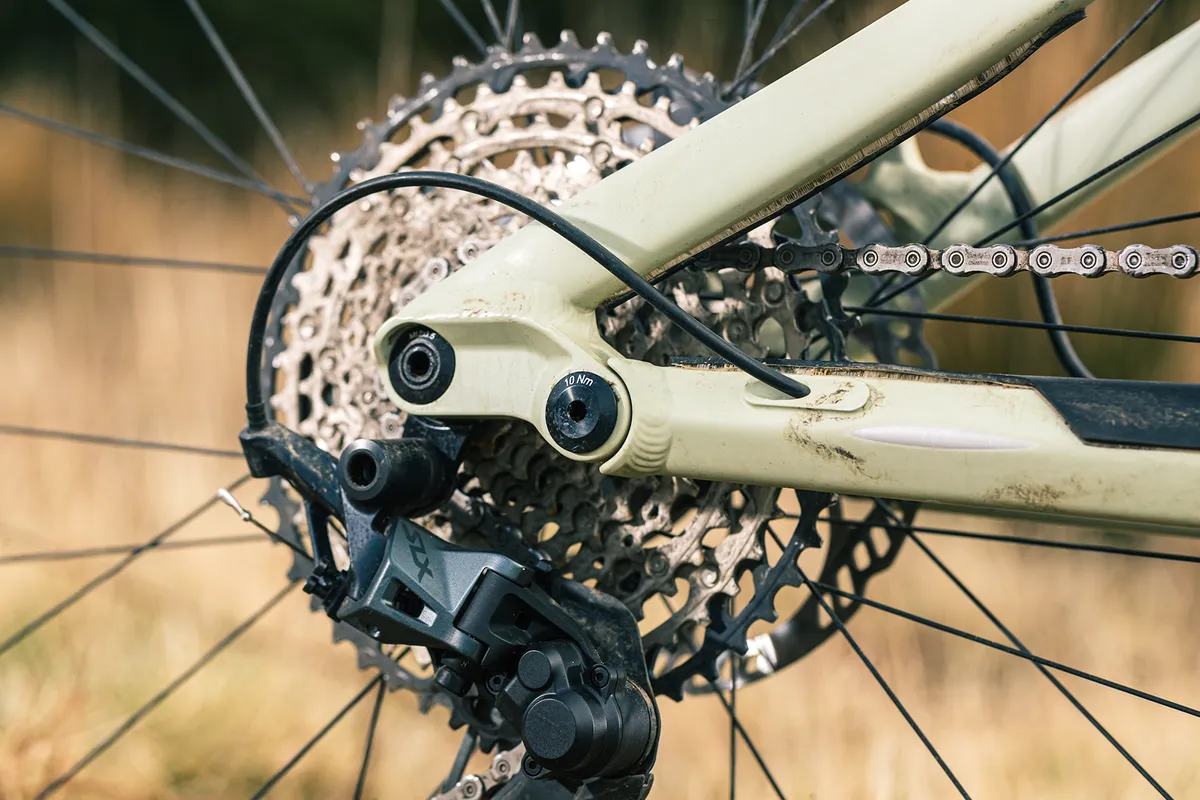
Trail bikes tend to have drivetrains with one front chainring. Thanks to wide-ranging 12-speed cassettes (normally between 10 to 52t), only having one front chainring doesn’t limit climbing potential.
Groupsets such as Shimano Deore XT M8100 are a popular choice on trail bikes. Trail bikes also tend to have easier gearing than speed-focused XC bikes. Front rings are usually between 30- and 34-tooth, while rear cassettes can go up to 52-tooth.
This gives trail bikes a wide range of gears for enough speed on the flat and to help you get up tough climbs.

Like most aspects of trail bikes, the brakes strike a balance between stopping power and weight saving.
Trail bikes will generally come with disc brakes that have two- or four-piston calipers. Four-piston brakes are more powerful and are aimed at downhill riding, where more braking power is needed, but this will of course add weight.
Rotors on trail bikes are often a mix, with up to 200mm both front and back. The larger the disc rotor, the more powerful the brakes will be, but this also comes with a weight penalty.
Hydraulic brakes are standard on all full-suspension trail bikes costing £1,000 or above, and often the best mountain bikes under £1,000 come with these brakes too.
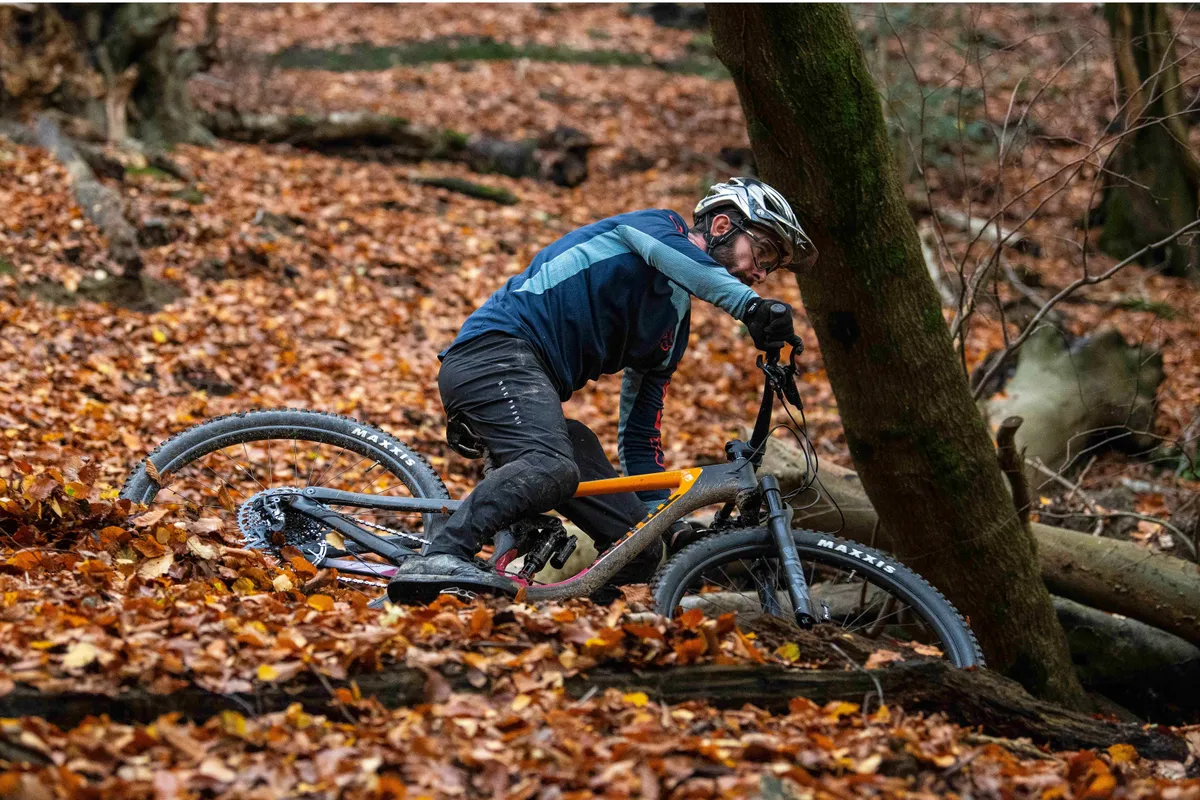
Wide mountain bike handlebars are becoming the norm, and provide extra stability, comfort and control.
Trail bikes follow this trend, many coming with a 760mm or 780mm bar, while some go up to 800mm. Just as smaller-sized trail bikes tend to have smaller 27.5in wheels, they also come with a narrower bar, going down 740mm, to help make the bike a better fit for smaller riders
Dropper posts
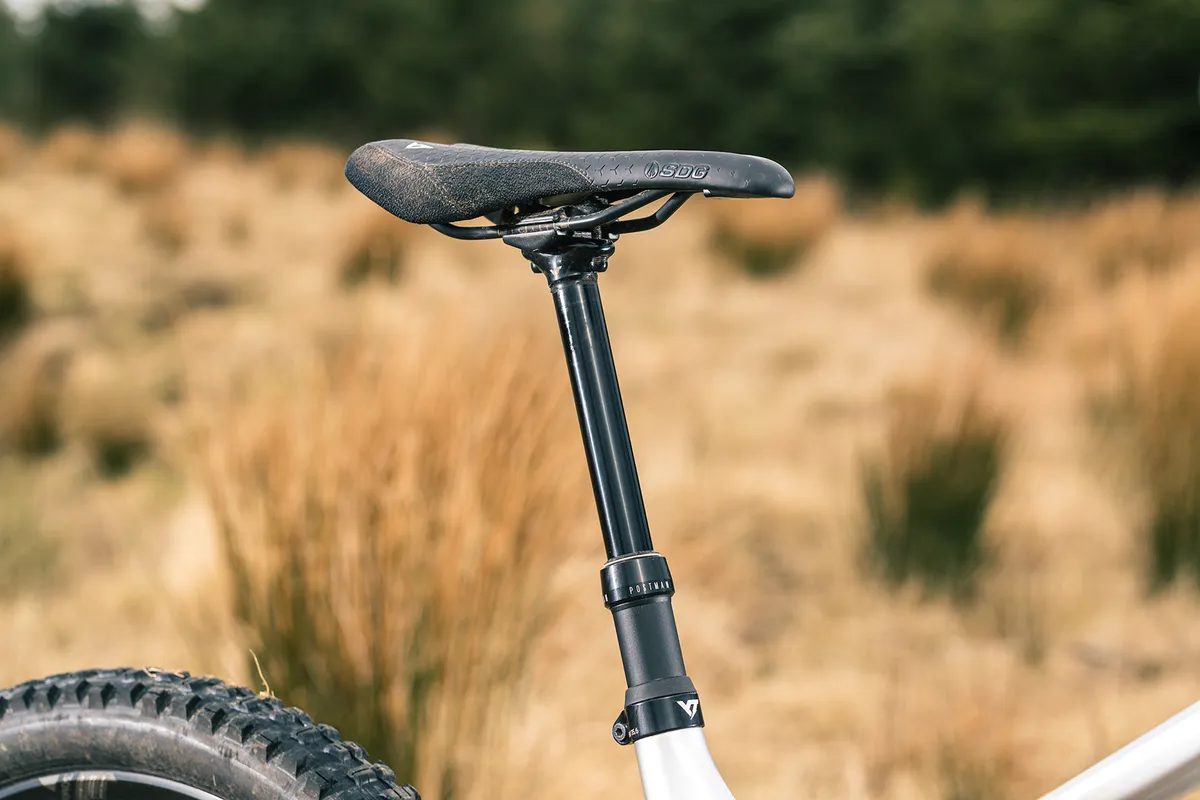
Dropper posts are almost standard on trail bikes.
They allow you to lower and raise your saddle with the flick of a handlebar-mounted button, giving you extra room to move your weight around on descents and the correct saddle height for efficient pedalling.
A dropper post is one of the first upgrades you should consider if your trail bike doesn't have one, because it will open the bike up to a wider range of riding.
Share this article

Content editor
You may also like
Bikeradar newsfeed, best cross-country mountain bikes 2024 | 15 top-rated xc mountain bikes and our buyer's guide, best mountain bike in 2024 | find the right mtb for your riding and budget, the best enduro mountain bikes of 2024 | 25 top-rated enduro mtbs.

- Terms & Conditions
- Subscribe to our magazines
- Manage preferences

Vital MTB Test Sessions - Short Travel Bikes 18
Are they trail bikes, aggressive cross-country bikes, or maybe just mountain bikes let's find out.
Historically, cross-country bikes have always been lightweight and efficient machines with limited travel and geometry that favors climbing and pedaling performance. On the other hand, trail bikes have always been the swiss army knife of mountain bikes, with anywhere from 120 to 150mm of travel capable of handling most descents, matched with balanced geometry and a manageable overall weight that isn’t a burden to pedal. In recent years, the line between cross country and trail bikes has begun to blur. World Cup cross country racing has steadily moved towards more aggressive and technical courses, while everyday riders are looking for bikes that fly up climbs and provide a comfortable, stable, and fun experience on the way back down.

While they aren’t quite XC race bikes, they also aren’t exactly trail bikes. So what the heck are they? Eager to see what all the hype is about with these short travel, ride-everything mountain bikes, we brought together four pedal-hungry and downhill-capable bikes to see how they perform across various terrain. Our goal was simple - find out where this exciting category of mountain bikes shines, what unique features set them apart, and ultimately help riders discover which bike would best complement their trails and preferences.
Skimming through almost any brand’s website in 2022 will illustrate the popularity of these short-travel bikes that have received a small dose of longer-lower-slacker geometry combined with a mixture of lightweight and durable components. Head angles, stem lengths, bottom bracket heights, rotor sizes, and tire casings appear to be picked from various disciplines, creating bikes that, on paper, spark one’s imagination about the efficiency, speed, and confidence such a creation would foster.

There is a lot of wiggle room when you combine character traits from multiple bike genres. To keep our test as apples-to-apples as possible, we chose bikes that weighed within a few pounds of each other, had between 100 and 130mm of travel, rolled on 29-inch wheels, and shared similar components. Checking all of these boxes, we ended up with four exciting machines: Alchemy’s Arktos 120, Ibis’ Exie, YT’s IZZO, and Scott’s Spark.
Meet the Testers
With our bikes selected, we tagged in contributors John Palumbo and Greg Montgomery to help Vital Tech Editor Jason Schroeder log saddle time on each bike. With differences in body dimensions, riding styles, and bike preferences, we hope that readers can pull insights from whichever tester they align with to help understand how each bike would perform as their own.
Greg Montgomery - Greg is our forever bike setup theorist whose quest for the next best combination of unsprung and sprung weight or the optimal cockpit geometry makes him perfect at thinking outside the box when it comes to analyzing the performance of a bike. Originally a world-class runner, Greg is the king of maintaining a conversation for the duration of a climb while you breathe through your eyes. With no lack of fitness laying down power at the pedals, Greg is just as capable descending, with a tendency to prefer quick, snappy bikes that roll fast.
John Palumbo - With over 25 years of spinning circles on two wheels, John is an incredibly well-rounded cyclist and an absolute fitness beast. With experience racing cross country, Xterra Off-Road triathlon, downhill, enduro, and criterium, his depth of knowledge covers every type of bicycle. Heavily involved in his cycling community of Boise, Idaho, John recently became Executive Director of SWIMBA (Southwest Idaho Moutain Bike Association) and has donated hundreds of hours to local trail maintenance and coaching. A working man and father, John has more grit than most and can be found riding before sunrise to kickstart his day.
Jason Schroeder - The Vital editor pulling the strings behind the curtain for this Test Session. Planning, scheduling, and participating in a test brought its fair share of challenges and exhaustion; however, it was incredibly fun to test bikes that fall outside our typical wheelhouse of coverage. And turns out, you get can pretty rowdy on a bike with not a lot of travel!
Our Short Travel Test Sessions was conducted throughout the foothills of Boise, Idaho. The trails immediately outside downtown Boise feature flowing single track with high average speeds and occasional rock gardens. An aggressive, heavy bike with slack geometry is way too much bike, and instead, mid-weight bikes equipped to attack punchy climbs and carry speed on undulating terrain provide the best trail experience.

During our two-week testing period, conditions ranged from loose over hardpack to wet and tacky topsoil. Testers began with each brand’s recommended sag and then made adjustments to match their preferences and trail conditions.
Meet the Bikes

- 29-inch wheels
- 100mm (3.9-inches) rear travel // 120mm (4.7-inches) fork travel
- Full carbon frame hand-made in Santa Cruz, CA
- DW-link suspension design
- 67.2-degree head tube angle
- Size-specific seat angles
- FOX 34 SC Factory fork, Kashima, FIT 4 damper, remote lockout
- FOX Float DPS Factory shock, Kashima, remote lockout
- Bike Yoke Revive dropper post, 185mm (size large)
- Shimano XT 12-speed drivetrain
- Shimano XT 2-piston brakes
- Shimano 180mm front rotor and 160mm rear rotor
- 29x2.4-inch Maxxis Rekon Race, EXO casing tire front and rear
- Measured weight (size large, no pedals): 25.7-pounds (11.6kg)
- MSRP: $7,999 USD (XT Build)
Read the full Vital Test Sessions review of the Ibis Exie
Scott Spark 910

- 29-inch wheelsScott HMF carbon frame
- 120mm (4.7-inches) rear travel // 130mm (5.1-inches) fork travel
- Scott HMF carbon frame
- Integrated single-pivot suspension system
- Three-position, TwinLoc lever-actuated suspension lockout (fork and shock)
- Syncros cable integration system
- 65.8-degree head tube angle (adjustable via modular headset cups)
- 76.4-degree seat tube angle
- 437mm chainstay
- FOX 34 Performance Elite fork, FIT 4 damper
- Proprietary FOX Nude 5T EVOL shock
- FOX Transfer Performance Elite dropper post, 150mm (size large)
- Shimano XT 2-piston brakes with 180mm rotors front and rear
- Syncros Silverton 2.0 wheels
- 29x2.4-inch Schwalbe Wicked Will, Super Race casing, Addix soft front tire
- 29x2.4-inch Schwalbe Wicked Will, Super Race casing, Addix speed rear tire
- Measured weight (size large, no pedals): 27.4-pounds (13.7kg)
- MSRP: $6,299 USD (910 Build Kit)
Read the full Vital Test Sessions review of the Scott Spark 910
Alchemy Arktos 120

- Alchemy premium full carbon frame
- Sine Suspension System
- Flip-chip adjusts head angle, seat angle and allows mixed wheel setup
- 65.75 / 66.50-degree head angle
- 77.75 / 78.50-degree seat tube angle
- 437mm chainstay across all sizes
- 29x2.3-inch Maxxis Minion DHF, EXO casing front tire
- 29x2.3-inch Maxxis Minion DHR, EXO casing rear tire
- Super Boost+ 157 rear spacing with 12mm through axle
- Fully internal cable routing
- Two water bottle mounts
- Measured weight (size medium, no pedals): 30.4-pounds (13.7kg)
- MSRP: $5,999 USD (as tested)
Read the full Vital Test Sessions review of the Alchemy Arktos 120

- 29-inch wheels
- 130mm (5.1-inches) rear travel // 130mm (5.1-inches) fork travel
- Full carbon frame
- Flip-chip geometry adjustment
- 66/66.5-degree head tube angle
- 77/77.5-degree effective seat tube angle
- FOX 34 Float Performance Elite fork, GRIP2 damper
- FOX Float DPS Performance Elite shock, 3-position lever
- YT Postman dropper post, 150mm
- SRAM GX Eagle 12-speed drivetrain
- SRAM G2 R brakes
- 200mm front rotor, 180mm rear rotor
- DT Swiss M 1900 wheels
- 29x2.35-inch Maxxis Forecaster, dual compound, EXO casing tire front and rear
- Measured weight (size large, no pedals): 29.4-pounds (13.3kg)
- MSRP: $4,299 USD (Core 3 Build)
Read the full Vital Test Sessions review of the YT Izzo Core 3

What's The Bottom Line?
After jumping between all four bikes and ascending more feet than is probably safe in just two weeks, we could not believe how fun and capable each bike was in various situations. They all carried great speed, provided a surprising amount of control and confidence descending, and motored up climbs with impressive efficiency. Of course, each bike excelled in its own way and offered a specific ride experience that set each apart from the other.
Ibis Exie - Cross Country Bike on Steroids
With 100mm of rear-wheel travel and a 120mm fork, the Exie had the least amount of travel matched with the steepest geometry. However, we were pleasantly surprised to find that you can’t always judge a bike solely by its head angle and shock size. With geometry that was a hair slacker than a typical cross-country bike, the Exie performed well across varying terrain, highlighted by its ability to maintain speed with little rider input thanks to its minimalistic tires, moderately stiff frame, and firm suspension.

Sure, the bottom bracket did feel a tad high, and the steeper head tube angle limited confidence in steep or technical sections. But overall, the Exie was lightning fast and incredibly fun. When trails became rougher, the Exie attacked descents harder than most 100mm travel bikes, but the margin for air was smaller than the other bikes. When we did execute our lines and held on through the rubble, the Exie rewarded us with an exciting and fast ride.

Unsurprisingly, the Exie pedaled phenomenally. Just tossing a leg over the bike screamed climbing dominance. The low weight and minimal rolling resistance paid dividends going uphill, requiring substantially less effort to punch up climbs. If we had to pick a bike out of the group to tackle massive climbs, we would pick the Exie every time. The bike makes climbs you usually dread feel like a breeze and will leave extra gas in your tank, allowing you to ride further, faster.

The Exie was the lightest bike by over a pound and a half-pound at 25.7-pounds, but also carried the most expensive price tag at $7,999 USD for the entry-level XT build kit. Designing and manufacturing a hand-built, premium carbon frame stateside is not cheap. While the craftsmanship and ride quality of the Exie is exceptional, riders will have to decide if it’s worth shopping boutique or going with a different bike, receiving many of the same components, and saving some cash for component upgrades down the road.
Alchemy Arktos 120 - The Unexpected Race Bike
The Arktos 120 took the top spot as the fastest in the group, thanks to its downhill-focused build kit, impressively stiff frame, and super-efficient suspension design. Ideal for riders wanting a short travel weapon that will carry speed in every situation, the Arktos won’t shy away from blasting downhill.

Combining 120mm of rear-wheel travel with a 130mm fork, the rear suspension was incredibly supportive, making it easy to maintain speed and generate momentum from the smallest trail features. Despite being the heaviest at 30.4-pounds, we found the Arktos carried the most speed on rolling trails. Getting on the pedals took a tad more energy, but power transfer was immediate, and we never felt bogged down sprinting. Diving into more demanding sections, the Arktos still reacted like a 120mm travel bike. The rear suspension did not have a bottomless feel, and the stiff frame provided a firm ride quality. The Arktos wasn’t as much of a handful to keep settled through rocks and compressions as the Scott Spark but was stiffer than the IZZO and Exie. Luckily, the Arktos build kit and geometry improved its ability to manage demanding sections.
While the Arktos might appear just to be a slimmed-down trail bike, don’t be fooled, it was impressively efficient and was a competitive climber against the other bikes. The firm rear suspension again played a significant role, providing an almost motionless pedaling platform that was highly efficient.

We tested the mid-range XT build that retails for $5,999 USD, highlighted by Shimano’s XT 4-piston brakes and Maxxis Minion DHF and DHR II tire combo that elevated the Arktos’ descending performance above the rest. The Arktos 120 was the only bike that we couldn’t find modifications we’d make to better match the intended use of the bike. Alchemy did an impressive job speccing all Arktos 120 models with components that complement the downhill abilities of the bike. Compared to the other bikes, the Arktos includes nicer components at a lower price. Even though the IZZO Core 3 is less expensive, we’d argue riders are getting a better bang for their buck with the Arktos. We know $5,999 USD is not cheap, but if you have the funds, you will be jumping on a hand-crafted bike with premium components for much less than most brands can offer.
Scott Spark 910 - Best All-Around Performer
Easily one of the most head-turning bikes of recent times, the Spark 910 achieved the best balance of climbing and descending performance. While it’s not our first choice to convert into a cross-country race bike (although you could if desired), we would reach for the Spark to knock out big adventures and long days in the saddle. A point of discussion at every trailhead, the integrated suspension design was aesthetically striking and fostered the most prominent character trait of the Spark: responsiveness. Agile, light, and nimble, the Spark demanded precise riding. Despite weighing 27.4-pounds, it accelerated with ease and provided a firm platform to press against and squeeze speed out of trails.

The downside to such a responsive frame was the energy required to keep the Spark settled through repetitive compressions. We ended up running a tad more sag to help keep our weight sat into the bike and adjusted our mentality going into demanding sections, knowing it would take more focus to hold onto the reigns. Despite lacking some composure, the Spark made up for lost time in rowdy sections by carrying great speed on smooth, flat terrain.

When climbing, putting down power was effortless; however, the Spark had a more upright pedaling position that promoted a less aggressive approach. The rear suspension design remained active when open and relied heavily on Scott’s TwinLoc system to maintain speed and climbing efficiency. When we locked out the suspension, the Spark’s climbing abilities were transformed, and hammering up trails was enjoyable. And once we became accustomed to the strong suits of each TwinLoc mode, we grew to enjoy the ability to quickly toggle between modes to find the best suspension package for a given trail.

Retailing for $6,299 USD, the 910 build used components that performed great climbing and descending. The build also offers riders the most flexibility to easily alter the Sparks intended use with minimal component adjustments.
YT IZZO - T he Short Travel Trail Bike
With the most travel in the group, it should come as no surprise that the IZZO was the most forgiving and capable on descents, performing similar to a trail bike. Employing 130mm of travel front and rear, we felt at ease pushing our limits, knowing the IZZO could handle plenty of abuse without punishing us for taking less precise lines. We had no problem maintaining speed through repetitive compressions and found it easier to float over bumps where the other bikes tended to get hung up or deflect. The IZZO was also a joy to take down mellow flow trails and had the most natural feel when hitting jumps and bowled out berms.

Featuring a full-carbon frame with a Horst Link suspension design, the IZZO’s frame was noticeably compliant and made for a smooth ride through trail chatter. The downside was a lack of responsiveness when pumping to generate speed. Even though we found the rear suspension comfortably supportive and progressive, we consistently had trouble maintaining as much speed as the other bikes on low-angle descents.

Once turned uphill, climbing the IZZO proved to be a comfortable yet slow-moving endeavor. With a more upright and rearward seated position, the IZZO mentally made us less eager to attack climbs. The suspension was also quite active under pedaling forces and relied heavily on the rear shock’s lockout to maintain speed and efficiency.

Weighing in at 29.4-pounds, the IZZO Core 3 build tested was the second heaviest bike in the group. It was also the cheapest at $4,299 USD, highlighted by FOX’s Performance Elite suspension and Maxxis Forecaster tires. Unlike the Spark 910 that offered options to adjust components to compliment rider intent, the Core 3 model shined most as a hard-charging, mini trail bike and would require too many adjustments to achieve enhanced climbing performance. For riders who are eager to fly up hills, save your money, and reach for the more expensive IZZO builds with components that prioritize efficiency, weight, and pedaling performance.

If there is one takeaway from this Test Session, it’s how components can heavily dictate the ability of a bike with limited travel. Whether you prioritize climbing, descending, or a combination of the two, component spec can often make the difference between a bike that meets your needs or doesn’t. And in some cases, bikes offer the ability to make subtitle changes that drastically change how they perform. Everything comes down to what on-trail experience you are seeking, and starting with a bike that blends frame characteristics with a build kit that complements your riding style will save you time and money in the long haul.
And with that, that’s a wrap on our Short-Travel Test Session! For a more in-depth analysis of each bike, make sure to follow the links to the full reviews.
View replies to: Vital MTB Test Sessions - Short Travel Bikes

Most Popular

Best Long Travel Mountain Bike Review 2021
by Kyle Scott | Nov 12, 2021 | Best of Bike , Best of Mountain Bikes , Bike , Comparisons
Table Of Contents
Long travel 29ers, terminology, our top picks.

A.) Reach : the distance between the center of the head tube (where the handlebars sit) and an invisible line that runs up from the center of the bottom bracket. Short travel bikes are getting longer and longer reach, meaning to keep up with steeper head tube angles (read on), the longer reach allows the rider to have more control over the front end of the bike. For a medium-sized frame, expect to see between 440mm and 470mm for reach.
B.) Rear Center (Chainstay Length) : The distance between the rear axle and the bottom bracket. The shorter the measurement means the rider will be positioned closer to the back axle and this allows for easier manuals, greater control over the back tire, and overall, the bike will have a more responsive feel. The longer the chainstay length, the greater stability you will have at speed and over rougher terrain.
C.) Front Center : The distance between the front axle and the bottom bracket. As head tubes get slacker the front center distance is getting longer. A longer measurement again will mean more control at speed on downhills but potentially sluggish responsiveness on uphills and flats. A shorter front center will provide more agile steering and greater control on uphills but may feel sketchy when at speed on downhills.
D.) Wheelbase : Measure from the front center to the rear center of each wheel, and you get the measurement for the wheelbase. This is the distance between the front axle and rear axle. A larger wheelbase will provide stability on the downhills while a shorter wheelbase will be more maneuverable and give slightly better control over the front wheel. Both serve different purposes and each rider will likely prefer a different measurement depending on his or her discipline.
E.) Bottom Bracket Height : This is the measurement of the distance between the bottom bracket and the ground. A lower bottom bracket height will offer more control and a more stable feeling on the downhills, however the trade-off is the potential of bouncing your bottom bracket or pedals off of uneven roots and rocks.
F.) Head Tube Angle : This is the angle of the head tube from a flat plane (the ground). Head tube angles often absorb the most impact on the handling and stability of the mountain bike. You will hear the angles referred to as “slack” if they are a low angle or steep as they get higher. Cross country bikes and trail bikes have steeper head tube angles that allow riders to have greater control over the bike while climbing, whereas enduro and downhill mountain bikes have very slack head tube angles to give the most control while descending at high speeds.
G.) Seat Tube Angle : This is the angle that the seat tube stands up from horizontal. This angle determines the rider’s seated position over the back wheel and the amount of control that they will have over the front wheel. A steeper seat tube angle has traditionally been best for bikes that want to climb and keep the rider in a neutral position so they can power hard into the pedals. A steeper seat tube angle also offers the rider the option to have more weight over the front wheels and, in turn, greater control and traction over the front end.
H.) Trail : The distance between the bikes front wheel contact patch with the ground and the steering axis. Greater tire size will provide more trail as well as smaller fork offsets. The more trail, the greater amount of tire will be in contact with the ground and that equals more traction and control.
Fork Offset : The distance between the front axle and the steering axis. Essentially, where the front fork comes down from the head tube is your steering axis, and the small amount of metal that connects the front fork to the axle is the offset. Traditionally, mountain bikes have gone with a 51mm offset for 29” wheels. However, there is a small push towards bringing in smaller offsets, like 44mm, which provide greater trail and more traction.
Travel : This is how far moving parts move on a mountain bike. Mainly referring to the suspension (rear and front). When reading about mountain bikes, specifically a “120 mm travel bike,” the travel they are mentioning is in the rear shock. Frames are built with a level of suspension in mind and are not often switched for different levels of travel, so that is why the travel often only means the rear suspension. Front travel in the forks is easier to switch around, depending on the rider’s preference and terrain, so those numbers will change more frequently.
Bikes with smaller travel (short travel) are better for climbing as the suspension won’t take away too much of your pedaling power as you move uphill, whereas the larger suspension is better for a more controlled and comfortable descent down choppy terrain. Most suspension systems are lockable, meaning you can reduce the amount of travel on the fly, and this helps with climbs.
Best Long Travel Mountain Bikes of 2021
Santa Cruz Hightower : Best All-Around Long Travel Bike of 2021
Giant Reign : Best Budget Long Travel Bike of 2021
Yeti SB150 : Best Climbing Long Travel Bike of 2021
Specialized Enduro : Best Enduro Bike of 2021
Other Mountain Bikes
Pivot switchblade, canyon strive, orbea rallon, kona process x, norco sight, scott ransom, nukeproof mega.

Santa Cruz Hightower Review
Buy Now at Backcountry.com
Compare Best Prices
- Climbing Ability 90% 90%
- Downhill Ability 90% 90%
- Overall Fun 90% 90%
All-around Ability in a Variety of Terrain
Weight of some of the build options.
Travel: 145mm rear/ 150mm fork
Head Tube Angle: 65.2
Seat Tube Angle: 76.3
Reach: 470mm (large frame)
Weight: Starting at 29 lbs

Giant Reign Review
Buy Now at Giant-bicycles.com
- Climbing Ability 70% 70%
- Downhill Ability 80% 80%
- Overall Fun 80% 80%
Maestro Suspension Platform, Price
Could use some better brakes.
Travel: 146mm rear/ 170mm fork
Head Tube Angle: 64.6
Seat Tube Angle: 76.4
Reach: 488mm (large frame)
Weight: Varies With Frame Material

Yeti SB150 Review
Buy Now at Aventuron.com
- Climbing Ability 80% 80%
Really Playful Bike
Expensive build options.
Travel: 150mm rear/ 170mm fork
Head Tube Angle: 64.5
Seat Tube Angle: 76.9
Reach: 480mm (large frame)
Weight: Starting at 31 lbs

Specialized Enduro Review
Buy Now at Specialized.com
- Downhill Ability 100% 100%
DH Bike That Can Climb
Needs steeper seat tube, price.
Travel: 170mm rear and fork
Head Tube Angle: 63.9/ 64.3
Seat Tube Angle: 76
Reach: 487mm (S4 frame)
Weight: Starting at 32.5 lbs

Ibis Ripmo Review
Buy Now at JensonUSA.com
Climbing Ability, Ripmo AF Option
Stock shock not being fox float.
Travel: 147mm rear/ 160mm fork
Head Tube Angle: 64.9
Reach: 475mm (large frame)
Weight: Starting at 28.9 lbs

Pivot Switchblade Review
Buy Now at Backcountry.com
- Overall Fun 100% 100%
All-around Performance
Travel: 142mm rear/ 160mm fork
Head Tube Angle: 66
Seat Tube Angle: 75.5
Weight: 30.2 lbs

Canyon Strive Review
Buy Now at Canyon.com
The Shapeshifter
Also the shapeshifter.
Travel: 150mm rear/ 160mm fork
Head Tube Angle: 66 - 67.5
Seat Tube Angle: 73.5 - 75
Reach: 470mm (large frame))
Weight: Starting at 31.2 lbs

Orbea Rallon Review
Buy Now at JensonUSA.com
Amazing Climber, Custom Paint Job Option
Short reach and cost.
Travel: 160mm rear/ 170mm fork
Head Tube Angle: 65
Seat Tube Angle: 75.5/ 76
Reach: 455mm (large frame)
Weight: Starting at 30.95 lbs

Kona Process X Review
Buy Now at Konaworld.com
- Climbing Ability 60% 60%
- Overall Fun 70% 70%
Chainstay Chip Makes A Difference
Sluggish at slow speeds, super long.
Travel: 161mm rear/ 170mm fork
Head Tube Angle: 63.5
Seat Tube Angle: 78
Reach: 490mm (large frame)
Weight: 32.8lbs (large frame)

Norco Sight Review
Buy Now at Norco.com
Strong Climber, Stable Descents
Not as playful as older versions.
Seat Tube Angle: 77.7
Weight: Starting at 32.23 lbs

Scott Ransom Review
Buy Now at Scott-sports.com
Made For The Downhills
Twinloc system needs some work.
Travel: 170mm
Seat Tube Angle: 75
Reach: 466.5mm (large frame)
Weight: Starting Around 30.20 lbs

Nukeproof Mega Review
Buy Now at Nukeproof.com
Now Comes With A Water Bottle Mount, Sportier Geometry
Climbing could be more efficient.
Head Tube Angle: 64
Weight: Heaviest Build 34.2 lbs
Santa Cruz Hightower

Best All-Around Long Travel Bike of 2021
Price: $7,299
What We Like: All-around Ability in a Variety of Terrain
What We Don’t: Weight of Some of the Build Options
Santa Cruz has created the perfect one quiver bike with the Hightower . With a suspension system that is capable of handling flowy trails to absolutely nightmarish choss piles, the Hightower will make it through. Every tester has been really impressed and surprised by the Hightower and its overall versatility. There really isn’t much more to say other than this bike will climb and mountain and ford any stream. It was easy to give the Hightower our selection as Best All-Around Long Travel Bike of 2021 .
^ Back to Top ^
Giant Reign

Best Budget Long Travel Bike of 2021
Price: $3,499
What We Like: Maestro Suspension Platform, Price
What We Don’t: Could Use Some Better Brakes
Giant , though late to the 29” party, have produced some impressive 29ers. The Reign is their second 29er after the Trance, and they are definitely dialing it in. The Reign is a solid climber with the Maestro system and a steep seat angle to keep the rider in a good position. Turn the bike downhill and prepare to bash through anything in your way. The 170mm fork is composed and all-business, while the fairly short rear chainstay with the snappy rear shock keeps it lively and poppy. At the prices Giant is offering on their carbon and alloy frames, it was a fairly easy choice to name the Reign as the Best Budget Long Travel Bike of 2021 , though you can still splash out if you so choose.

Best Climbing Long Travel Bike of 2021
Price: $5,900
What We Like: Really Playful Bike
What We Don’t: Expensive Build Options
The Yeti SB150 always impresses with its climbing ability and an easy selection as the Best Climbing Long Travel Bike of 2021 . Without going overboard on the modern geometry side of things, Yeti has produced a competent climber that is still really aggressive on the downhills. The Infinity Switch system even got an upgrade making the bike more robust. The added suspension makes the bike really playful in the rough and rowdy sections of trails and it has just become a really good all-arounder.
Specialized Enduro

Best Enduro Bike of 2021
Price: $4,499
What We Like: DH Bike That Can Climb
Built for the descent but will also get you uphill with your own power is a tough combination to find. Specialized has come pretty close to nailing it with their new Enduro bikes. The combination of long travel and modern geo has given this downhill rocket the legs to get back up the mountain. The seat tube could be a bike steeper to really help the pedaling efficiency, but it is a small price to pay for the wild downhill skills this bike comes with. It is controlled and composed but also poppy and playful, it has amazing traction when you need it and really just wants to go fast. Add the cool SWAT downtube storage, and it’s hard to find any flaws in this beast, making it our Best Enduro Bike of 2021 .

Price: $3,999
What We Like: Climbing Ability, Ripmo AF Option
What We Don’t: Stock Shock Not Being Fox Float
New may not always be better, but in the case of the Ibis Ripmo , it most certainly is. Slackening the head tube angle, slightly longer reach, and some protection for the linkages, the Ripmo V2 isn’t too different, but it is better. The more aggressive headtube angle does not take away from the climbing ability of the Ibis’s we have come to know and has only made it more fun on the downs. Now with room for a 750ml water bottle, what can’t this bike do?!

Price: $10,899
What We Like: All-around Performance
What We Don’t: Price
Pivot has nailed it. The Switchblade is a dialed-in all-around trail bike that is ready to tackle any terrain, and it will do it in style. The rear shock has been customized by Fox for the Switchblade and has made the bike super-efficient on the uphills but plush and bottomless on the downhills. With a modern but reserved geometry, the Switchblade is highly maneuverable and snappy through tight sections of trail but will also eat up choppy straights. It really is hard to find a negative with the Switchblade other than the price, but also there is a ton of technology that is available to be added to the Switchblade should your wallet allow.

Head Tube Angle: 66 – 67.5
Seat Tube Angle: 73.5 – 75
Price: $8,499
What We Like: The Shapeshifter
What We Don’t: Also The Shapeshifter
Canyon has created something very innovative with the Shapeshifter and for that, it’s pretty awesome. However, it seems that if they had originally adjusted some of the geometry, the Strive could be a one-quiver ride without the bells and whistles that in a way also hinder it. Definitely worth a look for a rider who doesn’t like the modern geo all that much but is looking for a do-it-all bike. The all-around nature of the Strive is present, it just feels like you need to do too much while riding to get the best out of the bike.

Price: $7,999
What We Like: Amazing Climber, Custom Paint Job Option
What We Don’t: Short Reach and Cost
The Rallon by Orbea is a very composed enduro bike. While the geometry keeps it out of the hard-charging enduro bike categories, it is a super good climber and comfortable all-day rider. The MyO customized paint option provided by Orbea will allow you to have the stealthiest or flashiest bike on the hill if you so choose. The rear linkage has been updated and raised to increase bottom out support and create a more responsive ride while also maintaining control while braking. This bike is excellent if you are not the biggest fan of all of the new modern geometry these days and live in an area where there is a lot of vertical gains to be climbed.

Price: $4,999
What We Like: Chainstay Chip Makes A Difference
Kona has brought a stretch limousine to a chicane competition it seems. The new Process X is a far cry from what most of the bikes in this article are in terms of geometry and length. While the length and geo make it a downhill superstar, it does not love tight corners and hates uphills just as much as kids chasing the ice cream truck. The flip-chip that increases or decreases the chainstay length does make a big difference in the ride. So it’s all about finding that perfect set up.

Price: $6,399
What We Like: Strong Climber, Stable Descents
What We Don’t: Not As Playful As Older Versions
The 2021 is not very different from the 2020 Norco Sight , but it is very different from the 2019 Sight. So know that before reading any further. The new 2021 Norco Sight is a long bike with long chainstays and steep seat tubes to keep everything calm, cool, and collected on climbs and speedy descents. Paired with Norco’s Ride Align app, you can easily dial in your suspension settings to get the most out of your new ride and get cruising. Definitely not the flashiest bike or the bike you ride if you want to let your hair down and show off to your friends. The Sight is rock solid and a hard-charging all-mountain bike that could find itself in some enduro races.

Price: $9,223.37
What We Like: Made For The Downhills
What We Don’t: TWINLOC System Needs Some Work
Relying too heavily on the TwinLoc system the Scott Ransom just isn’t the bike it could be if it simply utilized the suspension it chose to its fullest. While being a shredder and a great option for enduro races, the suspension just isn’t quite what we were hoping for, and the rest of the impressive bike fell to the wayside. It is a downhill shredder and great for some laps in the bike park. If you don’t climb a lot and mainly use gravity for propulsion, this is a great option.

Price: $7,332.72
What We Like: Now Comes With A Water Bottle Mount, Sportier Geometry
What We Don’t: Climbing Could Be More Efficient
With a few modifications on the already awesome Mega , Nukeproof has created an amazing bike. They have even added enough room for a water bottle holder, which is great news for people who hate fanny packs. The Mega now comes with a shorter chainstay and a steeper seat tube to make climbing more efficient and the downhills more lively. The build-outs in all five of the options for the Mega are solid and look after the important parts before adding too many bells and whistles. All in all, the Mega is a super all-arounder that would work for any rider of any skill set.
You Might Also Like


- Forum Listing
- Marketplace
- Advanced Search
- MTBR Discussion Forums
- General Discussion
Climbing: short vs long travel bikes
- Add to quote
Why is it that short travel bikes are supposed to climb better than long travel bikes? Is it just because of the travel or because longer travel bikes might have different geo or are heavier or something else?
All of the above. Typically shorter travel bikes are designed to have a firmer platform, where as longer travel is designed to be plush. Longer travel bikes have come a long way though, in terms of climbing.
Mostly it has to do with geo. Longer travel usually means slacker head angle, which makes it particularly hard to steer when going up, along with making it more difficult to put your weight where it counts to keep traction and momentum going up. That is what I have figured out anyway. Sent from my SM-G900V using Tapatalk
With the higher front end, it's harder to put the power down uphill with the longer travel bike, you can't keep the front end from wondering and have do be more careful(slower). Having a fork that lowers doesn't help as much as you might think too, helps with keeping front down, but feels like you are driving straight "in" to the Mtn and it takes more effort.
Geometry, tires, weight, suspension. Geometry: many long travel bikes don't put you in a position for optimal power production. Tires: A longer travel bike should be seeing rougher terrain and faster speeds, which require knobbier tires. Those tires require a lot of power to keep up with low-knob tires when not being assisted by gravity. Weight: A bigger bike generally weighs more. This doesn't help when you're trying to climb. Suspension: Some of your movement, unless you have the ability to stiffen or lock out suspension, is going to be absorbed by the suspension and released as heat. In short, anyone that says, "Oh, my 150mm bike climbs like an XC race bike!" has either never ridden an XC bike or is lying to themselves and others.
Not really, the typical rider is going to have enough variables at work (weather, day-to-day fitness variations and motivation) to make any real difference in climbing performance hard to see. On descents, that's where there will be a real difference.
I was doing a technincal climb on my 7" bike that I do often on my 29er HT. So I get to a spot where I normally pull up and pop the front wheel over a rock. So I did the same and the front wheel never left the ground. I popped the front wheel and it just took the sag out, but the wheel was still on the ground. In the rear there is so much travel that when I put power down it just gets sucked up in the suspension. On the HT even with a 120 mm fork the bike just puts so much power down to the ground even on rocky technical stuff I climb better on the HT as I can time one or two quick powerful pedal strokes to clear ledge or some other feature.
I find this whole arena of discussion is very nuanced. In a pure sense, longer travel suspension means more pedal-bob and thus less efficient climbing (or pedaling in general really). However, this doesn't account for terrain but rather assumes a perfectly smooth slope. If the terrain is rough the suspension can increase traction (as said above it literally keeps your wheel in contact with the ground for more time) and actually improve climbing. Also, as mentioned above as well, geometry and other aspects of the bike play a huge role. Essentially, it's not even worth having the discussion unless you provide all the necessary info; what bikes are we comparing, over what type of terrain, for what style of riding.
I'd like to see a long travel FS design that can counteract the Crr increases associated with tires appropriate for such a bike. And the weight, for that matter. Sent from my XT1585 using Tapatalk
On smooth trails, I haven't ridden a bike that can outclimb my carbon rigid singlespeed. It's about as efficient as possible. Once trails get rough or loose, it's at a disadvantage. The rear tire has a tendency to slip, bounce, and skip. On very rough and slow climbs with bigger obstacles, the rigid bike has the advantage again. It's much easier to lift the wheels and perform trials like maneuvers.
This is part of the reason I feel like 120mm of travel or less on my local trails is optimal. Climbs where I live tend to be short, so if you're a strong rider, you tend to power up most of them. Pushing a big gear uphill on most FS bikes tends to highlight shortcomings of the rear suspension, so the bike will oftentimes feel sluggish going uphill. The longer the travel, the more sluggish. The other reason is because I feel like extra suspension can have the effect of dumbing down a trail that's not chunky enough. Rock is a premium here, and its use is limited. On many trails, it's used more for trail hardening than adding technical challenge. But where there's enough to use it for challenge, I don't want my suspension to take away ALL of the challenge for me. I've demo'd bikes that felt that way. Obviously you can go to extremes on either end of this. A fully rigid bike is going to make trails the hardest. I'm all about choosing the tool for the job. If I'm riding gravel all day, then yeah, a fully rigid bike is going to be the one I choose. Local xc stuff, I'd pick either a shorter travel FS or a hardtail. Downhill-specific trails, or at least a heavy bias towards riding trails downhill, then I'm going to choose a longer travel FS, if I have that ability.
The biggest edge when it comes to FS and climbing is when you hit small rocks and can stay seated. On HT when you hit some rock sections it will kick your around a lot and you have slow down, stand and coast over them if the are short bit, or stand power over them. On a FS bike you stay seated in the power pedal through like they are not there. That said there are there elements of climbing. 1) getting to the top and 2) doing it fast getting fast 3) cleaning every feature. A big heavy Long travel bike can get you to the top of long smooth climbs. My 7" bike weighs 44lbs and does not climb well, but if the climb is smooth and not super steep I can get it to the top. It will just take time and effort. If the climb is in any way technical I clean less on it than on my 26er HT. Personally I like climbing fast and climbing technical stuff. I can tolerate climbing slow on the big bike if I have descent that will take advantage of it. However on a lot of climbs I it just takes the fun out of climbing all together. It really best suited to be shuttle bike. Now if you never care about climbing fast or care about making every tech feature then a long travel bike may not be an issue. It depends alot on what you want your bike to do based on where you ride it.
I did a test where pumped up my shocks on my E29 to excessively high levels, with minimal sag, and climbed things at race pace at my local trails. Turns out that it became a contender to my 23 lb carbon HT and my 25 lb 100mm travel FS bike, despite weighing 29 lbs. Actually got a number of PR doing this test, though I admit I don't really go out riding with the intention of going 100% up climbs (the PRs were on short 1-3 min climbs). :lol: Hints at suspension movement being quite a factor.
Any suspension sag or movement will reduce the power going from the pedals to the ground. It is why road bikes are all rigid and the stiffer the bike the better. Of course they ride on smooth roads and we ride on dirt. Could be smooth dirt or rocky trails. As another poster stated how fast you climb up a trail depends on a lot on the conditions of the trail.
singletrackmack said: Why is it that short travel bikes are supposed to climb better than long travel bikes? Is it just because of the travel or because longer travel bikes might have different geo or are heavier or something else? Click to expand...
I found it extremely helpful to have the anti-squat on steep climbs yesterday where I had to start from a stop. Before, on my FSR of the same travel, you couldn't start in too low of a gear doing this, because you'd spin out and break traction, but a high gear would mean massive squat and the front end unweighting, making starting out that much harder. This was a nice change yesterday, in addition to the climbing when you start to get tired, it doesn't seem to take as much of a toll on my body with the DW link. Did about 2.5-3k of climbing yesterday and a few more a couple days before (not huge, I know, but time limited). Remember tho, every pedal stroke is an acceleration, since it's physically impossible to provide steady power, and that means you are accelerating the mass both forward and upwards, with all the associated rotational mass. This is why weight makes a big difference besides just the obvious (thinking of it like a steady state). You can also have no bob, but your pedal stroke be compressing the rear shock if you pedal smoothly enough and if there is not enough anti squat, so a certain percentage of your energy goes to this, more so when you try to pedal hard up something challenging.
The question is how much climbing ability are you willing to give up for greater descending speed/comfort/margin?
What kind of climbing? Sent from my iPhone using Tapatalk
I read what you said. I simply don't agree. If tires are condition specific, we should all be riding the same tires, or type of tires (Magic Mary vs. DHF) on the same trails, regardless of bike/application. We don't. Tires are application AND condition specific.
When I switched from Hans dampf/nobby nic to nobby nic/ikon, I was able to ride two cogs higher on the cassette on the same trail. It was clearly much faster for me to ride the less nobby tires. Most of my PRs were done on my 140mm travel tallboy ltc and not my new turner czar at 120mm. My fitness was much better back then, (60 miles/week) but the czar is getting me close even though im only riding about 15 miles/week right now.
IMHO the hardtail is the clear winner but when we only talk about suspended bikes the one with more "traditional" geometry should be a better climber than the slacker. Study made by "experts"
I think that if they did the testing on a rougher trail that you'd have much different results.
- ?
- 15.6M posts
- 522.4K members
Top Contributors this Month

Should I get a short-travel trail bike or a long-travel trail bike?
I don’t know if you answer these kinds of questions but I thought I’ll give it a try. Feel free to deny to answer ;-).
As mentioned above I’ll be getting a new bike and I actually ordered a 130mm trail bike. I’ve been a bit insecure lately if I did the right choice or if I should try to change my order to a 150mm bike which is a bit more towards Enduro (I rather have only 1 bike than 2).
I don’t want to be one of those quys who is overbiked, on the other hand I don’t want to risk damage of the bike because I’m doing stuff which the bike can’t take.
The skill level I’m hoping to achieve:
- Good flow on trails with berms etc.
- Being able to go down technical terrain with some “blocked” passages safely (I don’t want to go down fast)
- Doing drops of maybe 1m
- Jumps: clearing tables of maybe 2m safely. Not sure if I have the balls for attempting gaps.
- Pump Track. With increasing skill, I’d love to include some jumps.
As most of my biking is without shuttles and more like tours rather than bike parks I opted for a nice, light high-end trail bike, but as said, I’m not sure if it would take the above mentioned loads.I’m about 74kg of weight. What does your experience say?
I’m looking at a Canyon Neuron (130mm rear/130mm front) and a Canyon Spectral (140/150mm).
Since I’m a Specialized guy, I relate the Neuron to a Stumpjumper ST and a Spectral to a regular Stumpjumper.
I’ve ridden both bikes. Both are awesome, but in different ways. The ST is insanely fast/fun on mellower terrain. The regular Stumpy lets me attack rougher terrain. Strange fact: I PRed my local rocky climb on the regular Stump; I think the suspension tracked well in the bumps.
In general, the low-travel trail bike is ideal in these conditions:
- You have low skill but are not riding aggressively or riding technical terrain.
- You have high skill and are charging hard on moderate terrain.
- You want a blend of descending and climbing, with the bike a bit more focused on climbing.
- You like the way this bike rides.
Go for the bigger bike if:
- You have low skill and are trying to ride crazy terrain. The bigger bike adds confidence.
- You have high skill and are charging hard on all terrain.
- You want a blend of descending and climbing, with the bike a bit more focused on descending.
- You simply like the way the bigger bike rides.
I live in a rocky area, and I ride a lot of biggish bike park features. If I can only have one bike (in addition to my Fuse hardtail), I’ll go for the regular Stumpy. If I can have two bikes, I’ll go for the Stumpy ST and a much bigger Enduro.
For what you’re describing, the 130mm bike should be ideal.
But you should test-ride the bikes before you buy. I suppose that’s an issue with mail-order bikes.
Leave a Reply
Leave a reply cancel reply.
Your email address will not be published. Required fields are marked *
Save my name, email, and website in this browser for the next time I comment.
Search this site (more than 2,000 articles)
- Lee Likes Bikes MTB School
- Dynamic MTB Fit
- Live Instruction
- Remote Coaching
Trail Bikes: Short vs Long Travel
Q: Do you think suspension travel should define intended use and bike character?
Noah : Not really. The intended use should define everything else about the bike, travel included. But, for better or worse, the travel / intended use categories have more or less settled out over the past 10 years, and I don’t think the current status of bike travel vs. intended use is all that out of whack.
That said, there are certainly plenty of bikes out there—shorter travel bikes in particular—that would benefit from some revised geometry. Some companies are on top of this, some not so much.
Marshal : No, not at all. Bike setup (bars, stem, seatpost, tires, brakes, suspension design and setup) have way more impact on how a bike rides than the wheel travel. With the prevalence of modern geometry, it is now, in my opinion, pretty irrelevant as well, as long as it is functional for the use. Most “important” geometry numbers are easily tuned with angle sets and eccentric shock bushings.
Tom : I think that it should play an important role, but perhaps not the headlining role it does now. It’d be great to see people obsess over it less—no one should discount a bike because it doesn’t have enough travel’.
More travel generally yields more margin for error on hard moves, saving your ass from time to time, so folks who want more travel for challenging riding aren’t making entirely unwarranted claims.
However, some of the most interesting bikes developed over the last decade are class-breaking: The Canfield Yelli Screamy , a slack 29er hardtail, the original Santa Cruz Blur 4x, short travel but slack, or the Kona Process bikes, focused more on geometry and less on travel.
Q: Is there another factor you think is more important? (I.e. instead of referring to bikes as belonging in the 5-6″ category, should we refer to them by something like the 66-65* head angle category?)
Noah : Not really. Travel is a convenient summary that, more often than not, gives at least a starting point to the discussion of what the bike will be good for. There’s any number of angles, lengths, and stats about a bike that can give me a decent clue as to where it’ll be most at home, but ultimately, there’s no single number on any bike that will tell the whole story, and if you need a quick figure to place the bike in the right ballpark, travel is as good an indicator as any.
Marshal : See above. The only numbers I pay attention to in any way are:
REACH – At 6’2’’, I want at least 460mm. At that length, I comfortably run a 60mm stem, and have no desire to resort to a longer than that. If the Reach bumps up to 470mm, I drop to a 50mm stem.
CHAINSTAY LENGTH – I prefer at least 17.3”, and look for 17.5”+. As a tall(ish) guy, I can leverage the rear and manual just fine for my tastes. I prefer the stability and traction with length, especially while climbing the prevalent loose gravel in Utah.
HEAD ANGLE – I only care that its in the right zone for the use. On a pedal bike, 67 to 69 is fine. For downhill bike terrain, I am in the 64 to 65 degree zone. It is easy to tune from there to speed up or slow down steering.
I am way more interested in the main pivot location relative to the chainring, and the stiffness of the headtube and bottom bracket junctures.
Tom : Head angle and chainstay length stand out to me as characteristics that determine the demeanor of a bike.
Short chainstays plus long travel is still a pretty nimble combination. Long chainstays, even on a hardtail, make for a planted and harder-to-maneuver bike (note that I’m 5’8” with short-ish legs and just can’t get my ass too far away from the middle of the bike to initiate turns or manuals, so unlike Marshal, shorter chainstays matter to me).
Second to chainstay length, but still important, is head angle. Steeper head angles improve slow-speed bike handling by increasing responsiveness, while slacker head angles make higher speeds comfortable by doing the opposite.
I’d take a slack, short travel bike over a long travel, steep bike any day if I wanted to go fast on descents.
Next Page: Final Thoughts
8 comments on “Trail Bikes: Short vs Long Travel”
Suspension tuning and style wasn’t mentioned much. I’m not an expert tuner or anything, but even with flipping through dials and playing with air pressure, bikes, just like skis, do tend to have a certain personality of sorts. For example, lively, poppy and playful vs plush, stable and planted. For example, I found SB66s to feel more like the former (and skittish) and Nomads to feel more like the latter (and sluggish). Some of this could be geometry, but I think suspension characteristics are definitely playing a large role in the personality of the bike. I’m surprised this wasn’t mentioned by anyone. As an aside, I think shorter travel bikes are better suited towards the former, and longer travel bikes better suited towards the latter. I haven’t really looked at 275ers, mostly because they seem like a really poor allocation of my dollars with so many good 26ers going for dirt cheap (2 good bikes for the price of 1 mediocre, anyone?).
Really enjoyed this article. Great insights all around. I’m just going to need to convince the wife that I need a minimum of 3 mountain bikes. I’m sure it will go over great (haha). Lindahl, they actually have multiple articles on suspension including one that goes into a decent amount of depth on tuning your ride. Just go back to mountain biking 101 and you can find all the links there. Completely agree with your comment on the low prices of 26ers – unreal.
I’ve basically been in cryo-storage for the last decade as far as mountain bikes are concerned so this might be a question with an obvious answer but why aren’t there more long travel 29ers out there? I recently bought a Niner WFO and while I’m very happy with my purchase, there definitely isn’t the same level of selection in this category as there is in the LT 650b category. For instance, why doesn’t Santa Cruz make a 29er version of the Bronson? Is this a VHS / Beta question where one type of frame won the day “because”? Did these bikes initially come out and no one bought them? Are long travel 29ers the mono-skis of mountain biking? I’m obviously missing something. Interested in your thoughts. Thank you!
When I first got onto a 29er this summer, my thought was that bigger wheels are to mountain biking what tip rocker is to skiing: they make the sport easier to do and therefore more accessible, more fun, etc. They’re not better than smaller wheels in every situation but in places where greasy roots and steep technical trails are common, I would imagine most riders would be happier on bigger wheels than smaller. So, when I started looking around for a new bike I was expecting to find lots of companies adopting them, across the spectrum of bike types, especially on enduro bikes. But what I found was that it’s mostly XC / trail bikes with less aggressive geometry and shorter travel (Santa Cruz Tallboy, Trek Remedy, Scott Spark, etc.) that have adopted 29″ wheels while the popular enduro (aggressive, long travel) bikes from Santa Cruz, Pivot, Devinci, Yeti, Norco, etc. are all 650b/27.5 – why is this? Maybe it’s because relatively short travel but aggressive 29ers like Evil’s The Following are facilitating the same kind of riding experience a LT 650b/27.5″ bike does (i.e. you don’t “need the extra travel because of the bigger wheels… but since when does that line of thinking apply to mountain bike manufacturers)?
Being short at 5’8″ and the lack of longer travel 29ers ruled wagon wheels out for me. I don’t buy the argument that the bigger wheel make up for 20mm of travel. Travel is travel. The real reason you don’t see long travel 29ers is that your already higher on them so longer travel would negativity impact the handling of the bike and create geometry issues. 140mm 27.5 hits the sweet spot for playful trail riding for me personally. I don’t care for flowy groomed trails so xc short travel bikes aren’t for me.
One more vote for the importance of the trails you ride: Sure, langer travel bikeswap with slacker head angles climb very well these days. So, out in the big mountains, you climb for 2 hours, then rip a sustained descent for 45 minutes, that’s a great set-up
On our Midwestern trails, much of the distance of a trail is spent on short rolling hills. Having a bike that is lively pedaling out of the saddle on a short rise, having geometry that is nimble for the tight turns at slower speeds on the flats, and having firm suspension to pump every little feature, even on the uphills, makes that bike a lot more fun on these sort of trails.
So I’d argue there IS STILL a penalty for longer travel, slacker bikes.
Great article, give me more insights. Written well. We need more article like this in different subjects Thanks
Beeson, I am just under 6′-0″ and I feel that the 29ers with long travel are just way to Tall. I do not like to maneuver on stilts, and I would need a Medium with 29 and anything over 130 mm travel. also at some point the suspension will tweak, bind, or feel like it is hanging up as you are flicking around corners or clipping rocks. I tend to use my dropper any time I see Technical or tight turns, and the high profile only helps for pedal strikes… not confidence in riding my outside lugs. We need a lower center of gravity without grinding down front cogs.
Leave a Comment Cancel reply

IMAGES
VIDEO
COMMENTS
Very steep and prolonged rough trail: short travel = 160 mm; long travel = 200 mm+. Backcountry rooty and rocky trails: short travel = rigid; long travel = 140 mm. Wheel size dramatically affects travel. I am happy at 140-150 mm on 26″ wheels and 650b, and 100-120 mm on 29'ers on the same trail, though the bigger suspension and littler ...
It's also fair to say the Reactor isn't the fastest-climbing short-travel bike out there. But the Giga probably isn't the most efficient among 170 millimeter+ bikes either.
Sprinting up climbs is easier on my 100mm XC bike. Short-travel bikes usually have 100-120mm of travel to maximize efficiency. In some cases, these bikes could have forks with 10-20mm more travel to make them more versatile on descents. XC and short-travel trail bikes fall into this category.
Question: Jhomas.toseph asks on Instagram: If you've got two bikes with the same leverage curve, but one's short travel and the other is longer (say 141mm vs 161mm travel) would it be possible to ...
The Norco Optic C2 is a short travel bike with an aggressive geometry that is an absolute blast on the descents. The Optic is keen to party, assuming high speeds and steep, rough trails are your kind of party. ... it is equally important in a trail mountain bike. Being able to ascend a long climb comfortably is critical in choosing a bike. It ...
To that end, long and short travel bikes can provide a great way to handicap riders and level the playing field. Intermediate riders will likely be able to ride more challenging terrain if they are put on a longer travel bike. An advanced rider can squeeze more fun out of easy trails by riding a shorter travel bike that requires them to more ...
The Merida again takes the win with a 75.5° seat tube angle, but still falls short when compared to the latest enduro bikes. Take the Yeti SB100: its 74° seat tube angle is far slacker than the newer and longer travel SB130 and SB150 which both have 77° effective seat tubes.
Saddle is a bit too racy. Not that light for a down-country bike. The Neuron is Canyon's back-to-basics trail bike, newly updated for 2023, There are four carbon and four alloy models to choose from, with prices starting from £1,849 for the Neuron 5 and going up to £5,749 for the Neuron CF LTD.
Best XC Full-Suspension Mountain Bike. Aluminum / 12-Speed Shimano Deore / 29×2.35″. MSRP: $3,599. Jenson USA. Fork: Fox 32 Float Rhythm, 120mm travel. Shock: Fox i-Line DPS Performance, 120mm travel. Wheels: Orbea OC1 25c. The Orbea Oiz H20 is a sleek full-suspension XC bike built for speed and efficiency. With a premium aluminum frame ...
About The Testers. Brandon Turman - Age: 33 // Years Riding: 18 // Height: 5'10" (1.78m) // Weight: 170-pounds (77.1kg) "I like to have fun, pop off the bonus lines on the sides of the trail, get aggressive when I feel in tune with a bike, and really mash on the pedals and open it up when pointed downhill."
These bikes can range in travel from roughly 115mm to 130mm of rear wheel travel with forks adding another 130 or 140mm up front. More important than travel is the frame design. Short-travel trail ...
The 27 best trail bikes of 2024 as ridden, rated and reviewed by our expert testers, and buyer's guide.
Historically, cross-country bikes have always been lightweight and efficient machines with limited travel and geometry that favors climbing and pedaling performance. On the other hand, trail bikes have always been the swiss army knife of mountain bikes, with anywhere from 120 to 150mm of travel capable of handling most descents, matched with balanced geometry and a manageable overall weight ...
A 160 mm travel bike is overkill for 90% of the trails I ride, but I still ride one a lot of the time, and for a few reasons: Longer travel bikes are lighter and more efficient than they've ever been, so the penalty associated with riding a longer travel bike isn't nearly what it used to be. In a lot of situations on smoother trails, a ...
A longer wheelbase has added a sense of security for your descents. Whereas the old Ripley would have gotten squirrely, the new version minds its manners and handles the cornering efficiently. It was easy to choose the Ibis Ripley as our Best Short Travel Bike of 2021. Compare Prices. Read the Full Review.
Welcome back to another ask GMBN tech with Doddy. In this weeks edition we're taking your questions on, short travel vs. long travel bikes, brake brands and ...
Our Top Picks. Santa Cruz Hightower : Best All-Around Long Travel Bike of 2021. Giant Reign : Best Budget Long Travel Bike of 2021. Yeti SB150 : Best Climbing Long Travel Bike of 2021. Specialized Enduro : Best Enduro Bike of 2021.
d365. 3045 posts · Joined 2006. #2 · Apr 2, 2016. All of the above. Typically shorter travel bikes are designed to have a firmer platform, where as longer travel is designed to be plush. Longer travel bikes have come a long way though, in terms of climbing. Reply Like.
The Turner RFX is the latest revision of a long-standing bike model, and that shows. It is a bit more traditional in its geometry and that keeps it a playful bike. The RFX is very subject to how it is built. With a light fork and kit and lightweight tires it feels like a long travel trail bike that is less substantial than the Mach 6.
If I can only have one bike (in addition to my Fuse hardtail), I'll go for the regular Stumpy. If I can have two bikes, I'll go for the Stumpy ST and a much bigger Enduro. For what you're describing, the 130mm bike should be ideal. But you should test-ride the bikes before you buy. I suppose that's an issue with mail-order bikes. Lee
When it comes to selecting an E-bike, there isn't much difference in weight between short and long travel. You're getting the assist either way, so the short...
I had a Patrol for a while, too, and concluded that the shorter travel 29er worked better for me, even in places with a lot of technical riding like Pisgah, than a long travel 650b did. If my option was the 5010 over the Patrol, I still would have gone with the 5010. IMO, your tire choice is just as important.
The real reason you don't see long travel 29ers is that your already higher on them so longer travel would negativity impact the handling of the bike and create geometry issues. 140mm 27.5 hits the sweet spot for playful trail riding for me personally. I don't care for flowy groomed trails so xc short travel bikes aren't for me.